
Sailing vs. Boating: What's The Difference?

Last Updated by
Daniel Wade
June 15, 2022
Whether or not you're into sailing, you've probably been using the terms sailing and boating interchangeably. They’re similar in many ways because after all, they're vessels that are used on the water. But the differences between the two are clear and that's what this article is all about.
Even though many boating enthusiasts use the terms sailing and boating interchangeably, these terms are very different. Of course, boating is a general phrase that's often used to refer to the act of using a boat or any other vessel on the water. While there are many kinds of boats including sailboats, which can be used for sailing, this is just one type of boating. As such, sailing is one type of boating just like yachting. In essence, there are different types of boats with each type of boat correlating to particular boating activity.
Is there any difference between sailing and boating? Yes, there is a difference. Boating is a general term that is used to refer to a leisurely activity of traveling by boat. Whether it's for recreational use, fishing, or as a means of transportation, boating revolves around using various types of boats including sailboats, yachts, powerboats, and paddle or rowing boats. On the other hand, sailing revolves around relying on the wind to propel a sailboat on the surface of the water.
So whether you're looking for the type of boat to buy and the water activity to indulge in or you happen to be just curious about the differences between sailing and boating, you've come to the right place. In this article, we'll take a comprehensive look at sailing vs. boating to help you dissect these two terms that are more than often used interchangeably.
Table of contents

What is Boating?
Simply put, boating is defined as the act of using a boat to travel on the water not just for recreational purposes but also for fishing and other activities including sports. The fact there are various types of boats means that there are different types of boating activities to indulge in. For example, you can go boating on a yacht, which is known as yachting, or a sailboat, which is known as sailing.
So as long as you're not out there on a ship, you can use various types of boats to enjoy your time on the water and this is known as boating. And given that it entails the use of various types of boats for various activities, boating is, without a doubt, one of the most popular activities in the world with millions of boaters worldwide.
Different Types of Boats
It wouldn't make much sense to talk about boating without at least highlighting the different types of boats. But before going into that, it's worth knowing exactly what a boat is so that you do not confuse it with other watercraft vessels, especially a ship. Well, a boat is technically a watercraft that is small enough to fit on a ship. While there are huge boats out there, a vessel that's categorized as a boat should typically not be more than 1,000 feet long.
Again, boats are available in different sizes, shapes, and capacity but this of course depends on its intended use. So whether you want to use the boat for recreational, commercial, or sporting purposes, it's of great importance to find out its intended use and whether or not it's going to serve you accordingly.
With that in mind, it's important to note that boats are generally categorized based on their uses. These activities are very varied, so it makes sense to at least know the type of boating activity you want to indulge in. Let's look at the different types of boats.
Bowriders - Measuring between 17 and 35 feet, a bowrider is a type of runabout boat that has an offset helm and uses an outboard engine or stern drive. Perfect for families, a bowrider can comfortably seat between six and ten people. This type of boat is generally designed for recreational purposes and come in a wide variety of styles and shapes depending on the level of luxury required.
Kayaks - Often used in Whitewater Rivers and calm inland waters, a kayak is a small and narrow water vessel that's generally propelled using double-bladed paddles. A kayak is highly popular among boaters thanks to its maneuverability and seaworthiness.
Canoes - These types of boats are highly popular in rivers and lakes and among boaters since they're very portable. They also provide a huge carrying capacity and are highly efficient on the water.
Dinghies - Also known as rowboats, these are generally oar-powered and are mainly used in protected waters.
Pontoon boats - These types of boats are very popular in inland waters and small water bodies and are known for their great stability.
Fishing boats - These types of boats are specifically built for fishing and can be used in either saltwater or freshwater or both. For example, saltwater fishing boats vary widely in length and can be designed for catching specific species of fish. They also have cuddy cabins and wheelhouses, especially if they're meant for fishing in colder climates.
Sailboats - These can be used for collegiate competition or purely for recreational purposes. They're categorized as:
- Small sailboats - These are like dinghies made from fiberglass, aluminum, wood, or carbon-fiber spars. While racing small sailboats are usually lighter and have more sail area, normal small sailboats have sloop rigs.
- Cruising sailboats - They're much longer, which is essential in enhancing speed and performance. They can apply the use of both sails and power and can be ideal for long voyages as well as weekend passages.
- Daysailers - These types of sailboats are generally wider to offer more accommodation space and this affects their speed and performance.
Yachts - These are the most luxurious type of boats. They're ideal for long water trips and for hosting parties on the water.
Watersport boats - They can be used in various watersport activities including kneeboarding, parasailing, water-skiing, wake surfing, and wakeboarding. They're widely known for their high speed and maneuverability.
Boating Activities
With various types of boats as briefly described above, it's easy to see that boating is a pretty exciting activity. It's, in fact, boating is one of the best outdoor thrills that provides everything for everyone. This makes it a lot easier to dive into the action as you'll find a boating activity for every interest, every age, and of course, every skill level.
As such, let's highlight some boating activities that you can indulge in.
Overnight Cruising
Believe it or not, one of the most rewarding boating activities is spending the night aboard a boat. Whether you've been dreaming of leisurely discovering the world beyond the water shores or planning to travel to exotic and unknown places, spending the night aboard a boat can be a truly rewarding experience. Well, as a boating activity, overnight cruising makes this very possible.
Today, many people choose overnight cruising as a boating activity as it allows them to get away and go on an adventure. The sense of excitement that overnight cruising brings is beyond measure. If anything, overnight cruising can give you a great opportunity to live on the boat full-time or even drop your anchor anywhere and call it home even if for a few days.
Some of the best boats for overnight cruising include sailboats, power cruisers, trawlers, multi-hull powerboats, cuddy cabins, cabin cruisers, and sportfishing yachts. Some of the most important things to include in your preparation checklist when planning for an overnight cruising include:
Anchoring - You'll be spending the night on a boat so it's of great importance to ensure that the anchor is strong and secure. The anchor should have room to swing should the wind change direction. If you have crewmembers, it can be essential to have crewmember interchange in shifts and stand anchor watch. The person on watch should monitor the anchor and take a good bearing of the surroundings.
Comfort and Safety - As a boating activity, overnight cruising is just like camping and your comfort and safety should always be paramount. The boat should have good beds and insect repellents to keep mosquitoes away. You should have a sheet and a pillow for hot climates and an extra duvet or sleeping bag for cold climates. And if you're going for overnight cruising with kids, make sure that they do not go on the deck unaccompanied. You should also check for strange noises, changes in weather, and unexpected light on the horizon.
In essence, overnight cruising can be a fun way of boating. All you have to do is ensure that the boat is properly anchored and the comfort and safety of you and everybody else on board should be a top priority.
Day Cruising
Day cruising is a boating activity that revolves around spending a day or part of a day cruising around on the water without having a particular destination, activity, or goal in mind. Whether you want to sail, fish, or just lounge around, day cruising is a perfect boating activity and whatever you do will certainly depend on several factors including the size and type of boat, the weather, and the duration of your adventure.
But even with that, you should have the following things for your day cruising to be perfect:
- Throwable flotation devices
- Well-sized life jackets for everyone onboard the boat
- Fire extinguisher
Some of the best boats for day cruising include multi-hull powerboats, deck boats, Bowriders, high-performance boats, power cruisers, motor yachts, inflatables, jet boats, sailboats, ski boats, pontoon boats, trawlers, and many more.
Watersports
If you're looking to get wet while going fast, there's no shortage of boating activities that can give you just that. Generally known as watersports, these activities include water skiing, wake surfing, kneeboarding, tubing, and wakeboarding. These are superb boating activities for anyone seeking ultimate thrills and adrenaline-filled, high-energy adventures.
Some of the best boats for such boating activities include pontoon boats, deck boats, Bowriders, ski boats, jet boats, and wake boats. When looking for the best boat for such activities, you should first determine what exactly you want to do with the boat. Keep in mind that smaller boats can give you great throws but they may not be ideal if you want to make bigger waves or want plenty of storage.
Even though sailing is a major part of boating it relies on the use of sails and wind to propel the vessel. Sailing has been around throughout history and was integral in the development of civilization since it afforded humanity greater mobility than traveling overland. So whether you're an experienced sailor or just starting on the fun-filled boating activity, it's important to know that the physics of sailing revolves around balancing the forces of the wind and the vessel itself.
So if you're looking for a boating activity that gives you a sense of empowerment, sailing is the way to go. All you have to do is let the winds fill the sails, choose your point of sail, and let your boat glide peacefully through the water. Better still; sailing is an excellent boating activity that's perfect for anyone at any age. It's also environment-friendly as it only relies on wind power.
Benefits of Sailing
Honestly speaking, learning hos sail is a little more complicated than other boating activities. This is why pure sailing is beyond reach for many boaters but that doesn't mean that you cannot learn the basics. After all, there are many yachting and boating clubs as well as private schools and community parks that offer affordable sailing lessons for anyone looking to experience the thrills that come with sailing.
With that in mind, here are a few benefits of sailing and why it's quite different from other boating activities.
A Very Different Style of Recreation
Unlike most boating activities that are all about using power to propel the vessel either leisurely or at high speed, sailing is an incredible boating activity that can change your outlook in terms of your ambitions and on how and where you want to spend your free time.
Freedom and Sustainability
While any boating activity is fun, sailing is on another high level. This is a magnificent boating activity that revolves around harnessing the power of the wind to take you on a unique adventure that is spectacularly freeing. In other words, the independence that sailing gives you is excellent and a superb way of forgetting about your day-to-day stresses while recharging your personal batteries.
That's not all; sailing is one of the most sustainable boating activities. When done right, sailing is environment-friendly and is an outstanding way to enjoy yourself on the water without contributing to the increase of the carbon footprint, which is currently a serious environmental issue in the world. So whether you've been dreaming of sailing on a sunny afternoon or want to get your adrenaline rushing down your spinal cord while sailing in rough upwind weather, there's probably no better feeling than commanding and controlling a sailboat under the power of the wind.
A Great Way to Spend Time with Friends and Family
Today, we all have tight and busy schedules that it's almost difficult to create enough time for friends and family. But if you want a superb way to connect and spend time with friends and family, sailing might just be the best boating activity for you. The physical endeavors involved in setting sails are not only engaging but are also a great way to spend quality time in the company of one another for hours.
Exploring New Places
Sailing is a great way to travel the world and see new places. Once you learn how to sail and become experienced, you can sail to far-flung areas and exotic places without any worry in the world. That's not all; sailing brings forth new challenges and accomplishments that are unmatched.
A Great way of Enhancing Your Knowledge
We all know that not all hobbies are created equal and sailing is a notch higher. Unlike other boating activities, it takes time and commitment to learn how to sail and develop the required skills. By learning how to sail , you'll be envied by many and will be in a group of boaters known as sailors, which we've always believed is something to be proud of. It doesn't matter your age, you can learn sailing at any age and you'll never regret it.
Again, you get to learn a lot of things that aren't available in other boating activities. For instance, you get to learn about wind and currents and how they can affect your sailboat. You also get to learn how to change tack, how to sail using upwind or downwind, as well as how to trim the sails.
Rules and Regulations of Boating and Sailing
Whether it's about sailing or just any boating activity, it's important to keep in mind that any water activity is subject to rules and regulations. As such, it's important to know the rules in your area and how they may affect the type of boating activity that you choose to indulge in.
Depending on your country or area, you may be required to have a license to engage in any boating activity including sailing. Generally, any type of commercial boating activity may be subject to certain rules and regulations as well as licenses as per the boating jurisdiction. The same may also apply to recreational boating but this may depend on the size of the boat, the passengers, and the activities involved. On the contrary, you may not require any license to use international waters as there are no laws or restrictions governing international waters.
When it comes to rules and regulations governing sailing they generally adhere to the boating rules and regulations within a particular place. Again, sailing events have their rules and regulations and every participant is expected to observe these rules. With that in mind, it's important to know the International Regulations for Preventing Collisions at Sea and to observe them. Similarly, every sailor is expected to do the following irrespective of his/her sailing activity or location:
- Adjust to speeds that suit their sailing conditions
- Be on the lookout at all times
- Know whether to give way or stand on, especially in close-quarter situations
- Know the right lights to be shown by vessels either at night or when visibility is restricted
- Know all the requirements needed on their boats including flags and sound signals
All in all, it's important to note that licensing regulations for sailing may vary widely worldwide, so it's important to adhere to the licensing requirements as well as rules and regulations of the area you're sailing at. While there may are no rules and regulations governing sailing in international waters, you still have to adhere to rules and regulations governing inland and coastal waters.
To this end, it's easy to note that boating and sailing are two different things. While boating refers to the general activities that revolve around using a boat, sailing specifically refers to using a sailboat that's powered by wind and sails. So whether you're looking for a low-key water activity or something that offers speed, knowing the difference between sailing and boating is essential if you're looking for the right boat and want to engage in a water activity that suits your lifestyle and occasion. Whatever boating activity you choose, make sure that you stay safe, and enjoy yourself to the fullest.
Related Articles
I've personally had thousands of questions about sailing and sailboats over the years. As I learn and experience sailing, and the community, I share the answers that work and make sense to me, here on Life of Sailing.
by this author
Most Recent

What Does "Sailing By The Lee" Mean?
October 3, 2023

The Best Sailing Schools And Programs: Reviews & Ratings
September 26, 2023
Important Legal Info
Lifeofsailing.com is a participant in the Amazon Services LLC Associates Program, an affiliate advertising program designed to provide a means for sites to earn advertising fees by advertising and linking to Amazon. This site also participates in other affiliate programs and is compensated for referring traffic and business to these companies.
Similar Posts

How To Choose The Right Sailing Instructor
August 16, 2023

Cost To Sail Around The World
May 16, 2023

Small Sailboat Sizes: A Complete Guide
October 30, 2022
Popular Posts

Best Liveaboard Catamaran Sailboats
December 28, 2023

Can a Novice Sail Around the World?
Elizabeth O'Malley

4 Best Electric Outboard Motors

How Long Did It Take The Vikings To Sail To England?

10 Best Sailboat Brands (And Why)
December 20, 2023

7 Best Places To Liveaboard A Sailboat
Get the best sailing content.
Top Rated Posts
Lifeofsailing.com is a participant in the Amazon Services LLC Associates Program, an affiliate advertising program designed to provide a means for sites to earn advertising fees by advertising and linking to Amazon. This site also participates in other affiliate programs and is compensated for referring traffic and business to these companies. (866) 342-SAIL
© 2024 Life of Sailing Email: [email protected] Address: 11816 Inwood Rd #3024 Dallas, TX 75244 Disclaimer Privacy Policy

- Find A School
- Certifications
- North U Sail Trim
- Inside Sailing with Peter Isler
- Docking Made Easy
- Study Quizzes
- Bite-sized Lessons
- Fun Quizzes
- Sailing Challenge

Parts of a Sailboat – The Sails
By: Zeke Quezada, ASA Learn To Sail , Sailboats
It’s safe to say a sailboat is only as good as its sails when you consider that capturing the wind’s energy is the premise behind what sailors do to propel their boats in a forward direction. A good captain will trim those said sails to be as efficient as possible and the proper heading will help with overall performance, but the sail is the driving force of the boat.
Naturally, we should know the difference between the various sails and how they work.
These are the sails that you would find on a generic keelboat rigged as a sloop. It is, in fact, the common of sail plans and thus serves us well for this explanation of sails and their duties on a sailboat.
The Mainsail : It has its forward edge attached to the mast
The Headsail : This is a generic term that refers to any sail that sits forward of the mast. The most common is the Jib. When a jib is so large that it overlaps the mast it is called a genoa.

Parts of a Sail
- Luff -A sail’s forward edge. The luff of the mainsail is usually hoisted up and attached to the mast. The luff of the jib is attached to the forestay.
- Leech – The sail’s back edge.
- Foot – The bottom edge of the sail
- Tack – Between the luff and the foot is the tack. The tack is attached to the boat or a spar.
- Head – The corner at the top of the sail between the luff and the leech.
- Clew – The third triangle of a sail between the leech and the foot.
- Batten – Solid slats or rods to help maintain the desired airfoil shape.
Learning to Sail
- ASA 101: What You’ll Learn ASA 101 is your introduction to Basic Keelboat Sailboat and is your key to a lifetime of sailing.
- How To Sail Sailing a boat is part art and part skill but few activities offer such a variety of pleasures as sailing. Something special occurs when you cast off the lines and leave your cares at the dock.
- 7 Tips For The Beginning Sailor There are the obvious things you need when you go sailing, sunscreen, a hat, a windbreaker, non-skid shoes, and wind. However, what do you really need to be ready to head out on the water?
- How To Learn To Sail You won’t have to buy a boat or learn a new language or buy a new wardrobe to get a taste for sailing. You can dictate how much you want to experience.
- Learning To Sail Is Just The Beginning Sailing means different things to different people. At ASA we understand that learning to sail is just the beginning of a relationship with a lifestyle that is infectious. Where will sailing take you? We have a few ideas but how you view sailing is the most important.
- What Is Your Role on a Boat? What type of sailor are you and what role do you take on the boat? Your ASA sailing education will prepare you to be a skipper on a sailing vessel and with that comes the responsibility of keeping your crew safe and ensuring the safety of the vessel you are sailing.
Related Posts:

- Learn To Sail
- Mobile Apps
- Online Courses
- Upcoming Courses
- Sailor Resources
- ASA Log Book
- Bite Sized Lessons
- Knots Made Easy
- Catamaran Challenge
- Sailing Vacations
- Sailing Cruises
- Charter Resources
- International Proficiency Certificate
- Find A Charter
- All Articles
- Sailing Tips
- Sailing Terms
- Destinations
- Environmental
- Initiatives
- Instructor Resources
- Become An Instructor
- Become An ASA School
- Member / Instructor Login
- Affiliate Login
The Ultimate Guide to Sail Types and Rigs (with Pictures)
What's that sail for? Generally, I don't know. So I've come up with a system. I'll explain you everything there is to know about sails and rigs in this article.
What are the different types of sails? Most sailboats have one mainsail and one headsail. Typically, the mainsail is a fore-and-aft bermuda rig (triangular shaped). A jib or genoa is used for the headsail. Most sailors use additional sails for different conditions: the spinnaker (a common downwind sail), gennaker, code zero (for upwind use), and stormsail.
Each sail has its own use. Want to go downwind fast? Use a spinnaker. But you can't just raise any sail and go for it. It's important to understand when (and how) to use each sail. Your rigging also impacts what sails you can use.

On this page:
Different sail types, the sail plan of a bermuda sloop, mainsail designs, headsail options, specialty sails, complete overview of sail uses, mast configurations and rig types.
This article is part 1 of my series on sails and rig types. Part 2 is all about the different types of rigging. If you want to learn to identify every boat you see quickly, make sure to read it. It really explains the different sail plans and types of rigging clearly.

Guide to Understanding Sail Rig Types (with Pictures)
First I'll give you a quick and dirty overview of sails in this list below. Then, I'll walk you through the details of each sail type, and the sail plan, which is the godfather of sail type selection so to speak.
Click here if you just want to scroll through a bunch of pictures .
Here's a list of different models of sails: (Don't worry if you don't yet understand some of the words, I'll explain all of them in a bit)
- Jib - triangular staysail
- Genoa - large jib that overlaps the mainsail
- Spinnaker - large balloon-shaped downwind sail for light airs
- Gennaker - crossover between a Genoa and Spinnaker
- Code Zero or Screecher - upwind spinnaker
- Drifter or reacher - a large, powerful, hanked on genoa, but made from lightweight fabric
- Windseeker - tall, narrow, high-clewed, and lightweight jib
- Trysail - smaller front-and-aft mainsail for heavy weather
- Storm jib - small jib for heavy weather
I have a big table below that explains the sail types and uses in detail .
I know, I know ... this list is kind of messy, so to understand each sail, let's place them in a system.
The first important distinction between sail types is the placement . The mainsail is placed aft of the mast, which simply means behind. The headsail is in front of the mast.
Generally, we have three sorts of sails on our boat:
- Mainsail: The large sail behind the mast which is attached to the mast and boom
- Headsail: The small sail in front of the mast, attached to the mast and forestay (ie. jib or genoa)
- Specialty sails: Any special utility sails, like spinnakers - large, balloon-shaped sails for downwind use
The second important distinction we need to make is the functionality . Specialty sails (just a name I came up with) each have different functionalities and are used for very specific conditions. So they're not always up, but most sailors carry one or more of these sails.
They are mostly attached in front of the headsail, or used as a headsail replacement.
The specialty sails can be divided into three different categories:
- downwind sails - like a spinnaker
- light air or reacher sails - like a code zero
- storm sails

The parts of any sail
Whether large or small, each sail consists roughly of the same elements. For clarity's sake I've took an image of a sail from the world wide webs and added the different part names to it:

- Head: Top of the sail
- Tack: Lower front corner of the sail
- Foot: Bottom of the sail
- Luff: Forward edge of the sail
- Leech: Back edge of the sail
- Clew: Bottom back corner of the sail
So now we speak the same language, let's dive into the real nitty gritty.
Basic sail shapes
Roughly speaking, there are actually just two sail shapes, so that's easy enough. You get to choose from:
- square rigged sails
- fore-and-aft rigged sails
I would definitely recommend fore-and-aft rigged sails. Square shaped sails are pretty outdated. The fore-and-aft rig offers unbeatable maneuverability, so that's what most sailing yachts use nowadays.

Square sails were used on Viking longships and are good at sailing downwind. They run from side to side. However, they're pretty useless upwind.
A fore-and-aft sail runs from the front of the mast to the stern. Fore-and-aft literally means 'in front and behind'. Boats with fore-and-aft rigged sails are better at sailing upwind and maneuvering in general. This type of sail was first used on Arabic boats.
As a beginner sailor I confuse the type of sail with rigging all the time. But I should cut myself some slack, because the rigging and sails on a boat are very closely related. They are all part of the sail plan .
A sail plan is made up of:
- Mast configuration - refers to the number of masts and where they are placed
- Sail type - refers to the sail shape and functionality
- Rig type - refers to the way these sails are set up on your boat
There are dozens of sails and hundreds of possible configurations (or sail plans).
For example, depending on your mast configuration, you can have extra headsails (which then are called staysails).
The shape of the sails depends on the rigging, so they overlap a bit. To keep it simple I'll first go over the different sail types based on the most common rig. I'll go over the other rig types later in the article.
Bermuda Sloop: the most common rig
Most modern small and mid-sized sailboats have a Bermuda sloop configuration . The sloop is one-masted and has two sails, which are front-and-aft rigged. This type of rig is also called a Marconi Rig. The Bermuda rig uses a triangular sail, with just one side of the sail attached to the mast.
The mainsail is in use most of the time. It can be reefed down, making it smaller depending on the wind conditions. It can be reefed down completely, which is more common in heavy weather. (If you didn't know already: reefing is skipper terms for rolling or folding down a sail.)
In very strong winds (above 30 knots), most sailors only use the headsail or switch to a trysail.

The headsail powers your bow, the mainsail powers your stern (rear). By having two sails, you can steer by using only your sails (in theory - it requires experience). In any case, two sails gives you better handling than one, but is still easy to operate.
Let's get to the actual sails. The mainsail is attached behind the mast and to the boom, running to the stern. There are multiple designs, but they actually don't differ that much. So the following list is a bit boring. Feel free to skip it or quickly glance over it.
- Square Top racing mainsail - has a high performance profile thanks to the square top, optional reef points
- Racing mainsail - made for speed, optional reef points
- Cruising mainsail - low-maintenance, easy to use, made to last. Generally have one or multiple reef points.
- Full-Batten Cruising mainsail - cruising mainsail with better shape control. Eliminates flogging. Full-length battens means the sail is reinforced over the entire length. Generally have one or multiple reef points.
- High Roach mainsail - crossover between square top racing and cruising mainsail, used mostly on cats and multihulls. Generally have one or multiple reef points.
- Mast Furling mainsail - sails specially made to roll up inside the mast - very convenient but less control; of sail shape. Have no reef points
- Boom Furling mainsail - sails specially made to roll up inside the boom. Have no reef points.
The headsail is the front sail in a front-and-aft rig. The sail is fixed on a stay (rope, wire or rod) which runs forward to the deck or bowsprit. It's almost always triangular (Dutch fishermen are known to use rectangular headsail). A triangular headsail is also called a jib .
Headsails can be attached in two ways:
- using roller furlings - the sail rolls around the headstay
- hank on - fixed attachment
Types of jibs:
Typically a sloop carries a regular jib as its headsail. It can also use a genoa.
- A jib is a triangular staysail set in front of the mast. It's the same size as the fore-triangle.
- A genoa is a large jib that overlaps the mainsail.
What's the purpose of a jib sail? A jib is used to improve handling and to increase sail area on a sailboat. This helps to increase speed. The jib gives control over the bow (front) of the ship, making it easier to maneuver the ship. The mainsail gives control over the stern of the ship. The jib is the headsail (frontsail) on a front-and-aft rig.
The size of the jib is generally indicated by a number - J1, 2, 3, and so on. The number tells us the attachment point. The order of attachment points may differ per sailmaker, so sometimes J1 is the largest jib (on the longest stay) and sometimes it's the smallest (on the shortest stay). Typically the J1 jib is the largest - and the J3 jib the smallest.
Most jibs are roller furling jibs: this means they are attached to a stay and can be reefed down single-handedly. If you have a roller furling you can reef down the jib to all three positions and don't need to carry different sizes.

Originally called the 'overlapping jib', the leech of the genoa extends aft of the mast. This increases speed in light and moderate winds. A genoa is larger than the total size of the fore-triangle. How large exactly is indicated by a percentage.
- A number 1 genoa is typically 155% (it used to be 180%)
- A number 2 genoa is typically 125-140%
Genoas are typically made from 1.5US/oz polyester spinnaker cloth, or very light laminate.

This is where it gets pretty interesting. You can use all kinds of sails to increase speed, handling, and performance for different weather conditions.
Some rules of thumb:
- Large sails are typically good for downwind use, small sails are good for upwind use.
- Large sails are good for weak winds (light air), small sails are good for strong winds (storms).
Downwind sails
Thanks to the front-and-aft rig sailboats are easier to maneuver, but they catch less wind as well. Downwind sails are used to offset this by using a large sail surface, pulling a sailboat downwind. They can be hanked on when needed and are typically balloon shaped.
Here are the most common downwind sails:
- Big gennaker
- Small gennaker
A free-flying sail that fills up with air, giving it a balloon shape. Spinnakers are generally colorful, which is why they look like kites. This downwind sail has the largest sail area, and it's capable of moving a boat with very light wind. They are amazing to use on trade wind routes, where they can help you make quick progress.
Spinnakers require special rigging. You need a special pole and track on your mast. You attach the sail at three points: in the mast head using a halyard, on a pole, and on a sheet.
The spinnaker is symmetrical, meaning the luff is as long as its leech. It's designed for broad reaching.

Gennaker or cruising spinnaker
The Gennaker is a cross between the genoa and the spinnaker. It has less downwind performance than the spinnaker. It is a bit smaller, making it slower, but also easier to handle - while it remains very capable. The cruising spinnaker is designed for broad reaching.
The gennaker is a smaller, asymmetric spinnaker that's doesn't require a pole or track on the mast. Like the spinnaker, and unlike the genoa, the gennaker is set flying. Asymmetric means its luff is longer than its leech.
You can get big and small gennakers (roughly 75% and 50% the size of a true spinnaker).
Also called ...
- the cruising spinnaker
- cruising chute
- pole-less spinnaker
- SpinDrifter
... it's all the same sail.

Light air sails
There's a bit of overlap between the downwind sails and light air sails. Downwind sails can be used as light air sails, but not all light air sails can be used downwind.
Here are the most common light air sails:
- Spinnaker and gennaker
Drifter reacher
Code zero reacher.
A drifter (also called a reacher) is a lightweight, larger genoa for use in light winds. It's roughly 150-170% the size of a genoa. It's made from very lightweight laminated spinnaker fabric (1.5US/oz).
Thanks to the extra sail area the sail offers better downwind performance than a genoa. It's generally made from lightweight nylon. Thanks to it's genoa characteristics the sail is easier to use than a cruising spinnaker.
The code zero reacher is officially a type of spinnaker, but it looks a lot like a large genoa. And that's exactly what it is: a hybrid cross between the genoa and the asymmetrical spinnaker (gennaker). The code zero however is designed for close reaching, making it much flatter than the spinnaker. It's about twice the size of a non-overlapping jib.

A windseeker is a small, free-flying staysail for super light air. It's tall and thin. It's freestanding, so it's not attached to the headstay. The tack attaches to a deck pad-eye. Use your spinnakers' halyard to raise it and tension the luff.
It's made from nylon or polyester spinnaker cloth (0.75 to 1.5US/oz).
It's designed to guide light air onto the lee side of the main sail, ensuring a more even, smooth flow of air.
Stormsails are stronger than regular sails, and are designed to handle winds of over 45 knots. You carry them to spare the mainsail. Sails
A storm jib is a small triangular staysail for use in heavy weather. If you participate in offshore racing you need a mandatory orange storm jib. It's part of ISAF's requirements.
A trysail is a storm replacement for the mainsail. It's small, triangular, and it uses a permanently attached pennant. This allows it to be set above the gooseneck. It's recommended to have a separate track on your mast for it - you don't want to fiddle around when you actually really need it to be raised ... now.

Why Use Different Sails At All?
You could just get the largest furling genoa and use it on all positions. So why would you actually use different types of sails?
The main answer to that is efficiency . Some situations require other characteristics.
Having a deeply reefed genoa isn't as efficient as having a small J3. The reef creates too much draft in the sail, which increases heeling. A reefed down mainsail in strong winds also increases heeling. So having dedicated (storm) sails is probably a good thing, especially if you're planning more demanding passages or crossings.
But it's not just strong winds, but also light winds that can cause problems. Heavy sails will just flap around like laundry in very light air. So you need more lightweight fabrics to get you moving.
What Are Sails Made Of?
The most used materials for sails nowadays are:
- Dacron - woven polyester
- woven nylon
- laminated fabrics - increasingly popular
Sails used to be made of linen. As you can imagine, this is terrible material on open seas. Sails were rotting due to UV and saltwater. In the 19th century linen was replaced by cotton.
It was only in the 20th century that sails were made from synthetic fibers, which were much stronger and durable. Up until the 1980s most sails were made from Dacron. Nowadays, laminates using yellow aramids, Black Technora, carbon fiber and Spectra yarns are more and more used.
Laminates are as strong as Dacron, but a lot lighter - which matters with sails weighing up to 100 kg (220 pounds).
By the way: we think that Viking sails were made from wool and leather, which is quite impressive if you ask me.
In this section of the article I give you a quick and dirty summary of different sail plans or rig types which will help you to identify boats quickly. But if you want to really understand it clearly, I really recommend you read part 2 of this series, which is all about different rig types.
You can't simply count the number of masts to identify rig type But you can identify any rig type if you know what to look for. We've created an entire system for recognizing rig types. Let us walk you through it. Read all about sail rig types
As I've said earlier, there are two major rig types: square rigged and fore-and-aft. We can divide the fore-and-aft rigs into three groups:
- Bermuda rig (we have talked about this one the whole time) - has a three-sided mainsail
- Gaff rig - has a four-sided mainsail, the head of the mainsail is guided by a gaff
- Lateen rig - has a three-sided mainsail on a long yard

There are roughly four types of boats:
- one masted boats - sloop, cutter
- two masted boats - ketch, schooner, brig
- three masted - barque
- fully rigged or ship rigged - tall ship
Everything with four masts is called a (tall) ship. I think it's outside the scope of this article, but I have written a comprehensive guide to rigging. I'll leave the three and four-masted rigs for now. If you want to know more, I encourage you to read part 2 of this series.
One-masted rigs
Boats with one mast can have either one sail, two sails, or three or more sails.
The 3 most common one-masted rigs are:
- Cat - one mast, one sail
- Sloop - one mast, two sails
- Cutter - one mast, three or more sails
1. Gaff Cat

2. Gaff Sloop

Two-masted rigs
Two-masted boats can have an extra mast in front or behind the main mast. Behind (aft of) the main mast is called a mizzen mast . In front of the main mast is called a foremast .
The 5 most common two-masted rigs are:
- Lugger - two masts (mizzen), with lugsail (cross between gaff rig and lateen rig) on both masts
- Yawl - two masts (mizzen), fore-and-aft rigged on both masts. Main mast much taller than mizzen. Mizzen without mainsail.
- Ketch - two masts (mizzen), fore-and-aft rigged on both masts. Main mast with only slightly smaller mizzen. Mizzen has mainsail.
- Schooner - two masts (foremast), generally gaff rig on both masts. Main mast with only slightly smaller foremast. Sometimes build with three masts, up to seven in the age of sail.
- Brig - two masts (foremast), partially square-rigged. Main mast carries small lateen rigged sail.

4. Schooner

5. Brigantine

This article is part 1 of a series about sails and rig types If you want to read on and learn to identify any sail plans and rig type, we've found a series of questions that will help you do that quickly. Read all about recognizing rig types
Related Questions
What is the difference between a gennaker & spinnaker? Typically, a gennaker is smaller than a spinnaker. Unlike a spinnaker, a gennaker isn't symmetric. It's asymmetric like a genoa. It is however rigged like a spinnaker; it's not attached to the forestay (like a jib or a genoa). It's a downwind sail, and a cross between the genoa and the spinnaker (hence the name).
What is a Yankee sail? A Yankee sail is a jib with a high-cut clew of about 3' above the boom. A higher-clewed jib is good for reaching and is better in high waves, preventing the waves crash into the jibs foot. Yankee jibs are mostly used on traditional sailboats.
How much does a sail weigh? Sails weigh anywhere between 4.5-155 lbs (2-70 kg). The reason is that weight goes up exponentially with size. Small boats carry smaller sails (100 sq. ft.) made from thinner cloth (3.5 oz). Large racing yachts can carry sails of up to 400 sq. ft., made from heavy fabric (14 oz), totaling at 155 lbs (70 kg).
What's the difference between a headsail and a staysail? The headsail is the most forward of the staysails. A boat can only have one headsail, but it can have multiple staysails. Every staysail is attached to a forward running stay. However, not every staysail is located at the bow. A stay can run from the mizzen mast to the main mast as well.
What is a mizzenmast? A mizzenmast is the mast aft of the main mast (behind; at the stern) in a two or three-masted sailing rig. The mizzenmast is shorter than the main mast. It may carry a mainsail, for example with a ketch or lugger. It sometimes doesn't carry a mainsail, for example with a yawl, allowing it to be much shorter.
Special thanks to the following people for letting me use their quality photos: Bill Abbott - True Spinnaker with pole - CC BY-SA 2.0 lotsemann - Volvo Ocean Race Alvimedica and the Code Zero versus SCA and the J1 - CC BY-SA 2.0 Lisa Bat - US Naval Academy Trysail and Storm Jib dry fit - CC BY-SA 2.0 Mike Powell - White gaff cat - CC BY-SA 2.0 Anne Burgess - Lugger The Reaper at Scottish Traditional Boat Festival
Hi, I stumbled upon your page and couldn’t help but notice some mistakes in your description of spinnakers and gennakers. First of all, in the main photo on top of this page the small yacht is sailing a spinnaker, not a gennaker. If you look closely you can see the spinnaker pole standing on the mast, visible between the main and headsail. Further down, the discription of the picture with the two German dinghies is incorrect. They are sailing spinnakers, on a spinnaker pole. In the farthest boat, you can see a small piece of the pole. If needed I can give you the details on the difference between gennakers and spinnakers correctly?
Hi Shawn, I am living in Utrecht I have an old gulf 32 and I am sailing in merkmeer I find your articles very helpful Thanks
Thank you for helping me under stand all the sails there names and what there functions were and how to use them. I am planning to build a trimaran 30’ what would be the best sails to have I plan to be coastal sailing with it. Thank you
Hey Comrade!
Well done with your master piece blogging. Just a small feedback. “The jib gives control over the bow of the ship, making it easier to maneuver the ship. The mainsail gives control over the stern of the ship.” Can you please first tell the different part of a sail boat earlier and then talk about bow and stern later in the paragraph. A reader has no clue on the newly introduced terms. It helps to keep laser focused and not forget main concepts.
Shawn, I am currently reading How to sail around the World” by Hal Roth. Yes, I want to sail around the world. His book is truly grounded in real world experience but like a lot of very knowledgable people discussing their area of expertise, Hal uses a lot of terms that I probably should have known but didn’t, until now. I am now off to read your second article. Thank You for this very enlightening article on Sail types and their uses.
Shawn Buckles
HI CVB, that’s a cool plan. Thanks, I really love to hear that. I’m happy that it was helpful to you and I hope you are of to a great start for your new adventure!
Hi GOWTHAM, thanks for the tip, I sometimes forget I haven’t specified the new term. I’ve added it to the article.
Nice article and video; however, you’re mixing up the spinnaker and the gennaker.
A started out with a question. What distinguishes a brig from a schooner? Which in turn led to follow-up questions: I know there are Bermuda rigs and Latin rig, are there more? Which in turn led to further questions, and further, and further… This site answers them all. Wonderful work. Thank you.
Great post and video! One thing was I was surprised how little you mentioned the Ketch here and not at all in the video or chart, and your sample image is a large ship with many sails. Some may think Ketch’s are uncommon, old fashioned or only for large boats. Actually Ketch’s are quite common for cruisers and live-aboards, especially since they often result in a center cockpit layout which makes for a very nice aft stateroom inside. These are almost exclusively the boats we are looking at, so I was surprised you glossed over them.
Love the article and am finding it quite informative.
While I know it may seem obvious to 99% of your readers, I wish you had defined the terms “upwind” and “downwind.” I’m in the 1% that isn’t sure which one means “with the wind” (or in the direction the wind is blowing) and which one means “against the wind” (or opposite to the way the wind is blowing.)
paul adriaan kleimeer
like in all fields of syntax and terminology the terms are colouual meaning local and then spead as the technology spread so an history lesson gives a floral bouque its colour and in the case of notical terms span culture and history adds an detail that bring reverence to the study simply more memorable.
Hi, I have a small yacht sail which was left in my lock-up over 30 years ago I basically know nothing about sails and wondered if you could spread any light as to the make and use of said sail. Someone said it was probably originally from a Wayfayer wooden yacht but wasn’t sure. Any info would be must appreciated and indeed if would be of any use to your followers? I can provide pics but don’t see how to include them at present
kind regards
Leave a comment
You may also like, 17 sailboat types explained: how to recognize them.
Ever wondered what type of sailboat you're looking at? Identifying sailboats isn't hard, you just have to know what to look for. In this article, I'll help you.

How Much Sailboats Cost On Average (380+ Prices Compared)
Own your first boat within a year on any budget.
A sailboat doesn't have to be expensive if you know what you're doing. If you want to learn how to make your sailing dream reality within a year, leave your email and I'll send you free updates . I don't like spam - I will only send helpful content.
Ready to Own Your First Boat?
Just tell us the best email address to send your tips to:

All You Need to Know: Explaining the Different Types of Sailboats
Sailboats are a type of watercraft that are powered by the wind. They come in a variety of shapes and sizes, each with its unique characteristics and features. Understanding the different types of sailboats and their uses can be helpful for those who are interested in sailing or looking to purchase a sailboat.
Several factors determine the types of sailboats, including the hull type , keel type , mast configuration, and sails and rigging . The hull is the boat’s body and can be either a monohull, catamaran , or trimaran .
The keel is the underwater part of the hull that provides stability and can be either a fin keel, wing keel, bilge keel, daggerboard, or centerboard. The mast configuration and sails determine how the boat is powered, and can be a sloop, fractional rig sloop, ketch, schooner, yawl, cutter, or cat.
Types of Sailboats
Sailboats come in many different shapes and sizes, each designed for a specific purpose. Here are the most common types of sailboats:
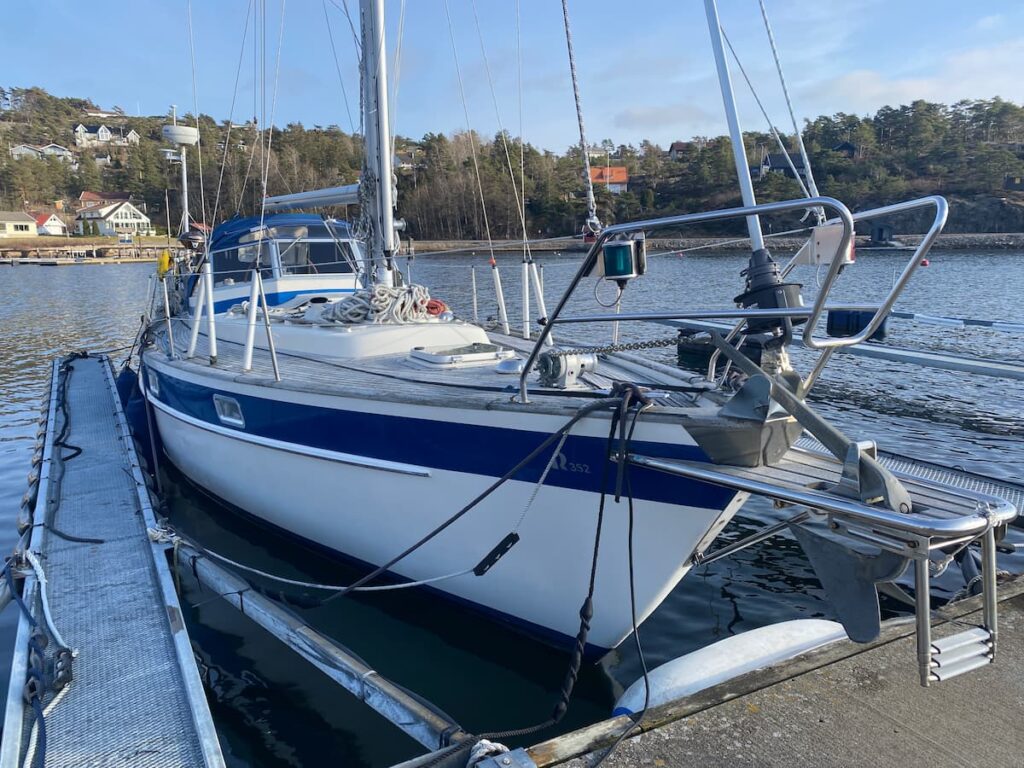
Cruising Sailboats
Cruising sailboats are designed for long-distance sailing and living aboard. They typically have a spacious interior with a galley, head, and sleeping quarters. They also have a large fuel and water capacity to allow for extended time at sea. Cruising sailboats come in many different sizes, from small pocket cruisers to large bluewater yachts.
Racing Sailboats
Racing sailboats are designed for speed and agility. They typically have a lightweight hull and a tall mast with a large sail area. Racing sailboats come in many classes , from dinghies to large offshore racing yachts. They are designed to be sailed by a skilled crew and require a high level of skill and experience to handle.
Daysailers are designed for short trips and day sailing. They typically have a simple interior with minimal accommodations. Daysailers come in many different sizes, from small dinghies to larger keelboats. They are easy to handle and are a great choice for beginners or for those who want to enjoy a day on the water without the hassle of a larger boat.
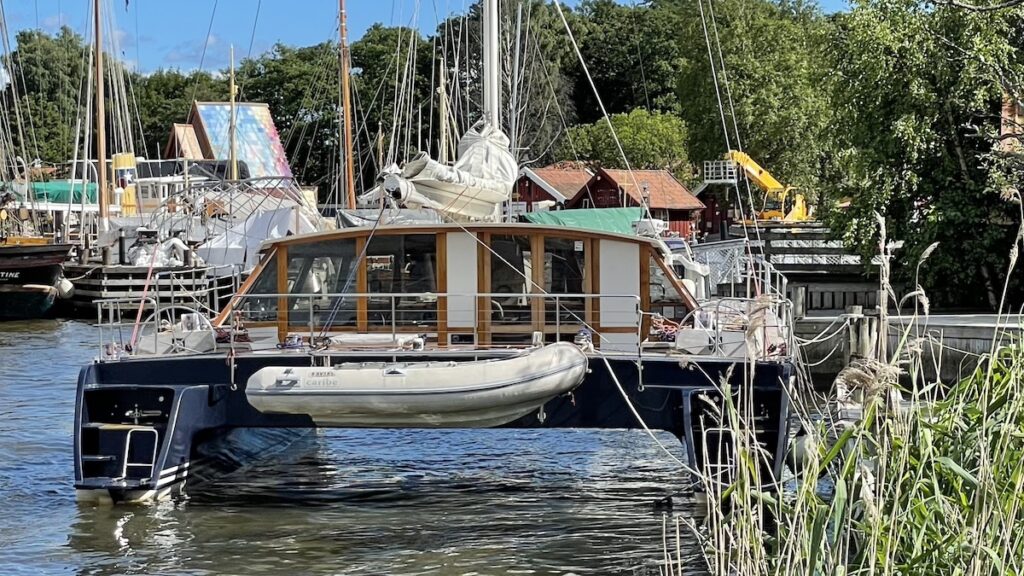
Catamarans are sailboats with two hulls. They are designed for stability and speed and are often used for cruising or racing. Catamarans have a spacious interior and a large deck area, making them a popular choice for those who want to live aboard or entertain guests. They are also popular for chartering and can be found in many popular sailing destinations around the world.
Trimarans are sailboats with three hulls. They are designed for speed and stability and are often used for racing or long-distance cruising. Trimarans have a narrow hull and a large sail area, making them incredibly fast and agile on the water. They are also popular for their spacious interior and large deck area, making them a great choice for those who want to live aboard or entertain guests.
Sailboat Hull Types
When it comes to sailboats, there are two main categories of hull types: monohull and multihull. Each has its unique characteristics and advantages.
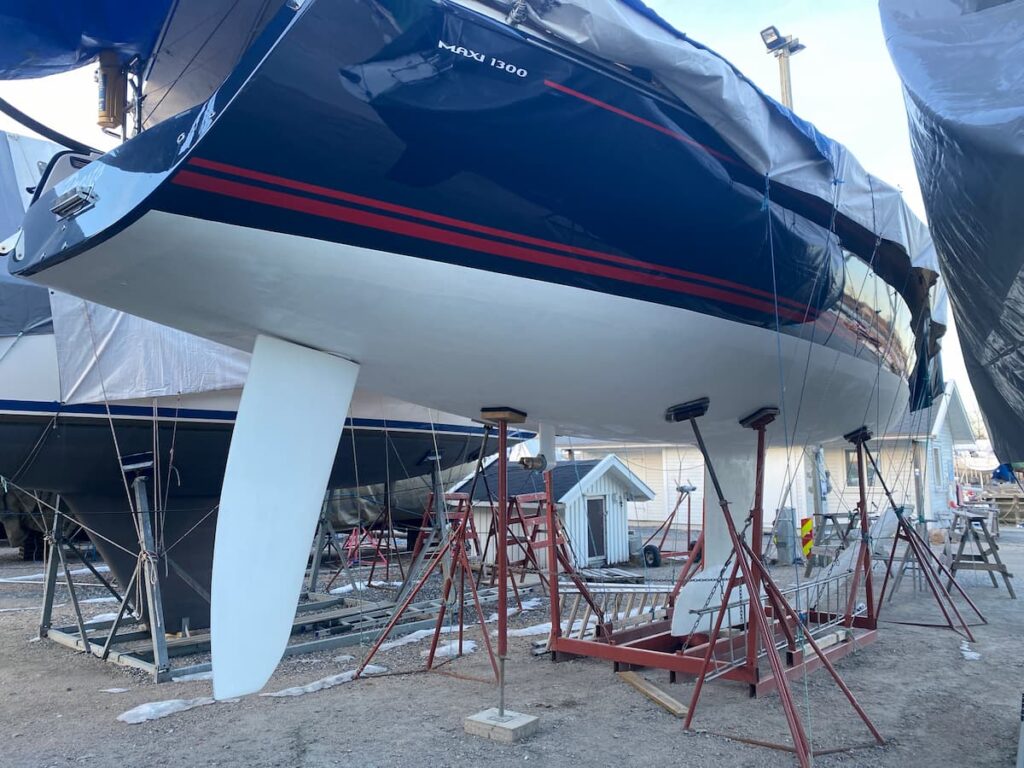
Monohull Sailboats
Monohull sailboats are the most common type of sailboat. They have a single hull, and the hull is typically long and narrow, which makes them more efficient when sailing upwind. Monohulls come in a variety of styles, including:
- Flat-bottom vessels
- Fin-keel racers
- Bulb and bilge keel cruisers
- Heavy semi-displacement sailboats
- Dense full-keel displacement cruisers
Each of these styles has its advantages and disadvantages. For example, flat-bottom vessels are the most stable, but they don’t work well in deep waters. Fin-keel racers are designed for speed and performance but may not be as comfortable for long-term cruising.
Multihull Sailboats
Multihull sailboats have two or more hulls. The most common types of multihulls are catamarans and trimarans. Multihulls have several advantages over monohulls, including:
- More stability
- Better performance in light winds
Catamarans have two hulls, which are connected by a deck. They are known for their stability and spaciousness. Trimarans have three hulls, which make them even more stable and faster than catamarans. However, they are not as spacious as catamarans.
Sailboat Rigging Types
When it comes to sailboat rigging types, there are several options to choose from. Each type of rig has its advantages and disadvantages, and choosing the right one will depend on a variety of factors, including the type of sailing you plan to do and the size of your boat . Some of the most common sailboat rigging types include:
The sloop rig is one of the most popular sailboat rigging types and is commonly used on boats ranging in size from small dinghies to large cruisers. It consists of a single mast with a mainsail and a jib or genoa. The mainsail is typically a triangular shape, while the jib or genoa is a smaller sail that is used to control the boat’s direction.
The cutter rig is similar to the sloop rig but with an additional headsail. This makes it a popular choice for sailors who want more control over their boat’s speed and direction. The mainsail is still triangular, but the headsail is typically smaller than the jib or genoa used in a sloop rig.
The ketch rig is a two-masted sailboat rigging type that is commonly used on larger boats. It consists of a main mast and a smaller mizzen mast located aft of the cockpit. The mainsail is typically triangular, while the mizzen sail is smaller and located behind the cockpit. The ketch rig is known for its versatility and is often used for long-distance cruising.
The yawl rig is similar to the ketch rig but with a smaller mizzen mast located further aft. This makes it a popular choice for sailors who want more control over their boat’s direction, especially in heavy winds. The yawl rig is also known for its ability to sail close to the wind, making it a popular choice for racing sailors.
Sailboat Sails
Several types of sails are commonly used on sailboats . Each sail has a specific purpose and is designed to work in different wind conditions. The main types of sails include mainsails, jibs, genoas, and spinnakers.
The mainsail is the largest sail on a sailboat and is typically located behind the mast. It is attached to the mast and boom and is used to capture the wind and propel the boat forward. The mainsail is the most important sail on the boat and is used in a wide range of wind conditions.
The mainsail can be adjusted in several ways to optimize its performance. The sail can be reefed, or reduced in size, to reduce the amount of sail exposed to the wind in high winds. The sail can also be twisted to adjust the shape of the sail and improve its performance in different wind conditions.
The jib is a smaller sail that is located in front of the mast. It is attached to the mast and forestay and is used to help balance the boat and improve its performance in light wind conditions. The jib is typically used in conjunction with the mainsail and can be adjusted to optimize its performance.
There are several types of jibs, including the working jib, the genoa jib, and the storm jib. The working jib is the most common type of jib and is used in moderate wind conditions. The genoa jib is a larger jib that is used in light wind conditions, while the storm jib is a smaller jib that is used in high wind conditions.
The genoa is a large jib that is used in light wind conditions. It is similar to the jib but is larger and overlaps the mainsail. The Genoa is attached to the mast and forestay and is used to capture as much wind as possible to propel the boat forward.
The Genoa is typically used in conjunction with the mainsail and can be adjusted to optimize its performance. It can be furled, or rolled up when not in use to reduce wind resistance and improve the boat’s performance.
The spinnaker is a large, balloon-shaped sail that is used for downwind sailing. It is typically used in light wind conditions and is attached to a spinnaker pole to keep it away from the boat’s mast and sails.
The spinnaker is used to capture as much wind as possible and propel the boat forward. It is typically used in conjunction with the mainsail and jib and can be adjusted to optimize its performance.

What factors determine the types of sailboats?
The factors that determine the types of sailboats include hull type, keel type, mast configuration, and sails and rigging.
What are the two main categories of sailboat hull types?
The two main categories of sailboat hull types are monohull and multihull.
What are some common sailboat rigging types?
Common sailboat rigging types include sloop rig, cutter rig, ketch rig, and yawl rig.
What are the main types of sails used on sailboats?
The main types of sails used on sailboats include mainsails, jibs, genoas, and spinnakers.
What are the differences between a catamaran and a trimaran?
A catamaran has two hulls connected by a deck, while a trimaran has three hulls. Trimarans are generally more stable and faster than catamarans, but they are not as spacious.
About the author
I worked as an officer in the deck department on various types of vessels, including oil and chemical tankers, LPG carriers, and even reefer and TSHD in the early years. Currently employed as Marine Surveyor carrying cargo, draft, bunker, and warranty survey.
Leave a Reply Cancel reply
Your email address will not be published. Required fields are marked *
Save my name, email, and website in this browser for the next time I comment.
Latest posts

Fiberglass vs. Steel: Which Is More Reliable?
Shipping professionals should get the most from their investment, so which is more reliable: steel vs. fiberglass? Here’s how to determine the better option.

What Does a Longshoreman Do?
Longshoremen play a critical role in the global supply chain, bringing billions worth of cargo into the country. So what does a longshoreman do exactly?
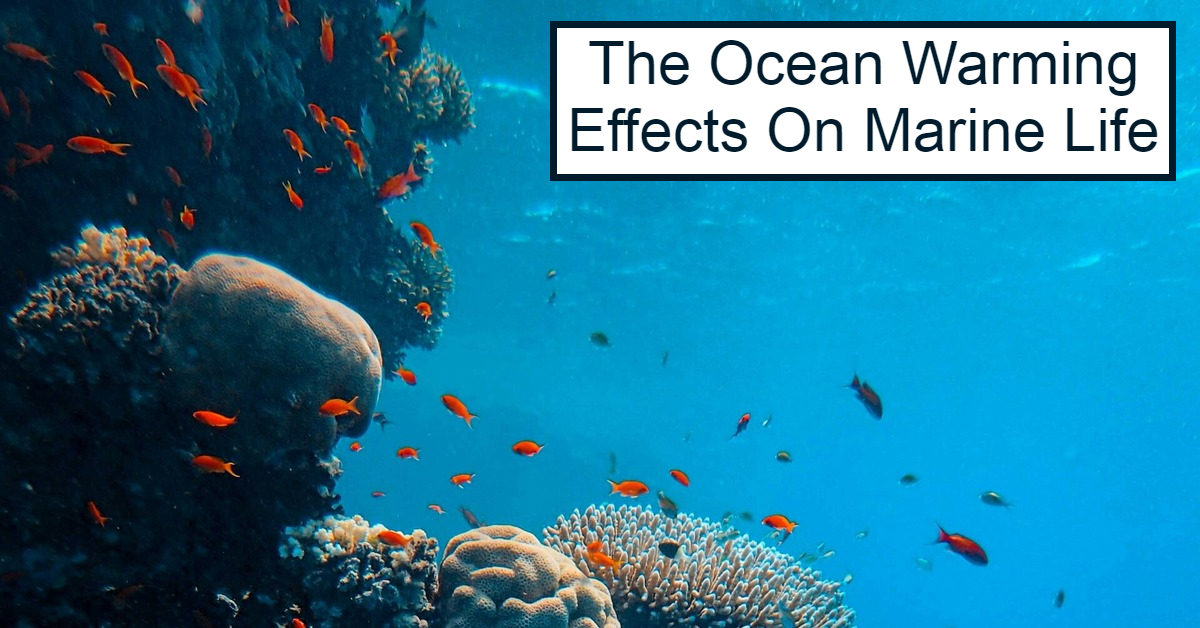
The Ocean Warming Effects on Marine Life
The last few decades have seen ocean temperatures rise as climate change begins to affect maritime industries worldwide. Here are the ocean warming effects on marine life seen so far.

The Definitive Guide to Sailboat Hull Types
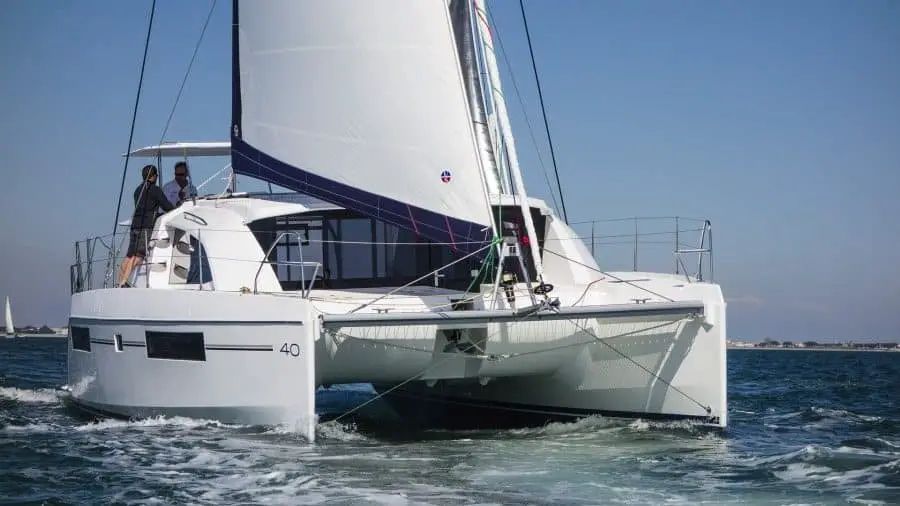
If you’ve ever been on a sailboat or any kind of boat, one of the first parts of the boat you saw was its hull and you might not have even known it.
Simply put, the hull is the bottom part of a boat that rides in and on top of the water. When a sailboat is underwater, it’s accompanied by the keel and the rudder.
Just like knowing the different types of sails , knowing the hull type on your sailboat means you’ll have a better understanding of how your boat operates while it’s out on the water.
All in all, the hull of any boat is meant to keep the boat afloat and to ensure minimum resistance against the water while being propelled forward. Now let’s dive into the different sailboat hull types and even some other types of hulls in boats in general!
Main Sailboat Hull Types
There are two main hull types that we’ll be looking at that encompass the many other types of hulls that vary from these two main types.
Depending on the type of boat you have, you’ll be floating around with one or the other. We’ll take a look at what you can expect if your boat has either of these hull types.
Displacement Hulls
The most common sailboat hull type you’ll find out there is the displacement hull, which is very effective at pushing the water aside and powering through it during forward propulsion.
A displacement hull is often found not only on sailboats, but also fishing, freight, cruise, and other larger boats.
All boats that have a displacement hull will be limited in their speed based on the waterline length of the hull. Regardless of how much power you use, whether it’s from the wind or motor, the maximum speed can’t be increased.
This is why you’ll see people mention the waterline length of a boat’s hull when putting them on the market to sell.
The big advantage of having a displacement hull is that they require far less power to get moving across the water compared to the other main hull type; the planing hull.
What this means is that your boat will be able to cruise for a long time with the same amount of energy, which also allows you to carry more items on board.
Planing Hulls
It’s almost guaranteed that your sailboat won’t have a planing hull since they’re most commonly found on powerboats and personal watercrafts (PWCs), like jet skis.
Planing hulls allow the boat to lift itself out of the water, reducing drag and increasing the speed of the boat.
Almost any boat that’s equipped with a planing hull will be able to attain a speed much greater than a boat with a displacement boat.
The main reason for this is the lift that’s produced when traveling at high speeds which reduces drag on the water.
The maximum speed of a boat with a planing hull is dependent on the horsepower of the engine and how much of the hull can be removed from the water while still cruising.
The biggest advantage of having a planing hull is that your boat will be able to pick up speed quickly and reach a greater maximum speed.
This allows for shorter journey times. However, there needs to be a source of all that energy, which comes directly from a combustion engine. The faster a boat with a planing hull goes, the larger the cost of fuel will be.
How Planing Works
The way planing works is actually pretty interesting, so I thought I’d dive into it a bit. Even though a sailboat is virtually guaranteed not to have one, it’s always nice to know how other boats operate while out on the water.
1. Displacement
Before a boat with a planing hull actually planes, it starts out acting like a displacement hull.
As a matter of fact, a boat with a planing hull needs to reach a certain speed before it starts to produce lift. Before that happens, it’s essentially a displacement hull.
While a boat with a planing hull is picking up speed and lifting itself out of the water, it’s in a plowing mode.
You’ll know when a boat is in plowing mode when the bow of the boat is elevated and the boat is throwing a relatively large wake. The goal, however, is to move from plowing mode to planing mode, which requires further acceleration.
Once the boat with a planing hull reaches a certain speed, it’ll leave plowing mode and enter planing mode.
As I already described, planing is when the hull is gliding across the water with a smaller amount of the hull dragging in the water when compared to the previous modes. Different boats will start planing when reaching different speeds.
Common Sailboat Hull Styles
Now that we’ve gone over the two main types of hulls you’ll find in sailboats and other types of boats, we have a good foundation for the hull styles you’ll commonly see when out on the water.
There are three main hull styles that you’ll see quite often, so let’s take a look at those.
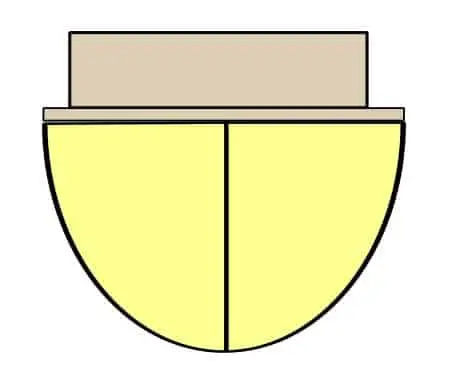
By far the most common hull style you’ll see on sailboats is the monohull, which is simply a single hull.
Traditionally, a sailboat will have a monohull and they can be found all over the place. It’s probably the style of hull that comes to most peoples’ mind when imagining a sailboat.
Monohulls on sailboats are virtually all displacement hulls. As we went over previously, this allows your sailboat to cruise for long stretches and has a greater efficiency compared to planing hulls.
However, most boats that exist on planet earth are monohulls, including powerboats, which can also be of the planing hull type.
When it comes to a monohull on a sailboat, the only way it can keep its stability is to have a proper keel attached to it.
A keel is a wing-like object that sticks out of the bottom of the hull in the water and provides a sailboat with ballast for stability. It’s important to understand how a keel works when operating a sailboat with a monohull since it’s one of the main reasons a sailboat can move forward without tipping.
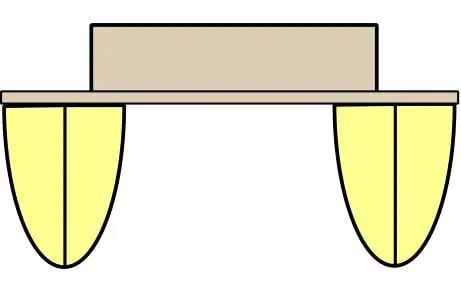
There are certainly a lot of monohull sailboats out there, but there’s no doubt that you’ll also see your fair share of catamarans.
Catamarans are sailboats with two hulls and operate quite differently than their monohull cousin. Catamarans are known to be fast and are likely to outrun most monohull sailboats.
Unlike monohull sailboats, catamarans can be fitted with displacement hulls as well as planing hulls. However, even if they have a planing hull they can still produce a relatively good amount of cruising time and do so rather efficiently.
Catamarans are a bit different than monohulls in the sense that they can reach greater speeds. There are several reasons for this. For one, a catamaran doesn’t need a ballast for stability since the broad stance between the two hulls provides enough stability.
This means there’s no need for a large, heavy keel. Second, they’re often built out of lightweight materials that allow the boat to reach a higher maximum speed compared to heavier sailboats.
Also, if a catamaran has a planing hull, it’ll have the ability to produce lift resulting in reduced drag on the water and even greater speeds.
Unfortunately, catamarans do have the disadvantage of being more likely to capsize in unwanted high-wind situations.
Also, it’s very difficult for a catamaran to recover from capsizing as opposed to a monohull sailboat that has a good ballast from its keel.
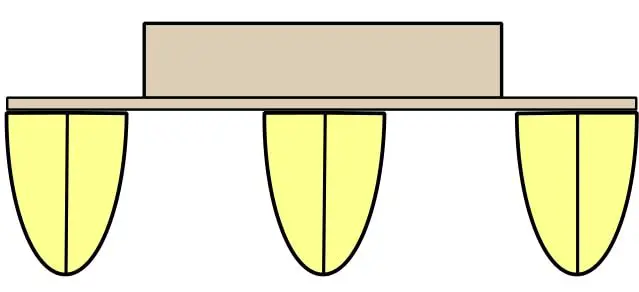
You might have already guessed from the name, but I’ll state the obvious anyway. A trimaran is exactly like a catamaran but with three hulls instead of two.
Often times you’ll see a trimaran look like a monohull sailboat with a pair of hulls attached to its side.
Similar to a catamaran, trimarans can hit speeds much greater than your average monohull sailboat. As a matter of fact, they’re known to be “unsinkable” under the situation that the hulls on the port and starboard side of the central hull are completely filled up with water.
One of the coolest aspects of having a trimaran is that when it has a planing hull and/or a hydrofoil, the trimaran’s central hull will lift completely out of the water.
This gives it the effect that it’s floating across the air, which is the result of lift produced from the planing hull or a hydrofoil. It’s very cool to see this!
Sailboat Hull Bottoms
Apart from the main boat hull styles, like the monohull, catamaran, and trimaran, there are hull bottoms that pop up in the world of boating that can differ in style and function.
These hull bottoms are more of a deeper look at the hulls of a monohull, catamaran, or trimaran, so you can think of them more as a feature of any of the previously mentioned styles of hull.
Flat Bottom
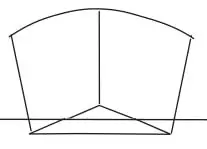
A very common hull bottom for boats that are derived from the planing hull type is a flat bottom hull.
The flat bottom hull is considered to be one of the less stable styles of hulls, especially when confronted with rough waters.
However, you’ll often find them on boats that don’t necessarily ride in these situations, including fishing or taxi areas.
- Good for small lakes and rivers due to having a shallow draft.
- Able to hit relatively high speeds once entering planing mode.
Disadvantages
- Not good at handling choppy waters resulting in a rough ride.
Round Bottom
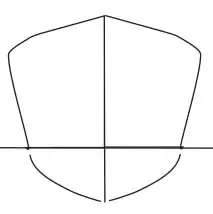
When it comes to sailboats, you’re most likely going to run into monohull sailboats that have a displacement style hull with a round bottom.
While these are the most common hull bottom for sailboats, they can also be found on smaller boats that are used for fishing, canoeing, and other similar kinds of boats.
- Easily moves through the water due to being a displacement hull type.
- When accompanied by a keel, it produces a great amount of stability from the ballast.
- Without a keel, it can roll when entering and exiting the boat as well as when waves are present.
- Less maneuverable compared to other hull styles.
Deep ‘V’ Bottom
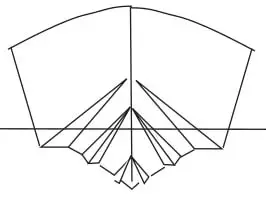
If you’re operating a powerboat, then in all likeliness your boat has a planing hull with a deep ‘V’ bottom.
Since deep ‘V’ bottoms are found on planing hulls, these types of boats will be able to pick up speed quickly and at high maximums. This is the most common setup for powerboats out on the water.
This is the most common type of powerboat hull. This hull type allows boats to move through rough water at higher speeds and they provide a smoother ride than other hull types.
- Provides a smooth ride compared to its flat bottom rival.
- Good at handling rough water.
- Requires more power to plane compared to its flat bottom rival.
- Cannot handle sharp turns very well resulting in potential rolling or banking.
Multi-Chine Bottom
We took a good look at multi-hull styles like the catamaran and the trimaran earlier, which are the exact style of hulls that have a multi-chine bottom.
A multi-chine bottom is a great example of a displacement hull on either a catamaran or trimaran as it’s the most common bottom you’ll find.
- In a multi-hull boat, it has a great amount of stability due to its wide beam.
- In a multi-hull boat, it needs a large area when either tacking or jibing.
Main Parts of a Sailboat Hull
There’s some terminology I threw around while describing the many types of hulls a sailboat and other types of boats have.
As is the case with a lot of activities, learning the terminology is just something you have to do.
Thankfully, the terminology will eventually sink in overtime and eventually you’ll be able to ring off any hull terminology that comes up.
The bow is simply the most forward part of a sailboat and, thus, the very front of the hull.
The stern, conversely to the bow, is the most backward part of a sailboat and, thus, the very end of the hull.
The port side of a hull is the left side. I always remember this with the phrase “I left my port on the table”, with the port being wine.
This just so happens to also be the side where boats will have a red light turned on at night, which is the color of port wine.
The starboard side of a hull is on the right side.
Opposite the port side, in the evening boats will have a green light turned on and will be located on the starboard side of the boat.
Fore is a sailor’s way of saying “forward”.
Aft is a sailor’s way of saying “back”.
A transom is the aft-most (see what I did there?) section of the boat that connects the port and starboard sections of the boat.
The flare of a hull is where the hull starts to form a large angle the closer the hull gets to the deck.
The waterline is the line around the hull where the water touches when under a normal load.
Waterline Length
The waterline length, once referred to as the Load Waterline Length (LWL), is the length of the hull where the waterline is located.
This is not the entire length of the boat.
Length Overall (LOA)
The length overall (LOA) is, you guessed it, the overall length of the boat. This is measured from the tip of the bow to the end of the stern.
The freeboard is the space on the hull of a boat above the waterline and below the deck.
The draft is the length from the bottom-most part of a boat (the tip of the keel on a sailboat) and the waterline.
Get the very best sailing stuff straight to your inbox
Nomadic sailing.
At Nomadic Sailing, we're all about helping the community learn all there is to know about sailing. From learning how to sail to popular and lesser-known destinations to essential sailing gear and more.
Quick Links
Business address.
1200 Fourth Street #1141 Key West, FL 33040 United States
Copyright © 2024 Nomadic Sailing. All rights reserved. Nomadic Sailing is a participant in the Amazon Services LLC Associates Program, an affiliate advertising program designed to provide a means to earn fees by linking to Amazon.com and affiliated sites.
Better Sailing

Sailboat Vs Yacht: What is The Difference?
Many boaters use the terms “sailboat” and “yacht” interchangeably when they are actually quite distinct. A yacht is a larger boat or ship that is used for recreational purposes. The term “yacht” is of Dutch origin, and it was initially described as a small, swift sailing vessel used by the Dutch navy to track down and catch pirates. A boat, on the other hand, is a smaller vessel that can range from a fishing boat to a sailboat in size. So, if you’re interested in this topic, this article will compare yachting with sailing in many ways. Like this, you will have a much better understanding of which option is best for you. Keep reading!
Sailboats and Yachts: Meaning
Firstly, it’s important to understand the meaning of each word. Generally, a boat is a form of watercraft that comes in a variety of shapes and sizes. A boat is a watercraft that is small enough to fit on a ship, which is typically less than 1,000 feet long. A ship is a huge vessel with a large carrying capacity that can transport other vessels. The size, shape, and capacity of a boat vary depending on its intended usage. Boats are most commonly employed for navigating places along the water’s edge or inland waterways like lakes and rivers, although they can be utilized on any water source. Boats can be used for a variety of purposes, including providing service to people and vessels on the water, recreational activities, commercial passenger, and cargo transportation across waterways.
So, a sailboat (sailing vessel) is a boat that is propelled primarily by the force of the wind on sails. Keep in mind that the term “boat” can cause some misconceptions about the vessel’s size. People may refer to it as a sailing ship rather than a sailing boat once it reaches a particular size. Also, boats are generally thought to be smaller than ships. A sailboat is a water-borne watercraft whose principal means of propulsion is the wind, which is captured and controlled by triangular-shaped pieces of cloth known as ‘sails.’ On the other hand, a powerboat is a watercraft with an internal combustion engine as its primary source of propulsion.
A yacht is most likely a vessel that is primarily used for personal rather than business purposes. There are yachts that you can hire for a week or more. This might add a little confusion as they are commercially owned but within the hire period, they are used by individuals for leisure purposes. Generally, people usually refer to sailboats as yachts or vice-versa. This is a common phenomenon nowadays, however, there are significantly more sailing yachts than motor yachts at the seaside/marina. If you want to specify a boat that is not largely powered by the wind, use the word motor yacht.
Sailing yachts and motor-powered yachts are the two forms of yachts available today. Yachts range in length from 26 feet to hundreds of feet. A cabin cruiser, or just a cruiser, is a luxury vessel that is less than 39 feet long. A superyacht is typically above 70 feet long. So, what is the definition of a mega yacht? They usually exceed 150 feet in length, but there is no top limit! Note that the world’s largest boat is 728 feet long, or 222 meters.
Let’s now check the main differences between a sailboat and a yacht:
Sails and Motor
The boat may be powered purely by the wind or by one or more inboard or outboard motors, depending on the model. While some larger boats may have very massive engines to provide genuine speed on the water, most yacht engines are far less powerful. Yacht engines are substantially larger, can produce far more power – up to 800hp in some circumstances – and can go many further distances.
If you’re searching for a vessel that’s easier to operate, you could argue that a yacht is a superior option. Sure, the computer components are more complicated, and there is more to manage, but sailing will be simpler. In stormy weather, managing a sail can be tricky. From inside the cabin, you can’t manage your sails. You may, however, operate your yacht from the cabin.
It’s a fact that sailboats will always have sails. After all, it’s their primary source of propulsion. The nail is what propels the boat forward by harnessing the wind. So long as the weather permits, sailing can be done anywhere, at any time. Yachting, on the other hand, has its own set of restrictions. A yacht will usually lack a sail, which can be viewed as a good or negative aspect, depending on your perspective.
The advantage of having a sail over only an engine is that you don’t have to worry about running out of fuel. Fuel is not only costly but also inconvenient and pollutes the environment. When on long voyages, you must always keep an eye on your fuel levels, or you risk breaking down at sea. The great thing with sailboats is that as long as there is wind, a sailboat can sail. If you have an extra sail onboard, you should be alright regardless of what occurs. You have a significantly lower chance of being left stranded at sea.
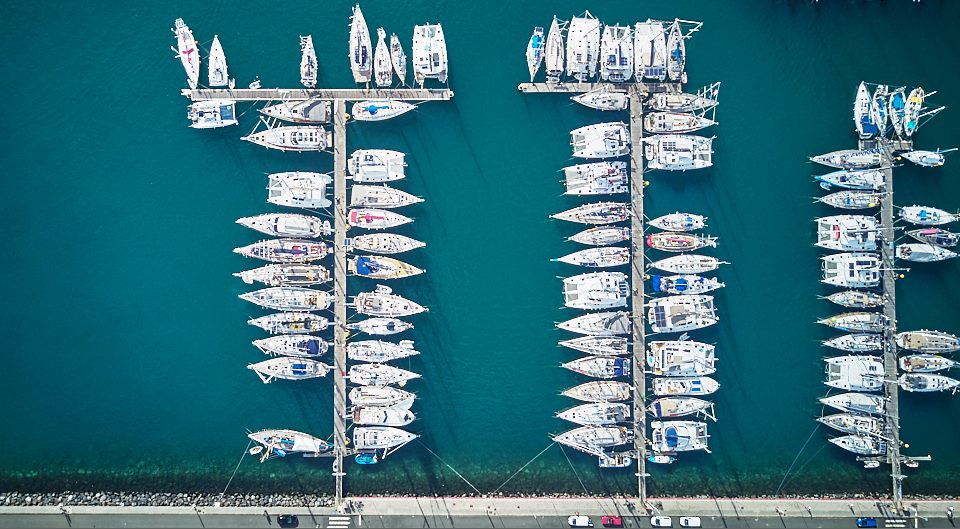
>>Also Read: Sailboats Vs Powerboats: Why Sailboats are Better
Size Matters
The size difference between a yacht and a sailboat is one of the most significant ones. Most of the time, a sailboat will almost certainly be smaller than a yacht. Of course, some sailboats are larger than others, but if we’re talking about average sizes, a yacht will be larger. The reason that size counts so much when deciding which boat to buy is that the available space is limited. So, if you opt for space note that the larger your boat is, the more space you’ll have. This may seem self-evident, but it is one of the most crucial aspects of your boat to which many people forget to give due consideration.
Generally, when it comes to boats, size will always matter. Except in cases where someone prefers overall better performance and speed. But, keep in mind that almost everything you do will be influenced by the size of your boat. The smaller the boat, the less storage space you have, the less space you have for emergency supplies, and even the less space you have for yourself. Regardless of the size of your boat, your sleeping quarters will most certainly be small. Also, depending on your height, every inch of a room may be crucial.
When there are more people on your boat than just you, size matters the most. If you intend to live alone on your yacht, you will have a significant space advantage. If there are three persons on board, you probably going to need more equipment and devices for cooking or for emergencies. All of this suggests that the sleeping space is the most significant distinction between living alone and living with people. If you live alone on a yacht that can sleep four people in theory, you will have a lot more storage and consequently space.
People on Board
The extent to which the crew will influence your decision is mostly determined by your budget and the size of the vessel you are considering buying. Meaning that if you’re intending to buy a sailboat, you won’t need any crew. Except for your family/friends that live on your boat with you, you basically are the entire crew. However, if you own a yacht, it’s an entirely different scenario.
If you intend to live aboard your yacht, you may require the assistance of one or two crew members. There will be plenty to do even if you are the most essential member of the team, i.e. the captain. This is because you might haven’t already mastered things like navigation, maintenance, plumbing, and engineering. So, a yacht often requires a complete crew to assist with navigation, maintenance, electronics and engineering, repairs, and sometimes even stewards to attend to the passengers.
In other words, having a sailboat means that you can take care of everything yourself. There are only a few computer components that will need to be repaired, and you are unlikely to have an engine. Repairing a sailboat isn’t easy in and of itself; it’s just easier for one person to handle. Meaning that it’s far easier to replace a sail than it is to fix an engine. In bad weather, a small sailboat is just easier to monitor than a large yacht. At the absolute least, another set of eyes will be probably required when sailing with a yacht.
Price also Matters
In general, yachts tend to be more expensive than sailboats. Occasionally, a great deal more. For a variety of factors, the most important of which are materials, design, and construction techniques. Note also that a boat’s price is likely to rise as it becomes more modern. Although this isn’t always the case, it is the vast majority of the time. If money is a key factor in deciding which boat to buy, here’s something to think about: just because a yacht is more expensive doesn’t mean you shouldn’t have one. If you have the cash, knowledge, and you know the kind of sailing you will be doing then go for a yacht!
Note also that a sailboat can be outfitted with a variety of amenities and conveniences. But, the sailboat doesn’t always include these features. This will mostly depend on the type of sailboat. As a result, buying a basic sailboat can save you a lot of money. However, most yachts will provide high end amenities. As a result, a motor yacht will cost significantly more than a regular sailboat. Sailboats are also smaller than yachts, which means you have a larger selection of less expensive boats to pick from when making your purchase. But, yachts often start in the six-figure range and can reach millions of dollars depending on the yacht’s size, age, and build quality.
Maintenance and Repairs
Yachts are frequently more expensive to maintain than sailboats. Meaning that boat engines require a great deal of upkeep, and the expense of fuel can be prohibitive for many individuals. For example, did you know that a gallon of diesel fuel in a yacht may only allow you to travel less than 1 nautical mile? If you’re going on a long voyage out to the sea, you can end up spending a lot of money on fuel. A sailboat, on the other hand, can take you wherever you want to go with very little fuel. Bear in mind also that a yacht’s insurance is more expensive than that of a sailboat. One of the main reasons is because it is classified as a yacht.
In addition to the boat’s price there are some other things to consider. The most important one is maintenance and repairs. A boat will always need these and it might need them once per month or once per year. It depends on the kind of repairs and on the way in which you “treat” your boat. Also, if you’re buying a used sailboat, you will need sometimes more research and more money for upgrades. It will be repainted, restored, and upgraded, although it will remain the same size. You should approach buying a boat in the same way that you would with a car. So, according to the size and kind of boat you want to buy, it’s important to keep in mind the price and extra costs as well.
While advanced marine electronics and navigation systems are available on some boats, they are more of a must for yachts. When doing transatlantic voyages, it is critical not only to be able to navigate with precision but also to be able to identify other boats or objects that you may not be able to see, as well as to comprehend your vessel’s performance.
When it comes to technology, it’s not just about whether you’re choosing a sailboat or a yacht. The age of the specific vessel is also something to consider. A sailboat that is more than ten years old may not be as technologically advanced as a brand new sailboat. Better technology can offer a lot of opportunities for you if you decide to buy a yacht. First and foremost, it can make working on your boat much more convenient. There’s no reason you couldn’t work remotely from your boat if you have the ability to set up a functional office with wifi.
Technology also brings up a lot of new possibilities for you when it comes to the act of sailing. A sailboat could traverse the Pacific or Atlantic, but it would be rather difficult. On the other hand, with a yacht, it can be a lot easier. In comparison to a sailboat, your yacht will have advanced navigational systems, warning and guidance systems, and many more safety features.
Sea, Lakes, or Rivers?
Bear in mind that in shallow waters, large yachts are unable to sail. A sailboat is a way to go if you plan on sailing in areas with shallow waters. In the Caribbean, for example, a yacht might be difficult to navigate. At the very least, it’ll be more difficult than sailing. A yacht, on the other hand, may travel to far more places than a sailboat.
A small sailboat might theoretically sail across the Atlantic. However, it can be quite risky, and your boat might not be able to withstand the strong winds and waves. Furthermore, if you’re aboard a sailboat, you can be the only one on board. This means that if the worst happens, far out at sea, there will be no one to aid you. You can do it, of course, but it is risky.
So, smaller boats may normally operate in calmer seas such as lakes, rivers, and shallow harbors. Larger boats, usually between 20 and 30 feet long, can equally navigate rougher ocean seas. A yacht, on the other hand, can sail in deeper ocean waters and handle more choppy seas. Yachts are significantly more ideal for lengthy ocean voyages due to their bigger size, high-tech electronics and guidance equipment, weather protection, and a variety of other characteristics.
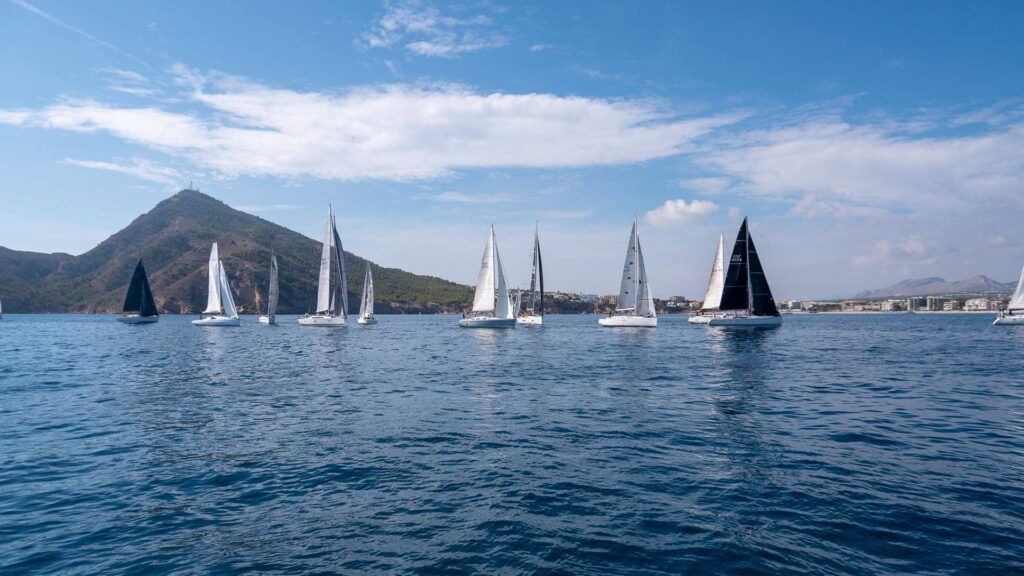
>>Also Read: Sailing Vs Boating: Why Sailing Is Better
Sailboat and Yatch Construction
Depending on the anticipated scale of production, sailboat makers can fabricate their own parts or order them. Masts, sails, engines, and metal fittings are common items provided by specialty vendors. Boatbuilders, on the other hand, create their own fiberglass hulls, using Gel coat polyester resin, a catalyst for the resin, woven fiberglass roving, and fiberglass. Wooden hull manufacturers create and shape their own wood in the same way. Note that the main building materials used in boat construction are aluminum, metal, wood, and fiberglass. The unique structure of each material offers a different design and usage as well as additional features to the way in which the boat is built.
Material considerations are important, whether they affect the cost or the durability of the product. Fiberglass, carbon fiber, and metals such as titanium will also be used to construct a boat. On the contrary, a sailboat will most likely be composed of wood or fiberglass. So, in case you value safety and sturdiness above all else, and money isn’t a big issue, a yacht will be significantly safer for you.
The material can also influence the way in which you make repairs. For instance, a wooden boat is much easier to repair than a metal boat. You can make some simple and quick repairs using wood, and they’ll probably last till you get to a marina. To do major repairs on a yacht, you’ll need a lot of specialized equipment and knowledge. Moreover, you may need to ask for a crew member to help you with this.

Sailboat Vs Yacht – Summary
As you can see there are many differences between a sailboat and a yacht. Nowadays many people tend to confuse or don’t be aware of the exact meaning and differences of these vessels, and it’s normal. But, we, as sailors, have to know the differences in order to understand which kind of boat is right for us. For example, if you want big spaces, luxury, or intend to liveaboard then you should opt for a yacht. But, if you want to experience the true joy of sailing, sail anywhere without worrying about polluting the environment or spending too much on fuel, then go for a sailboat! It will entirely depend on your needs and preferences so weigh the pros and cons of each one before making the decision.
In any case, I hope that you have now clarified the differences between these two and that you will make the right choice. I wish you all safe & enjoyable voyages!
Peter is the editor of Better Sailing. He has sailed for countless hours and has maintained his own boats and sailboats for years. After years of trial and error, he decided to start this website to share the knowledge.
Related Posts

Atlantic vs Pacific: Which is More Dangerous for Sailing?

The Ultimate Guide to Choosing the Best Fishing Line for Trolling

Lagoon Catamaran Review: Are Lagoon Catamarans Good?

Best Inboard Boat Engine Brands
- Buyer's Guide
- Destinations
- Maintenance
- Sailing Info
Hit enter to search or ESC to close.
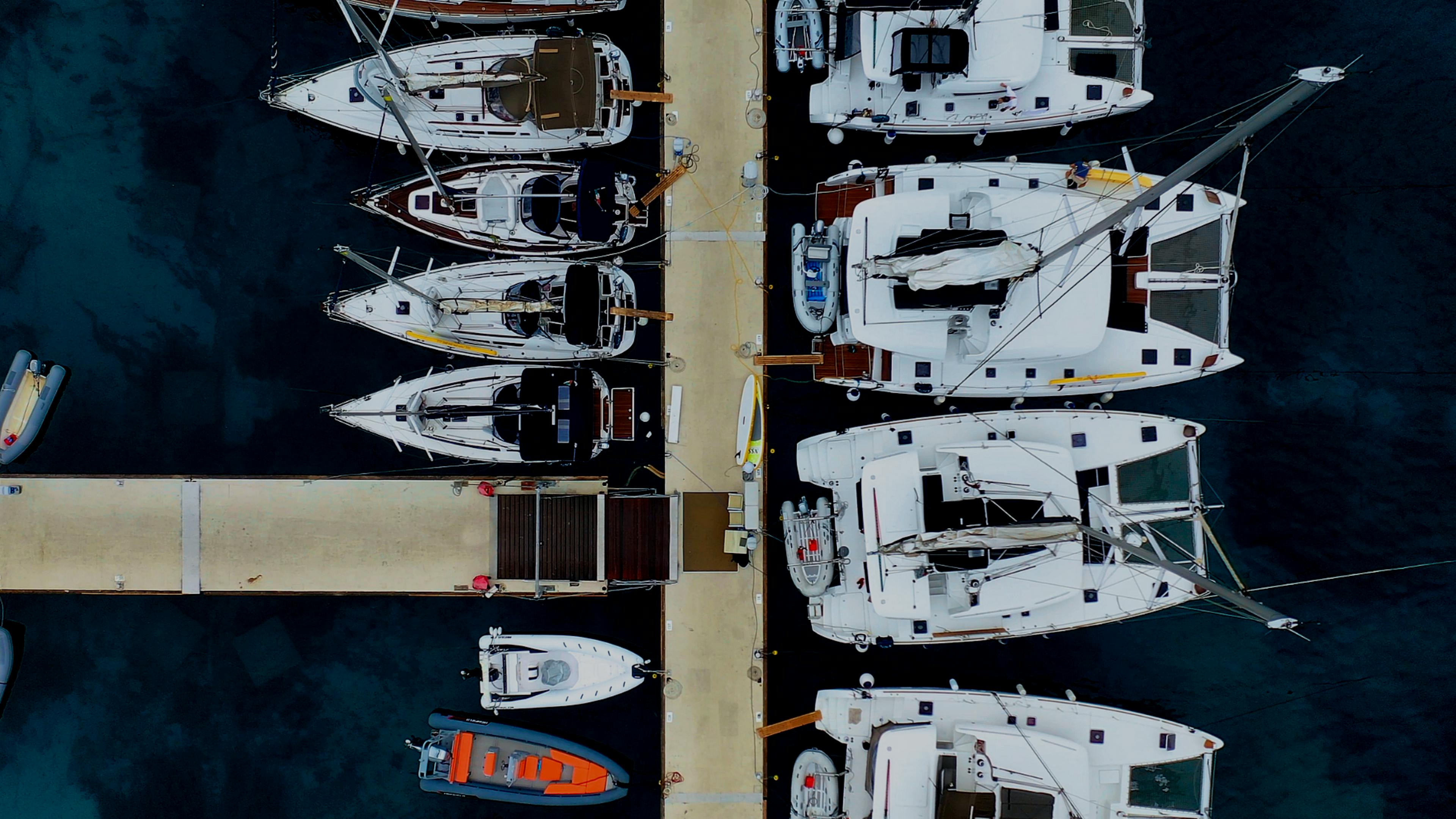
- What's the difference between a catamaran and a sailboat?
A comprehensive guide to help you choose the best boat for your next holiday
- Boat Models
Get ready to embark on a sea-faring adventure with us as we unveil the unique charms of catamarans and sailboats—the rockstars of luxury on the water. While we usually dive deep into the world of sailboats, we can't resist sharing the laid-back vibes and the comfort you'll find inside a catamaran.
By zooming in on the differences, we're handing you the ultimate tool to pick out the perfect yacht for your holiday. Ready to set sail? Let's navigate the cozy corners and sail smoothly through the captivating world of catamarans and sailboats. Your ideal yacht escapade is within reach, and understanding these nuances is the compass that will steer you toward the perfect maritime retreat. Cheers to smooth sailing!
Yacht Charter: Book your holiday with Sailogy!
➡️ sailboat rental, ➡️ catamaran rental, what is the difference between a catamaran and a sailboat sailogy comparison, can a catamaran sail rough seas, what is the difference between a sailing catamaran and a power catamaran, are catamarans faster than sailboats, are catamarans harder to sail.

Sailboat vs Catamaran Comparison
1. stability:.
- Sailboat: Embraces the classic elegance of a single hull, providing a responsive and traditional sailing experience. The tilting motion, counterbalanced by the daggerboard, adds a dynamic element to the journey.
- Catamaran: Boasts unparalleled stability with its two hulls, virtually eliminating the pronounced tilting effect. The absence of deep keels and ballasts enhances agility and lightness, offering a smoother ride. Ideal for those who are prone to experiencing a bit of seasickness!
- Catamaran: Defines spaciousness, providing individual cabins with dedicated bathrooms. The square-shaped dinette mirrors domestic proportions, and the substantial, well-equipped cockpit encourages social gatherings.
- Sailboat: Offers a cozy and intimate setting, utilizing space efficiently. While cabins may be more compact, the sailboat's design fosters a close-knit atmosphere among passengers.
- Catamaran: Impresses with a wide footprint, enhancing onboard living space and comfort. The challenge lies in marina space during peak seasons, offset by the freedom to enjoy extended periods aboard without the need for frequent shore visits.
- Sailboat: Navigates marinas with ease due to its narrower profile. While confined space might limit interior room, the sailboat's ability to find berths becomes advantageous during bustling harbor seasons. It's worth noting that this characteristic can vary depending on the model; for instance, new models such as the Bavaria C38 or the Dufour 44 (premiered in Düsseldorf and soon available) feature generous beams, providing more space, especially in the main front bedroom, and creating a general feeling of larger spaces, even on the deck.
4. All on the Same Level:
- Catamaran: Integrates the dinette and cockpit seamlessly, creating a harmonious, unified space with a transparent sliding wall. Visual continuity fosters a connected and inclusive experience among guests.
- Sailboat: Embraces a more compartmentalized layout, allowing for distinct areas that cater to different activities. This provides passengers with varied environments throughout the vessel.
5. Manoeuvrability:
- Catamaran: Exhibits impressive maneuverability, thanks to two engines that facilitate precise control in tight spaces. The ability to turn within its own axis is particularly advantageous in crowded harbors.
- Sailboat: Requires careful and deliberate maneuvering in harbors due to its single engine. While agility might be reduced, the sailboat's sailing capabilities shine when navigating open waters.
6. Speed and Sailing:
- Catamaran: Hydrodynamically efficient hulls offer superior speed, especially in upwind sailing conditions. The catamaran excels in providing a swift and enjoyable journey, minimizing the impact of adverse weather.
- Sailboat: Demonstrates versatility in sailing conditions, adapting well to upwind challenges. While not as inherently fast as a catamaran, the sailboat's overall speed ensures an engaging sailing experience.
7. Comfort on Board:
- Catamaran: Appeals to first-time sailors seeking a home-like experience. Offers disengaged and domestically oriented spaces, ensuring privacy between hulls—a valuable feature for those with varying daily routines or sailing with a skipper or children.
- Sailboat: Fosters a more communal atmosphere, ideal for passengers who enjoy close interaction. The sailboat's compact layout promotes shared experiences among travelers.
8. Autonomy:
- Catamaran: Slightly compromised autonomy due to weight sensitivity. Limited fuel independence and water reserves necessitate more thoughtful planning. The presence of two engines enhances maneuverability, allowing for precise navigation.
- Sailboat: Excels in fuel autonomy, providing extended sailing periods without the need for frequent refueling. A single-engine simplifies maintenance and promotes straightforward, self-sufficient voyages.
9. Organisation of Space:
- Catamaran: Typically designed with a standardized layout, catamarans for charter often feature two cabins in each hull, strategically positioned at the extreme bow and stern. This layout, with two bathrooms centrally located, offers a consistent and practical accommodation setup. Innovative models feature an exterior galley integrated into the cockpit, providing a unique blend of space and functionality.
- Sailboat: Boasting a more versatile structure, sailboats come in various layouts to cater to diverse preferences. Modern designs challenge traditional constraints with generous beams. This not only enhances interior space, especially in the main front bedroom but also creates a broader and more open atmosphere on the deck. The flexibility in cabin arrangements allows for a personalized and comfortable sailing experience, accommodating different preferences and needs. Ultimately, the organization of space on a sailboat is influenced by the specific model chosen, allowing for a tailored approach to onboard living.

Catamarans excel in rough seas, thanks to their twin-hull design providing enhanced stability and reduced heeling compared to monohull sailboats. The unique architecture allows for increased speed and maneuverability, making them efficient in navigating challenging conditions.
Key to their rough-sea capabilities is the bridge deck —the space between the hulls—featuring ample clearance in well-designed catamarans. This minimizes slamming, enhances seaworthiness by reducing structural stress, and ensures a smoother ride in turbulent sea states.
While catamarans can capsize in extreme situations, proper design, operation, and the skill of an experienced captain contribute to their overall capability in handling a variety of sea conditions, ensuring a secure and enjoyable sailing experience, even in rough seas.
A sailing catamaran and a power catamaran differ primarily in propulsion . A sailing catamaran relies on sails, offering a traditional experience with stability and efficiency. In contrast, a power catamaran uses engines, emphasizing speed and ease of handling. Power catamarans are chosen for faster cruising and covering more miles.
Catamarans are often considered faster than monohull sailboats due to their hydrodynamic design . With two hulls providing stability, reduced drag, and a wider beam for efficient sailing angles, catamarans excel in speed. However, sailboats showcase versatility, excelling in certain conditions such as upwind sailing. Overall speed comparison depends on various factors, including design and wind conditions.
Sailing a catamaran is often seen as less challenging for beginners due to inherent stability and reduced heeling. The dual-hull design provides balance, making catamarans forgiving in terms of capsizing. While novices appreciate stability, adjustments are needed for maneuvering and handling increased windage. Proficiency comes with practice, and experienced sailors may find catamarans offer a refreshing change in sailing dynamics.

Discover our favorite yachts
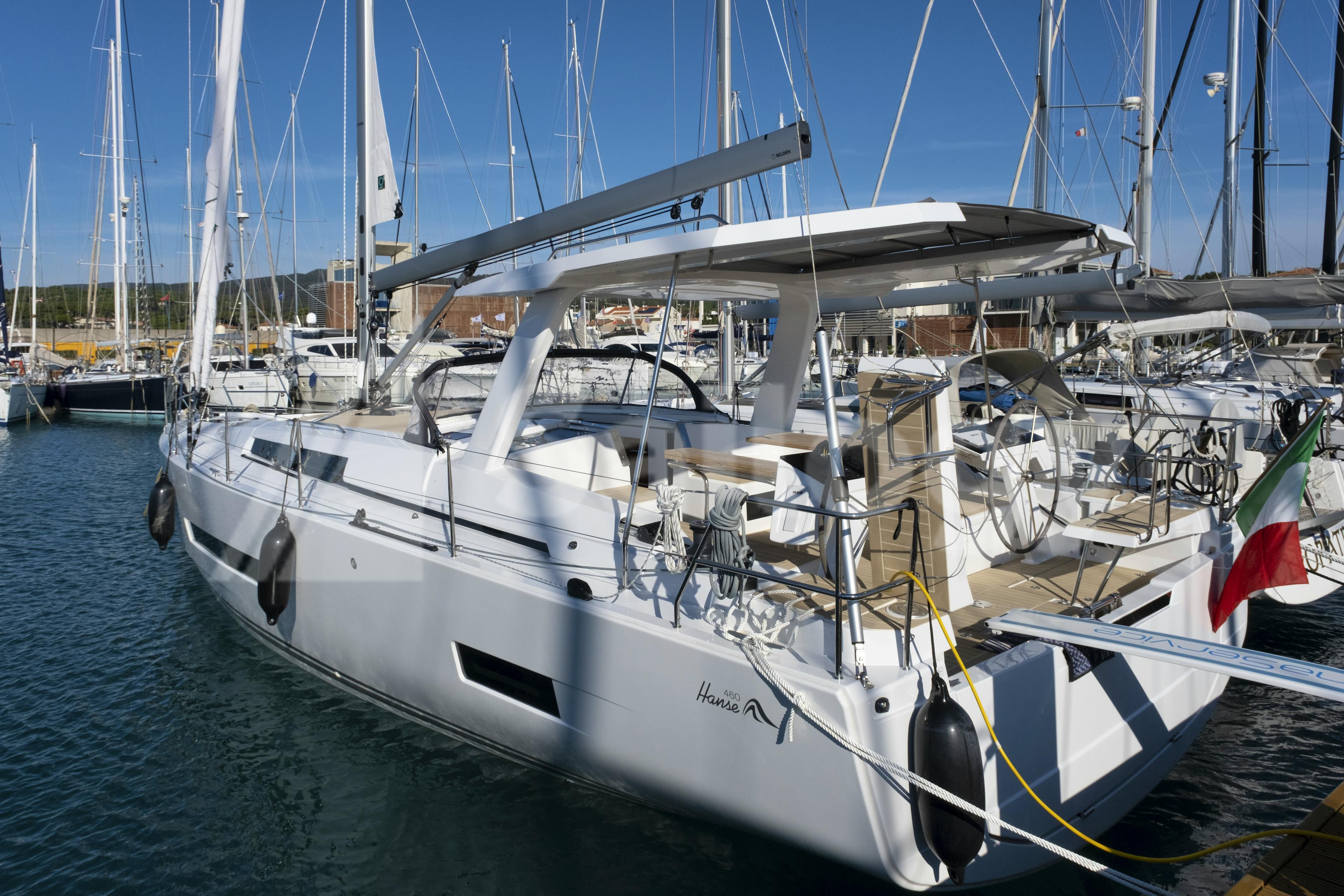
- Sailing boat
Castiglioncello, Tuscany
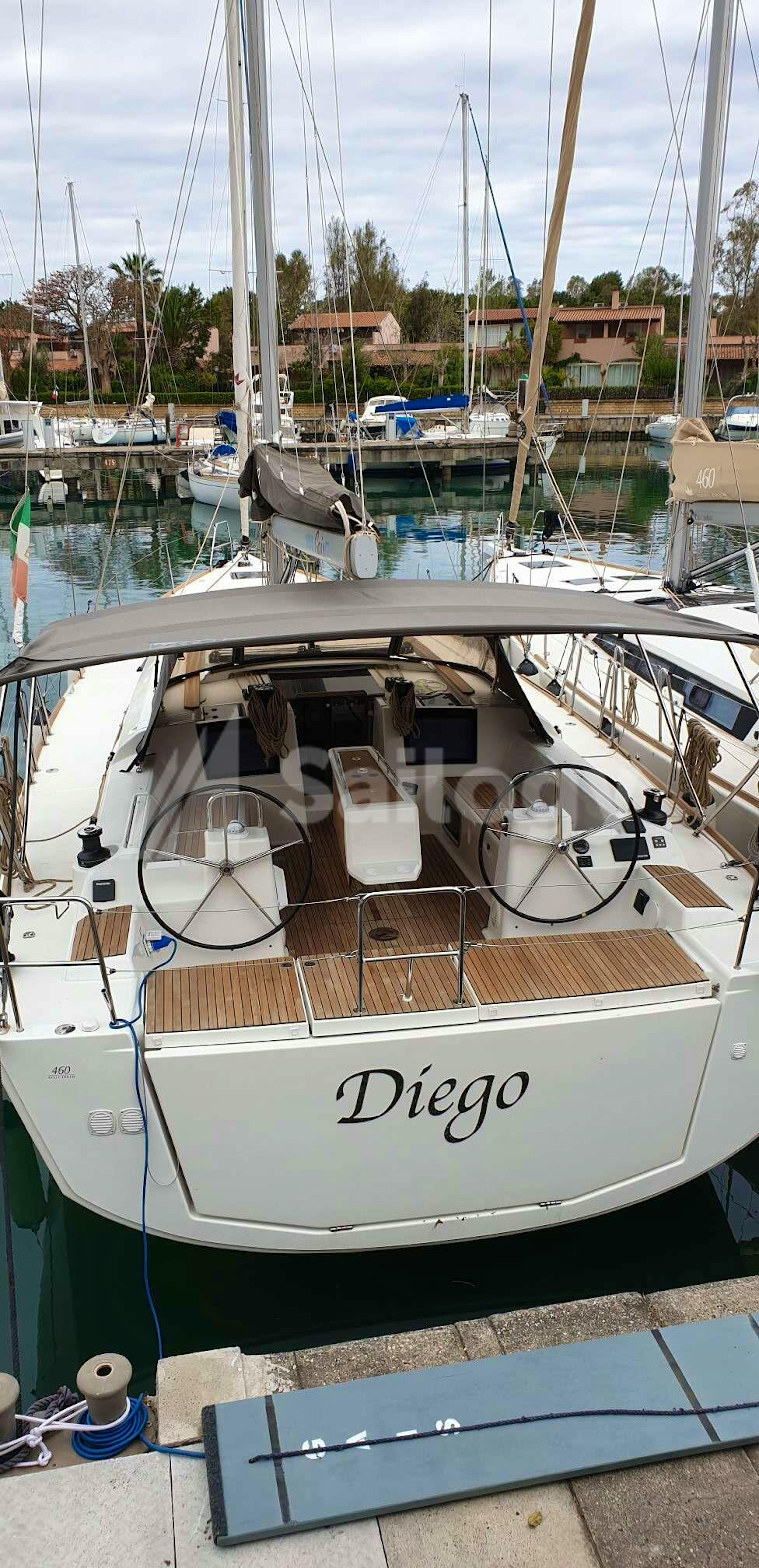
Dufour 460 Grand Large
Portorosa, aeolian islands.
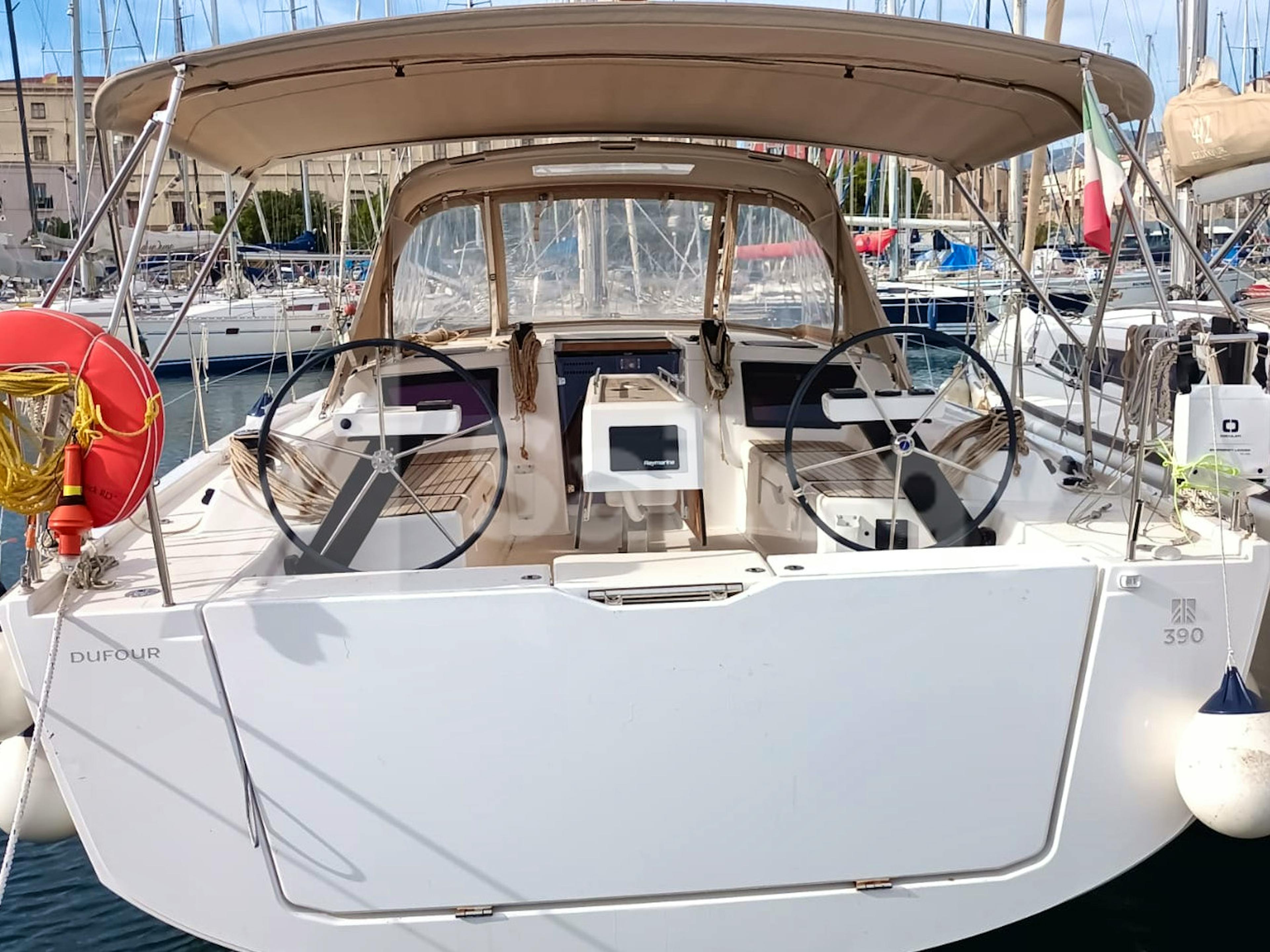
Dufour 390 Grand Large
Palermo, sicily.
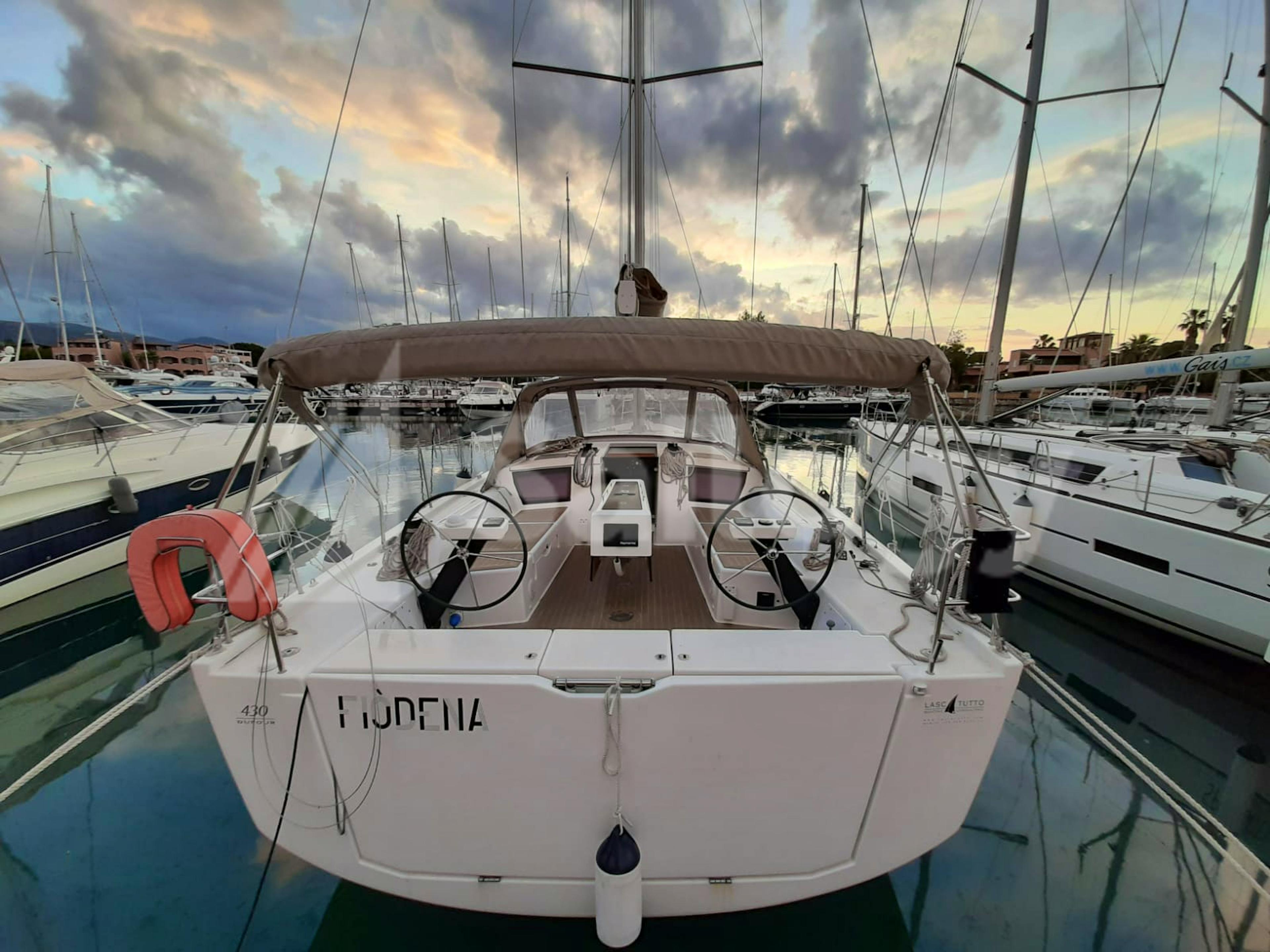
Dufour 430 Grand Large
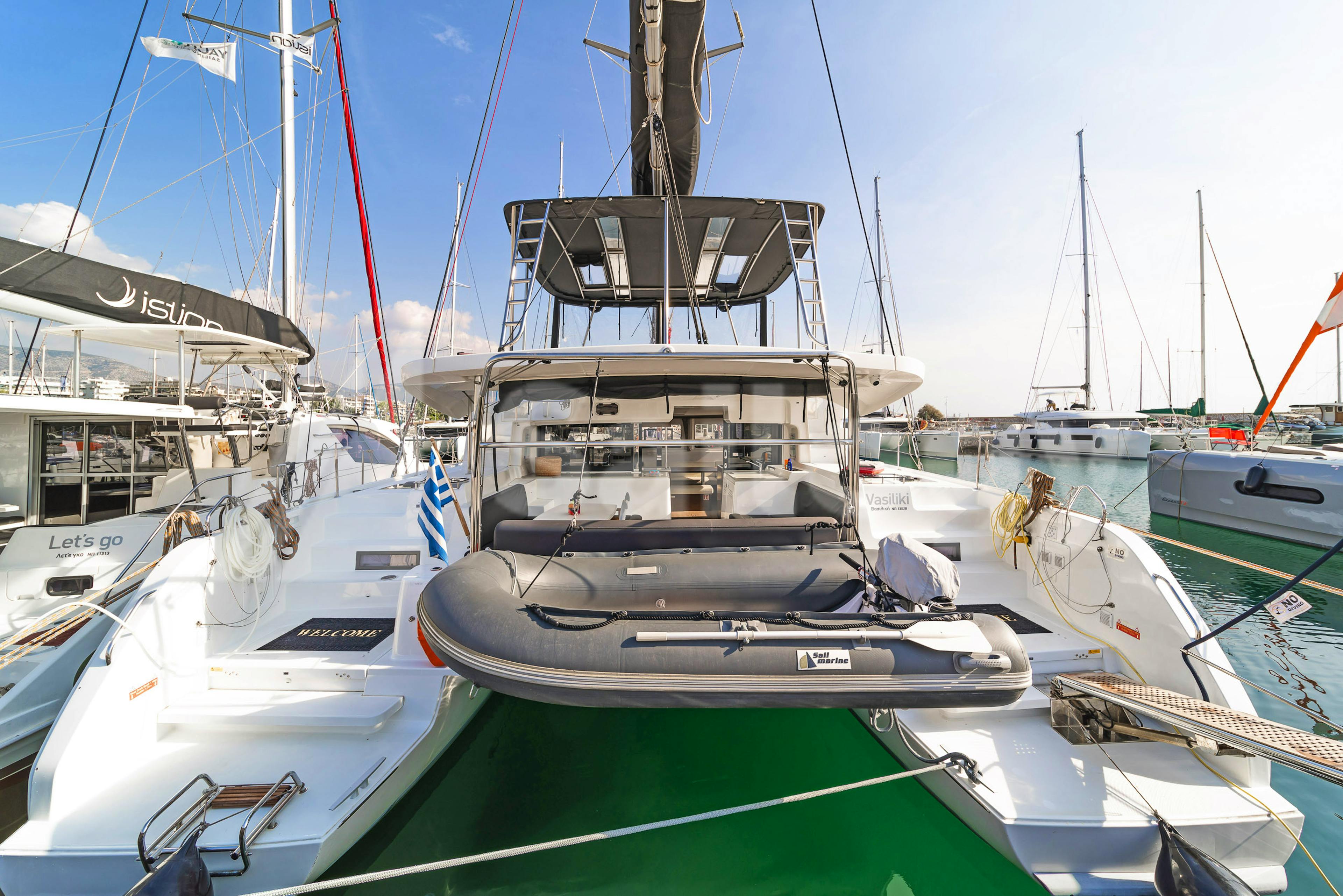
Kalamaki, Athens
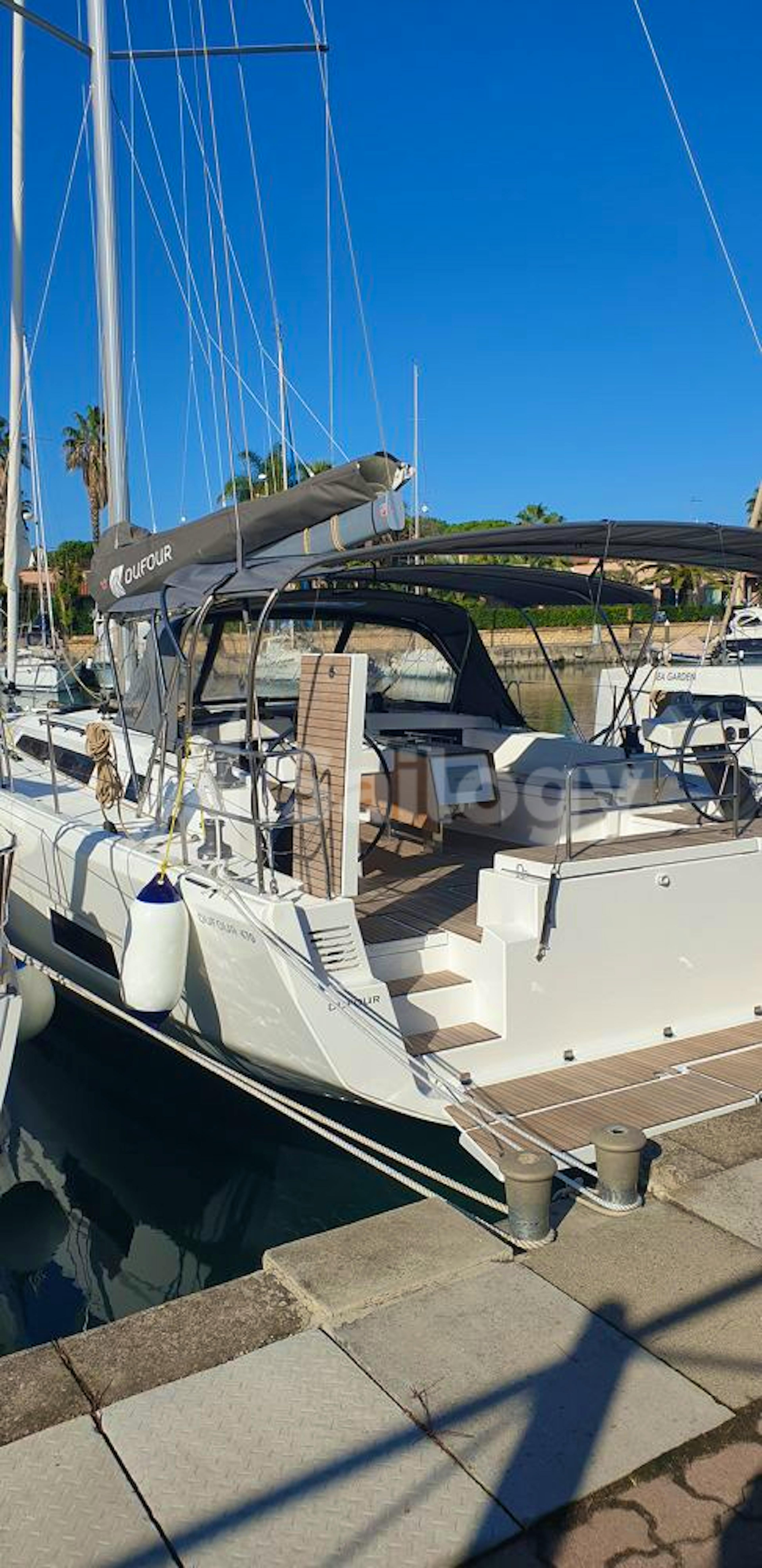
Kastela, Dalmatia
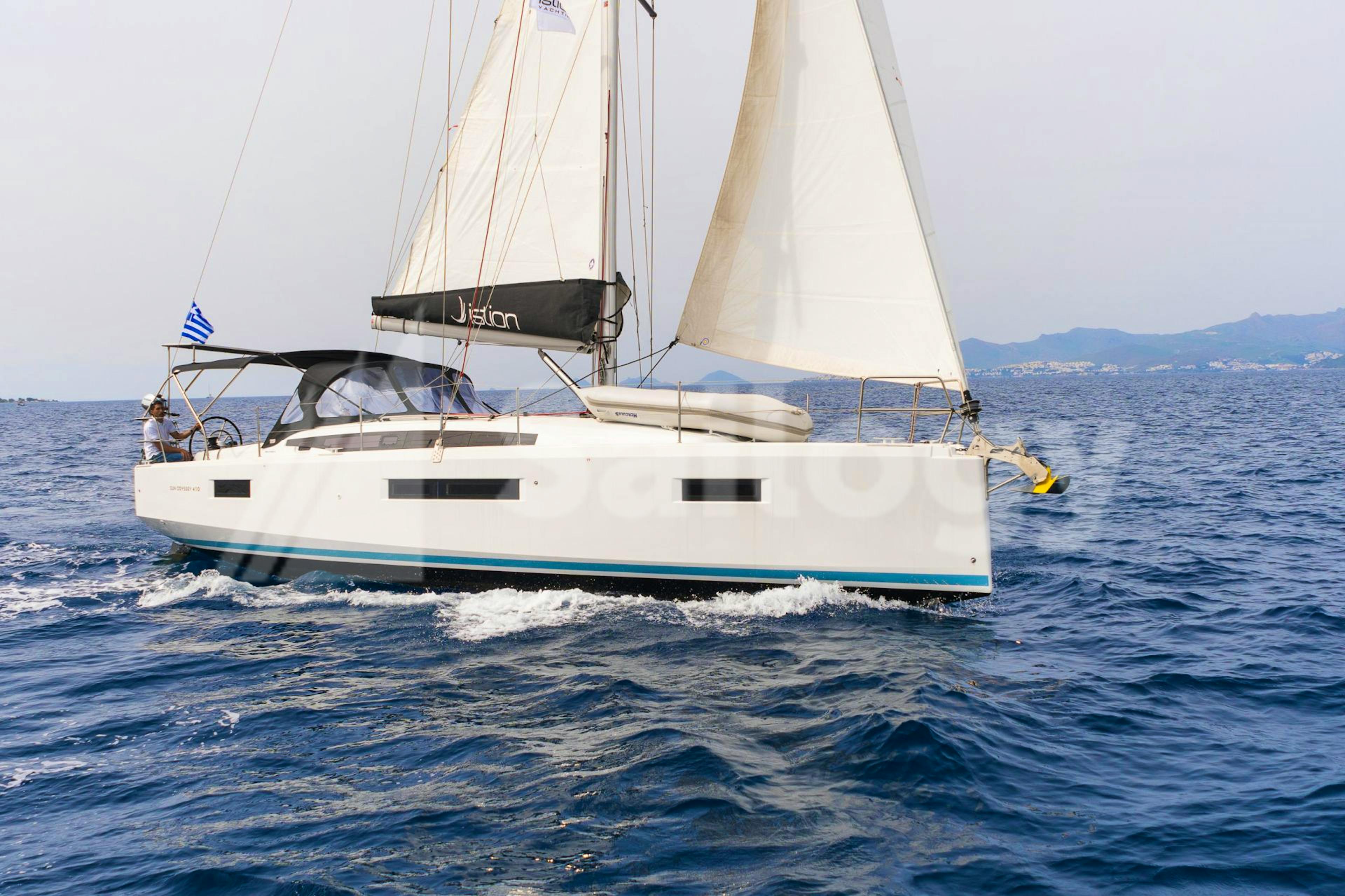
Jeanneau Sun Odyssey 410
Skiathos, sporades, other articles.
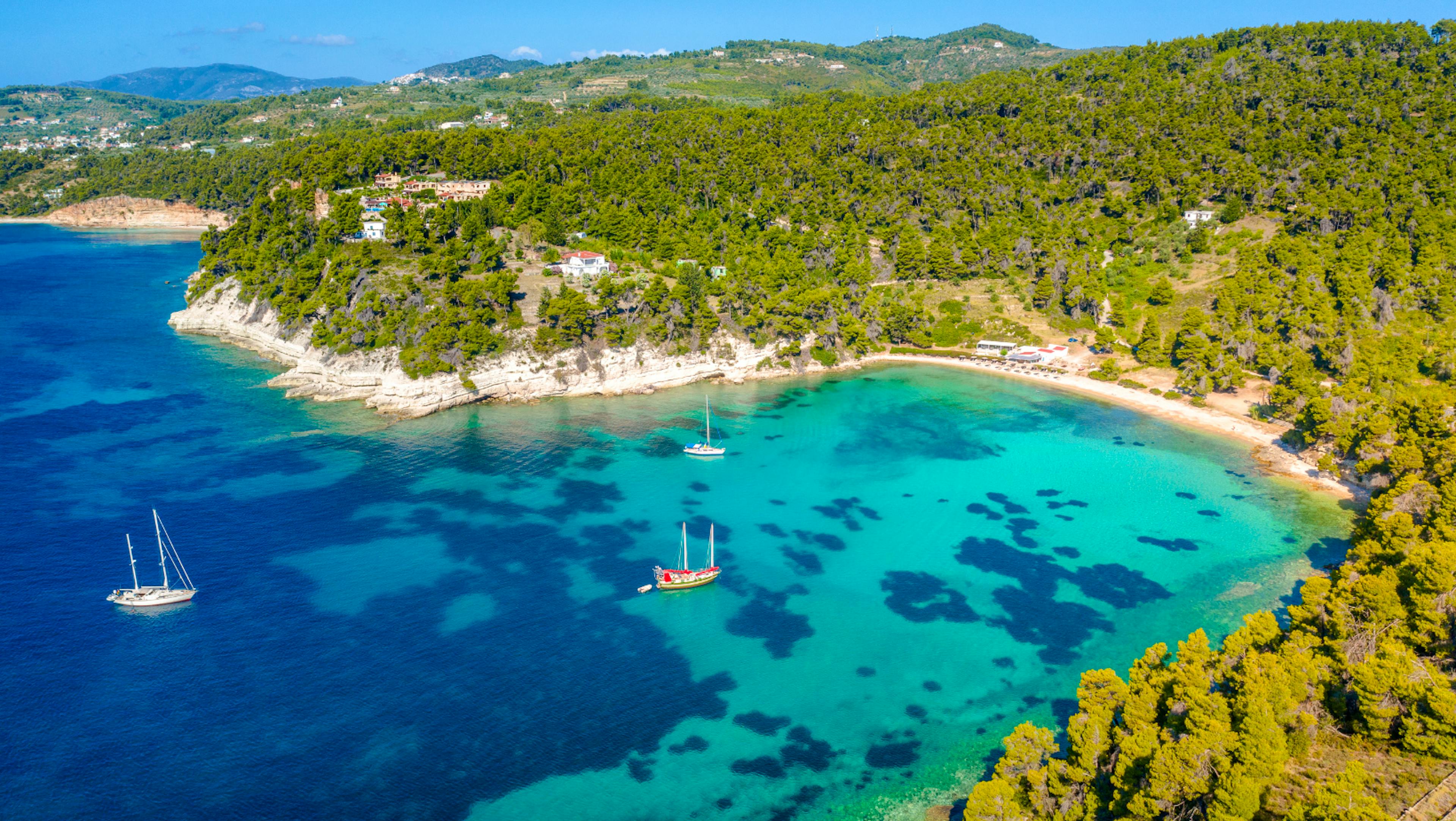
Segeln in den Sporaden: Ein 7 Tage Törn
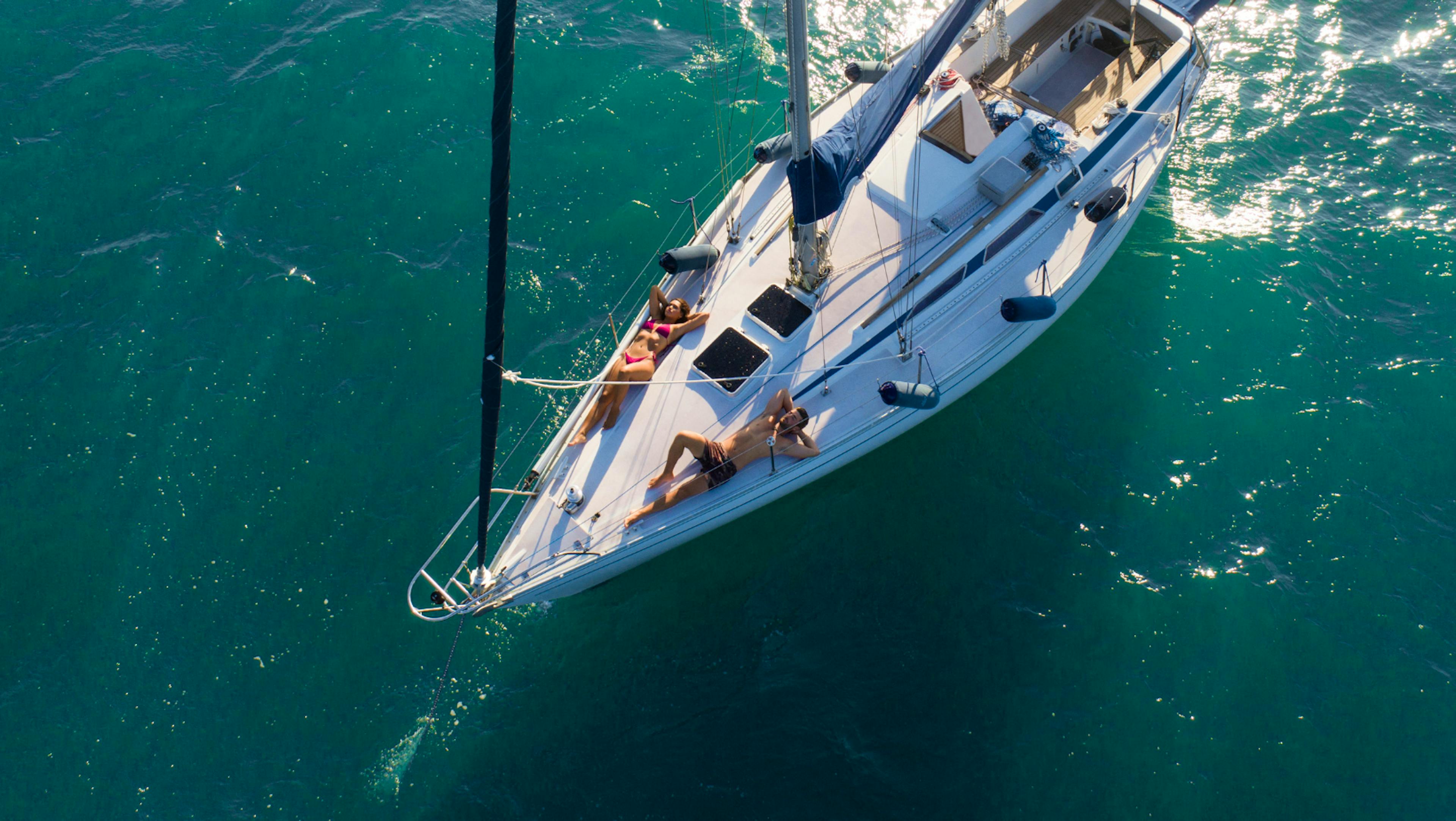
Wie man einen Segelurlaub organisiert
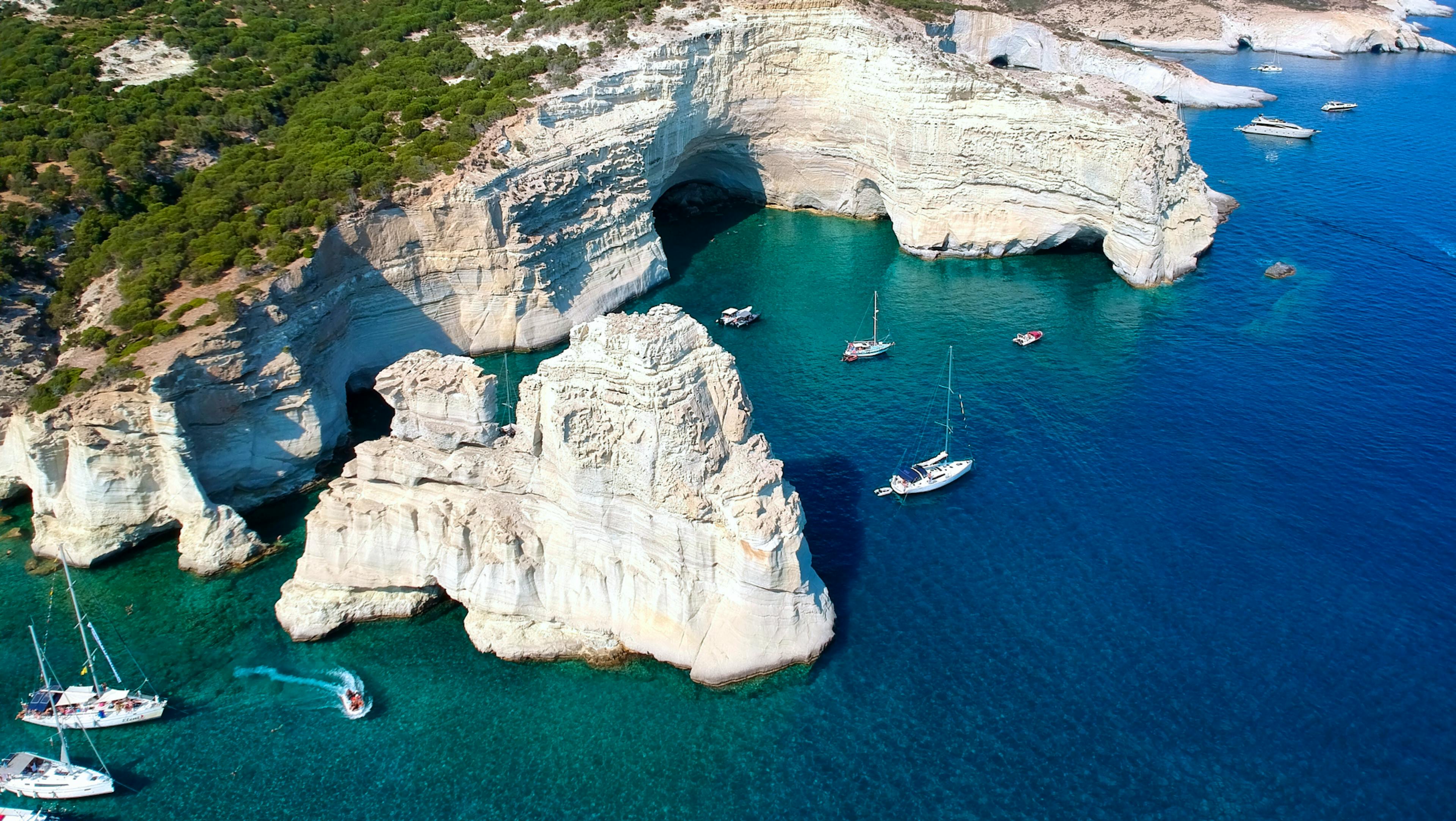
Törntipp Segeln in den Kykladen
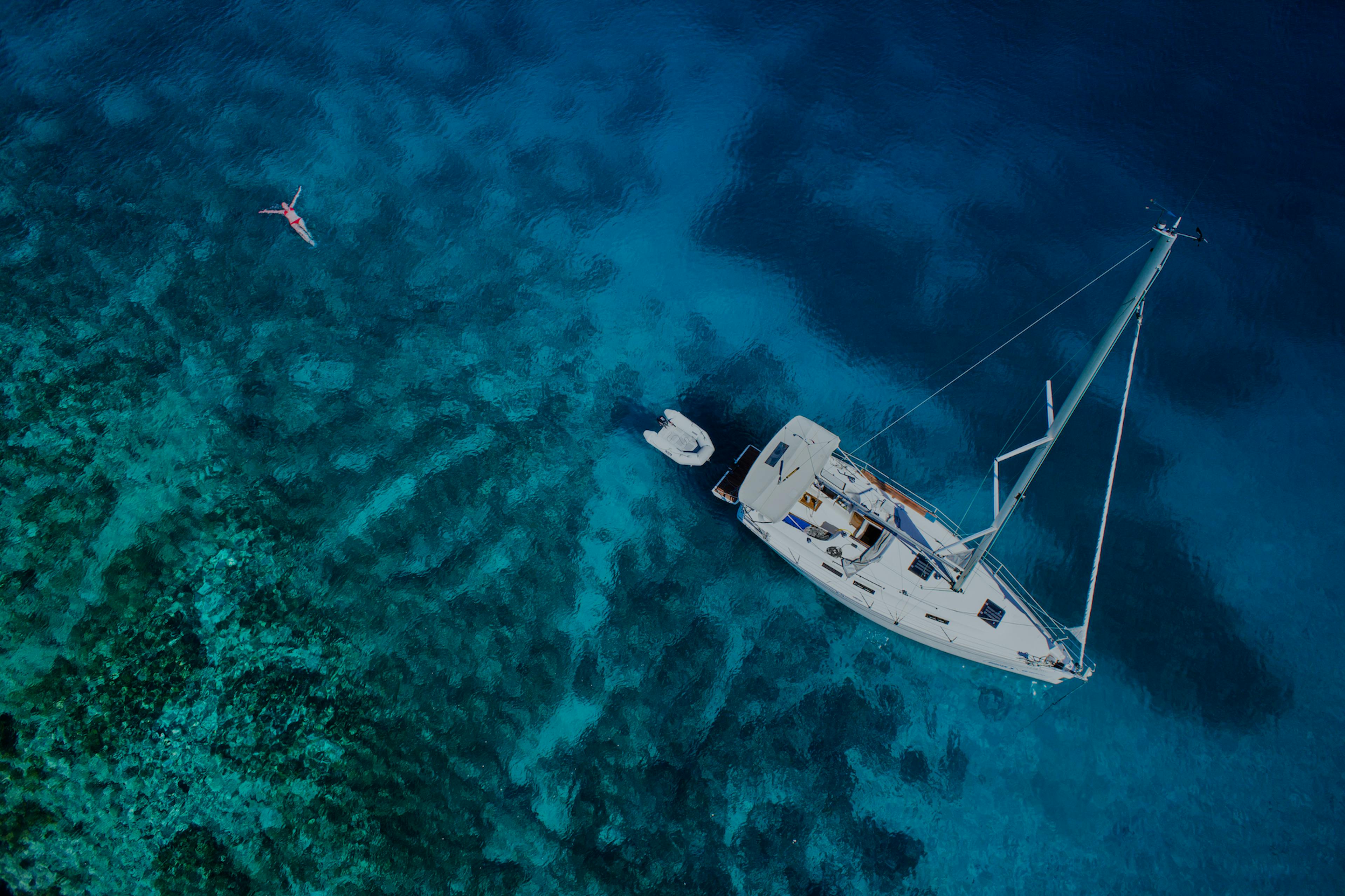
Stay in touch
New sailing magazine out now.
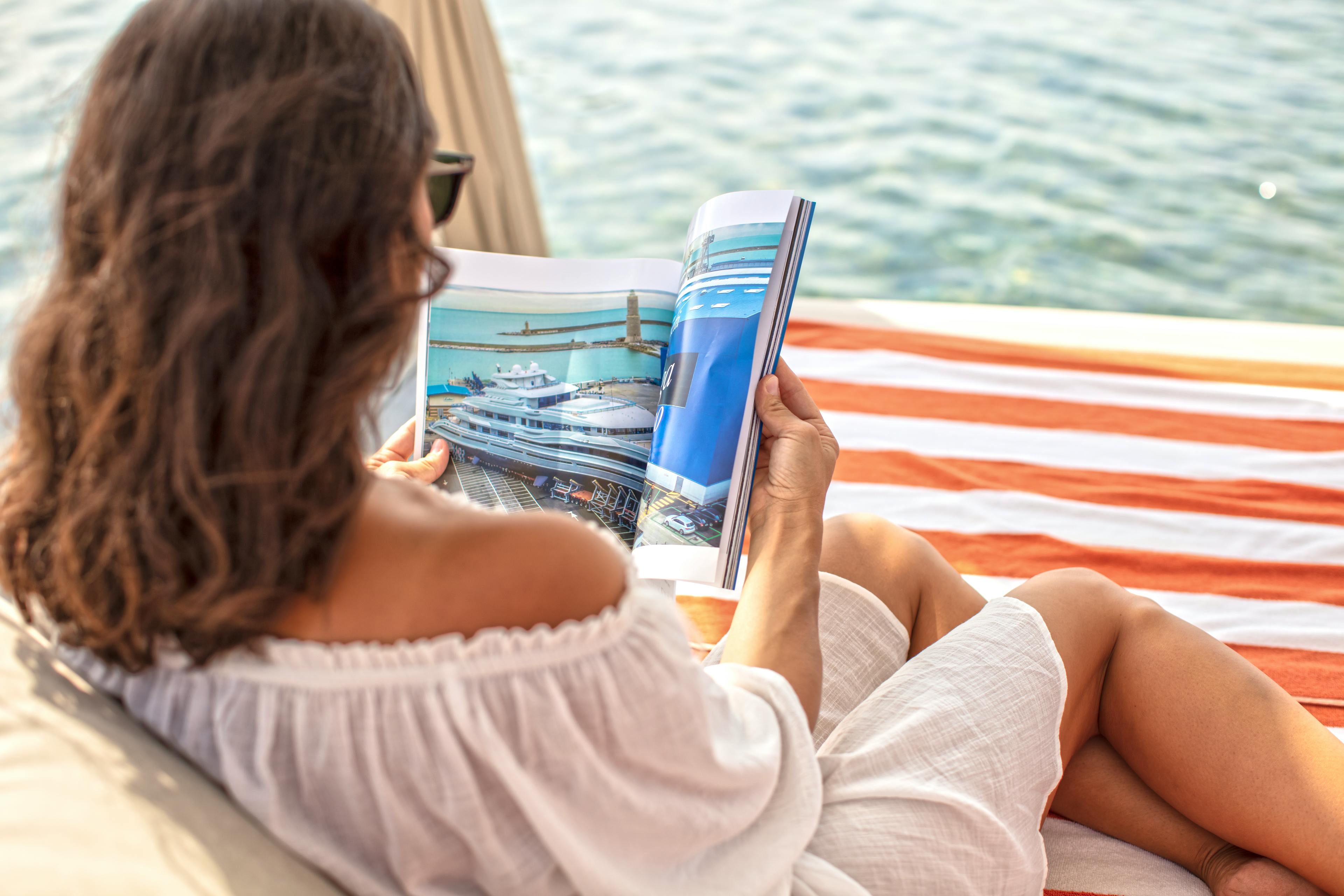
No products in the cart.
Sailing Ellidah is supported by our readers. Buying through our links may earn us an affiliate commission at no extra cost to you.
The Most Popular Types Of Sails On A Sailboat
A sloop-rigged sailboat typically features a mainsail, a headsail, and an additional light-wind sail, such as a spinnaker or Gennaker. The mainsail is rigged aft of the mast, while the headsail is attached to the forestay. The two most commonly used headsails are the Genoa and Jib.
The sails are vital parts of a sailboat since you obviously couldn’t sail without them! There are many different sails depending on the type of sailboat and its rig configuration, and we’ll walk through them together in this article.
The different types of sails on a sailboat
We can divide the selection of sails on a sailboat into three categories:
- Standard sails
Light-wind sails
- Storm sails
Each category serves different purposes depending on the vessel’s rig configuration and the sail’s functionality.
The standard sails
The standard sails usually form a sailboat’s basic sail plan and include :
- The Mainsail
- The Staysail
- The Mizzen sail
These sails are the ones that are used most frequently on sloop, ketch, and cutter-rigged sailboats and are usually set up to be ready to use quickly.
Headsails are often rolled up on a furler, while the main and mizzen sail are stored on the boom or furled into the mast.
The halyards and sheets are kept within easy reach, making these sails the primary choice in most situations. Let’s dive further into each of them.
The mainsail is a triangular sail that flies behind the mast on top of the boom . Although it may not always be the largest sail on the vessel, we commonly refer to it as “the main.”
It is a vital sail, and keeping the sail shape trimmed properly on every point of sail is crucial for the stability and performance of the boat.
A Jib sail is a headsail that does not overlap the mainsail. It is typically between 100% and 115% of the foretriangle but can also be smaller. The foretriangle is the triangular area formed by the mast, deck, and forestay. The Jib is often used with a self-tacking system involving a sheet traveler in front of the mast.
This sail is often seen on newer boats with fractional rigs, which typically have a larger mainsail area than the headsail area. However, the Jib is versatile and also used in other configurations.
People often mix the terms Genoa and Jib. Many refer to any headsail as a Jib, which is incorrect. I personally prefer to use the correct terms to avoid confusion .
A Genoa sail resembles a large Jib but extends past the mast and overlaps the mainsail. Genoas are usually larger than 115% of the foretriangle , with sizes ranging from 120% to 150%. They are often used on vessels with masthead rigs and smaller mainsails but are also common on fractional rigs.
The Staysail is typically found on cutter rigs and is set on the inner forestay or cutter stay. It can be combined with other sails, such as a Jib, Genoa, or Yankee, or on its own in stronger winds.
The Staysail is also useful when sailing downwind, as it can be paired with a headsail and extended to opposite sides of the boat using a pole.
The Yankee sail resembles a Genoa and Jib but has a high-cut clew. This shape allows for improved airflow when used with another headsail. The Yankee is often used on cutter-rigged boats in combination with a staysail and is known for its versatility in different wind conditions.
Mizzen Sail
A mizzen sail is similar to the mainsail, only smaller . It is set on the aft mast of a boat with multiple masts, such as a ketch rig. The mizzen sail is usually used to provide balance and stability to the vessel and provides additional power when sailing downwind.
Another handy usage is to fly the mizzen at anchor to keep the bow up against waves and swell.
The light-wind sails are large, made of thin nylon, and typically shaped like a half-balloon. They are a type of headsails that are great when the winds are too light to fill the standard headsail and are often used when sailing downwind.
The four most commonly used light-wind sails are:
- The Spinnaker
- The Gennaker
- The Code Zero
- The Parasailor
They all provide excellent forward propulsion on a sailboat but usually require some extra rigging to be set.
Experienced cruisers love to use light-wind sails in nice weather, but they have a critical weakness to be aware of. These sails easily get overpowered when the wind increases, and I strongly advise being careful and observant of the wind conditions when flying them.
(Yes, I have managed to rip mine on one occasion due to getting overpowered, but that’s a different story…)
Let’s continue and take a closer look at each of the light wind sails.
A Spinnaker sail is a large, lightweight downwind sail used at deep angles between 120 and 180 degrees. It is symmetrical in shape with two clews and is often brightly colored.
The Spinnaker is set by using a pole to extend the sail’s clew to the vessel’s side. Then, a sheet is attached to the other clew and led back to the stern of the boat.
A Gennaker sail combines the characteristics of the Genoa and Spinnaker. It is made of nylon like the Spinnaker but is asymmetrical like a Genoa and rigged slightly differently. The tack is attached to the bow, and the clew has a sheet led aft to the cockpit. The Gennaker can be equipped with a snuffer to make it even easier to set up and take down.
It is popular among cruisers because it is simpler to use than a spinnaker and it doesn’t require a pole. The sail is effective at angles between 90 degrees and almost all the way down to 180 degrees, making it versatile for various light-wind conditions.
A Parasailor is similar to the Spinnaker in many aspects but has some distinct differences. It has a double-layer wing that inflates as the sail is filled with air, creating a batten-like effect pushing the leech out while providing lift to the bow.
The wing also helps to prevent the rolling movements you get with a Spinnaker and the collapsing of the leech that can occur with a Gennaker at deep angles.
This makes the parasailor effective at sailing angles between 70 and 180 degrees dead downwind. Parasailors can be set like a Gennaker when reaching or with a pole like the Spinnaker for running downwind.
A Code Zero sail combines some elements of the Genoa and Gennaker. Unlike the Gennaker, the Code Zero has a different shape, allowing it to be used while sailing upwind.
Another benefit is that it can be used with a furler which makes it easy to roll in and out. However, it can’t replace the Gennaker or Spinnaker entirely, as it is not effective at sailing angles deeper than 120 degrees.
If you see a big yacht with three forestay’s, the forward one probably holds a code zero sail. A bow spirit allows the ability to fly additional light wind sails as well!
Storm Sails
The storm sails consist of a small Mainsail and Jib in heavy-duty materials designed for rough conditions. These sails enable us to maintain speed and stability in the boat in severe weather too strong for the standard sails.
Storm sails are often brightly colored , such as red, orange, or yellow, to make them more visible at sea.
Storm Mainsail
A storm mainsail is used when the reefing setup doesn’t allow the standard mainsail area to be reduced enough to prevent overpowering. The sail can handle rough conditions and is excellent for maintaining stability.
A storm Jib is used when the headsail has been furled to the point where it is no longer effective. It is especially useful for sailboats rigged with a Genoa, as the Genoa gets inefficient when heavily reefed. As the storm Jib is smaller than the standard headsail, it also lowers the center of gravity, making the vessel heel less and become more stable.
Explaining the terms for the parts of a sail
Let us talk some more about sails. The goal is to go sailing, right?
Identifying the different parts of the sails is crucial to understanding which lines go where.
Let’s zoom in on a sail and break down the terms :
The head is the top corner of the sail . Most mainsails have a headboard or plate where the halyard is connected, while headsails use a metal ring. A halyard is a line we use to raise and lower sails with.
The leech is the aft part of a sail , located between the clew and head. We use a combination of the outhaul, main sheet, and traveler to trim and adjust the leech on the mainsail.
The headsail’s leech is trimmed by adjusting sheet tension and angle according to the wind speed and direction. A traveler is a track with a movable car or pulley system for adjusting the position and angle of a sheet, and most sailboats have one main traveler for the mainsail and car tracks along the side decks for the headsail.
The luff of a sail is the front part of the sail between the tack and head. On a mainsail, the luff runs vertically along the mast and along or close to the forestay on a headsail. Headsails are often equipped with luff foam to help maintain their shape when partially reefed on a furler.
Battens are slats or tubes inserted into pockets on the mainsail to help the sail maintain its shape and increase its lifespan . A traditional sail hoisted and lowered on the boom typically has horizontal battens. Vessels with in-mast furling can use vertical battens instead of horizontal ones.
- A fully battened Mainsail has the battens run through the entire sail length from the luff to the leech.
- A standard battened main sail has the battens along the sail’s leech.
Telltales are small ropes, bands, or flags attached to a sail to give an indication of the airflow around the sail. They help us understand how the wind affects the sail and allow us to fine-tune the trim for optimal performance. Telltales are usually found on the mainsail’s leech and in the front of the headsail’s leech.
The clew of a sail is the lower aft corner and where the outhaul is connected on a mainsail. Headsails have sheets attached to their clew for controlling and trimming the shape and tension.
The tack is the lower, forward corner of a sail. On a traditional Mainsail, the tack is attached to the Gooseneck, a hinge in front of the boom attached to the mast.
With in-mast furling, the tack is connected to the furling mechanism. This mechanism is used to roll the sail into the mast.
The headsails tack is connected to a furler drum on the forestay on most sailboats. Vessels using traditional hank-on headsails connect the tack to a fixed point on the bow.
The foot of the mainsail is the bottom portion of the sail between the clew and the tack. It is trimmed using the outhaul, a line attached to the clew, and used to adjust the tension on the foot of the sail. Some mainsail are configured loose-footed, and others are attach-footed.
The foot of the headsail is trimmed by adjusting the tension and angle of the sheets, which are the lines used to control the headsail’s clew. We use cars, or pulleys, to adjust the angle of the sheets and thus the trim of the headsail.
Traditional and less commonly seen sails
We’ve now looked at the most commonly used sails and walked through the different parts of them. But what about the less common ones? The art of sailing has a rich history, with some unique sail designs that we rarely see today.
Read on if you want to peek into some traditional sails, or skip straight to popular sail and mast configurations here.
Square sails
Square sails are rectangular and usually set across a ship’s mast, mostly seen on traditional square-rigged sailing ships and Viking ships. These sails are efficient for downwind sailing and are hung from horizontal spars called yards. Though not as agile as modern fore-and-aft sails when sailing upwind, they were central to naval exploration for centuries. Today, they’re mainly seen on traditional vessels and tall ships, symbolizing maritime heritage.
If you’ve been to Martinique in the summer, you may also have noticed the round skiff sailboats the local fishermen traditionally used for fishing in the Atlantic Ocean with their distinctive big squared sails. Tour de Martinique des Yoles Rondes is a popular yearly event where the locals race and show off these beautiful old boats with colorful sails!
A gaff sail is a traditional four-sided sail held up by a horizontal spar called the “gaff.” They are used on classic gaff-rigged sailboats and allow for a larger sail area with a shorter mast. Gaff-rigged boats were traditionally popular and usually carried 25% more sail area than the equivalent Bermudan rig, making them fast on a downwind run. The Gaff rig could also carry a topsail between the gaff and the mast.
However, they don’t sail well to windward, and modern designs have shifted towards triangular sails for better upwind performance.
Jib-headed topsail
The Jib-headed topsail is a small triangular sail used on gaff rigs and is set between the gaff and the top of the mast.
A lug sail is an angled, four-sided sail that attaches at a point on its top side, making it hang tilted. The sail is simple to use and often found on smaller or older boats. There are different types, like standing, dipping, and balance lugs, each hanging differently around the mast.
The lug sail evolved from the square sail to improve how close the vessels could sail into the wind. Because of their upwind performance, fishermen used them widely in Europe from the seventeenth through the nineteenth centuries.
Sprit sails
The spritsail, with its unique four-sided design, stands out thanks to a diagonal support called the “sprit.” It was traditionally popular in Thames sailing barges due to its ability to accommodate high-deck cargo. These days, it’s primarily found in smaller boats like the Optimist dinghy in a variant called “leg of mutton spritsail.”
The spritsail was also used in traditional wooden boats like the fearing version of the Oselvar wooden boat traditionally used in western Norway.
It is also commonly used by the indigenous Guna Yala tribes in Panama in their dugout Ulu’s up to this day. We saw plenty of them when we cruised along the coast, and some of them approached us to sell us their delicious catch of the day!
Lateen sails
A lateen sail is a triangular sail set on a long spar angled on the mast. It was originally popular in the Mediterranean and on Arab shows, and its design enhanced maneuverability and played a crucial role in historic sea exploration.
The lateen sail was used on lateen rigs, the predecessor to the Bermuda rig – one of today’s most commonly used rigs!
Which brings us to the following topic:
Popular sail and mast configurations
There are many different rigs and sail configurations between sailing vessels. From the old-school square rigs to schooners, gaff rigs, and more. However, this article will focus on the three most popular rigs seen on modern sailboats:
- The Bermuda Sloop Rig
- The Cutter Rig
- The Ketch Rig
The three rigs have similarities and differences between their sail and mast configurations. We’ll walk through each of them to understand how they utilize their different types of sail.
If you want to learn more about other rigs, take a look here .
Bermuda Sloop Rig
The Bermuda sloop rig is the most common rig on modern vessels. It is characterized by a single mast, a triangular mainsail, and a headsail. This rig is named after the Bermuda Islands, where it was developed in the 17th century.
Some of the key features of the Bermuda sloop rig:
- The mast is typically tall and raked, which allows for a large sail area and excellent stabilit y.
- The mainsail is attached to the mast and boom. It is usually combined with a single headsail at the front of the boat, making it powerful and easy to sail.
- The Sloop is usually equipped with a masthead or fractional rig and flies a Jib or Genoa as its primary headsail.
The Bermuda Sloop rig is known for its simplicity, is often used for racing and cruising, and is popular among sailors worldwide.
The cutter rig is very similar to the sloop rig. The significant difference is that it has a single mast and two headsails – a Staysail and a Yankee. The cutter rig is known for its versatility due to the multiple options in sail plans and the double headsail setup.
Some key aspects that separate the Cutter from the Sloop:
- The rig is often more robust than its Sloop sister because of the additional cutter stay and running backstays.
- The mast is located closer to the center of the boat.
- The Cutter has a staysail on the inner forestay and a Yankee sail on the outer. The sails can be used in combination with each other or independently.
- Tacking the headsail between the forestay and cutter stay is more involved than on a sloop.
- The Cutter rig has two similar variations: the Slutter rig and the Solent rig.
Like the Sloop, the Cutter rig is relatively easy to operate. Still, the additional headsail and rigging make it costlier to maintain. It is also less suitable for racing than the Sloop, but the added versatility helps in different weather conditions and makes it an excellent choice for cruisers.
The ketch rig is also similar to the Sloop but has an additional mizzen mast placed further aft of the main mast. Another mast gives it the advantage of even higher versatility in sail plans. The ketch typically uses three sails. The mizzen sail, a mainsail, and a headsail. The mizzen mast also allows it to fly a second light-wind sail.
Here are a few more distinctions of the ketch rig:
- The ketch typically carries a smaller mainsail than a similarly sized sloop and a smaller mizzen sail.
- A small mizzen and a medium mainsail are easier to handle than one large mainsail.
- The additional mizzen sail makes the vessel easy to balance and gives extra stability downwind.
- The ketch usually doesn’t point as close to the wind as the Sloop and Cutter.
The headsail setup on a ketch is generally the same as for the Sloop. But the ketch can also be rigged as a cutter ketch, which gives it the benefits of the cutter rig! The tradeoff with a cutter-rigged ketch is the higher complexity and additional rigging, hardware, and sails required.
Final words
Well done, you now have a good grasp of the most common sails and their strengths. We have discussed a few rigs and how they utilize different kinds of sails in various sail plans. Remember that more sail types, other rigs, and even more variations are available. It is a complex topic, but this guide covers the basics and gives you a great starting point.
If you still have questions, look below at the FAQ, or leave me a comment. I’m more than happy to help you out!
A sailboat is only as good as its sails, and sails need wind to work. The next logical step is learning how the wind works when we sail and practicing some wind awareness! Head to the following guide to continue your research: Learn The Difference Between True And Apparent Wind Speed.
FAQ: The Different Types of Sails On A Sailboat
What is the foretriangle on a sailboat.
The foretriangle on a sailboat refers to the triangular area formed between the mast, forestay, and deck. If you want to order a new headsail, for example, you’ll have to measure and supply the sailmaker with these details.
What is the difference between a loose-footed and attached-footed mainsail?
A loose-footed mainsail is attached to the boom only at its corners, leaving the rest of the sail’s bottom edge free. An attached-footed mainsail, on the other hand, is secured to the boom along its entire length. The main difference lies in how the bottom of the sail connects to the boom, with the loose-footed design offering more adjustability in the sail shape.
What is a high-cut clew on a sail?
A high-cut clew refers to the design of a foresail, such as a jib or genoa, where the back lower corner (the clew) is raised or “cut” higher above the deck compared to standard designs. This design allows for better visibility beneath the sail and makes it easier to sail over waves without the sail touching the water, which is especially beneficial for offshore or blue-water cruising. Very high-cut clews are commonly seen on yankee sails on cutter-rigged sailboats.
What is luff foam on a sail?
Luff foam is a padded strip sewn into the forward edge of roller furling sails. It ensures the sail is appropriately shaped when partially rolled up, especially in strong winds. This foam not only helps with sail performance but also protects the sail when it’s furled.
What are the most common sails?
The sloop rig sailboat is the most common and usually features a mainsail, a headsail, and an additional light-wind sail, such as a spinnaker or Gennaker.
What are the different types of sails?
There are several different types of sails, and we can divide the most common into three categories:
The standard sails:
- Mizzen sail
The light-wind sails
The storm sails:
- Storm mainsail
- Storm jib
What is a spinnaker sail?
A Spinnaker sail is a large, lightweight downwind sail used at deep angles between 120 and 180 degrees.
What is a Jib sail?
A Jib sail is a headsail that does not overlap the mainsail and is set on the forestay. The Jib can also be set up with a self-tacking system, making it very effective when sailing into the wind.
Is Genoa sail the same as a jib?
People often mix the terms Genoa and Jib. The Genoa is different from a Jib sail as it is larger and overlaps the mainsail, whereas the Jib is smaller and does not overlap the mainsail.
What is a Genoa sail?
A Genoa is a headsail larger than the Jib extending past the mast and overlapping the mainsail. The advantage over the Jib is the larger sail area, making it more effective when sailing off the wind.
How many types of sail plans are there?
Sail plans refer to the configuration and arrangement of sails on a boat or ship. While there are countless customizations and variations, the three most common sail plans are:
Sloop: Characterized by a single mast, a triangular mainsail, and a headsail.
Cutter: Similar to a sloop but has a single mast and carries two or more headsails.
Ketch: Features two masts, with the aft mast (called the mizzen) shorter than the main mast.
What is a Mainsail?
The mainsail is a triangular sail that flies behind the mast on top of the boom.
What is a Gennaker?
A gennaker is basically an asymmetrical spinnaker. A hybrid sail that combines the characteristics of a Genoa and a Spinnaker, designed for sailing off the wind and often used in light to moderate wind conditions.
What is a Storm Jib?
A storm jib is a small, heavy-duty sail used in strong winds or stormy conditions. It is commonly used when the headsail has been furled to the point where it is no longer effective.
What factors determine the type of sail to be used?
The type of sail to be used depends on various factors such as wind conditions, points of sail, sailboat size , and sailing experience. It’s smart to choose the appropriate sail for optimal performance. A Jib, for example, will be more effective than a Genoa while sailing to windward, and vice versa.
How do sails affect the performance of a sailboat?
Sails are the engine of a sailboat. Their design, size, and trim influence the boat’s speed, direction, and stability. Properly adjusted sails capture wind efficiently, allowing the boat to move faster and in the desired direction.
The balance and condition of the sails also impact comfort and safety, with well-maintained sails ensuring optimal performance. The sails are essential in determining how a sailboat performs in various wind conditions.
Sharing is caring!
Skipper, Electrician and ROV Pilot
Robin is the founder and owner of Sailing Ellidah and has been living on his sailboat since 2019. He is currently on a journey to sail around the world and is passionate about writing his story and helpful content to inspire others who share his interest in sailing.
Your article gave me a lot of inspiration, I hope you can explain your point of view in more detail, because I have some doubts, thank you.
What specifically do you want my point of view on?
Leave a Reply Cancel reply
Your email address will not be published. Required fields are marked *
- English (UK)
- English (AU)
- English (US)
- Lietuviškai
- Slovenščina
Travel Itineraries
Sailing destinations.
- Tips from us
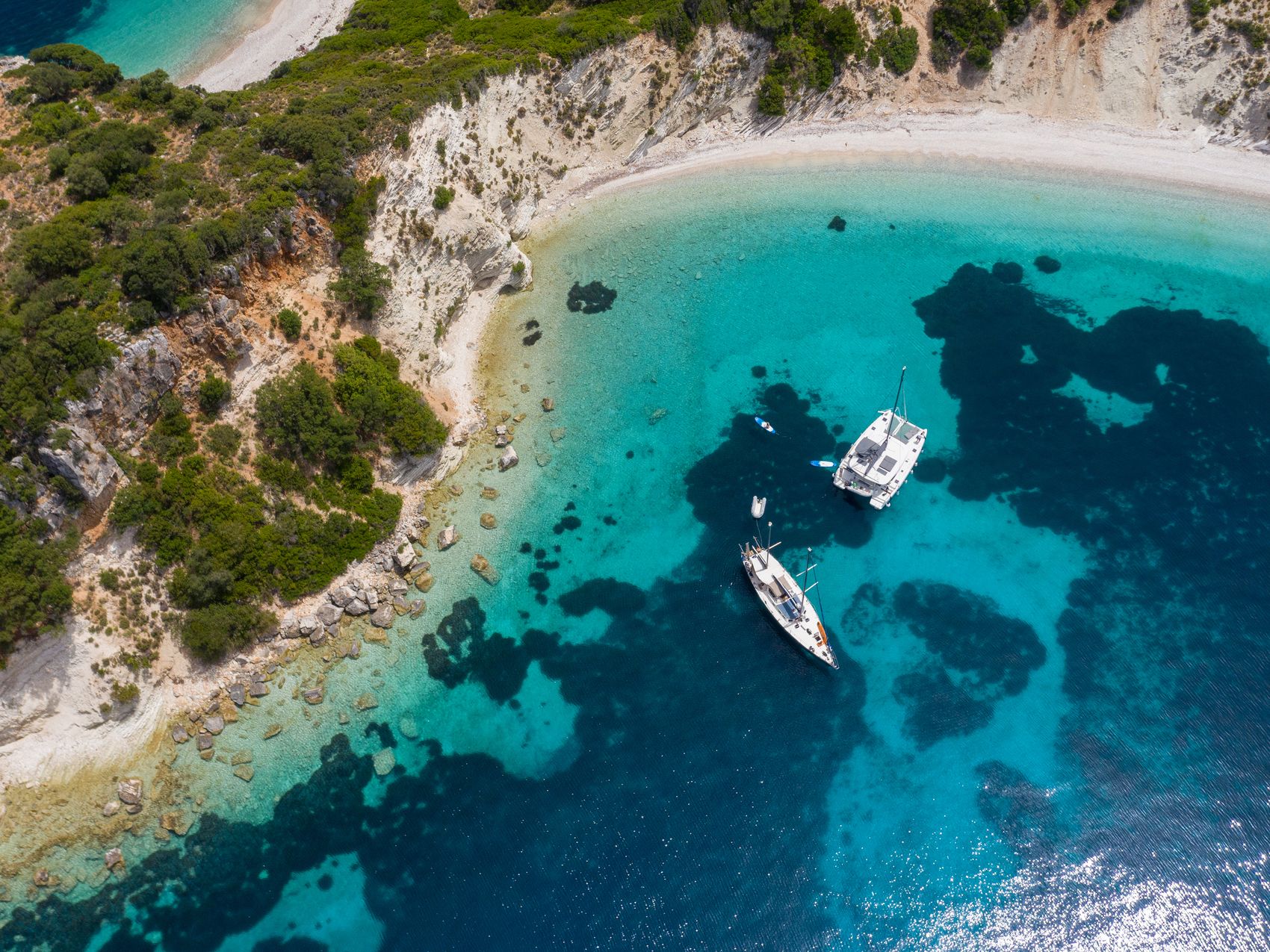
- Catamaran vs. Sailboat – Which one to choose?
A frequently discussed topic among sailors is what type of boat to choose for the next adventure. Should you go for a classic sailing yacht, catamaran or motorboat? Which boat is better? Each vessel can provide you with an unforgettable experience. It is impossible to say that a catamaran is better than a sailboat and vice versa. The question is, rather, what do you want, what are your needs, abilities and budget
Proponents of monohulls love the typical wobbliness of these boats and the authentic sailing experience that they convey. On the contrary, fans of catamarans praise their luxurious spaciousness and stability. Both teams are right.
Let’s take a closer look at the differences between monohulls - such as sailboats and multihull boats - such as catamarans . For a better comparison, we will focus only on boats with sails. There are also multi-hull motor boats (power catamarans), three-hull boats (trimarans), or single-hull motor yachts and boats. Let’s compare charter sailboats and catamarans based on their handling, equipment, comfort, safety in different conditions and routes, and, last but not least, the price.
What is the difference between a sailing yacht and a catamaran?
Let's start with the basics. Sailing yachts are typically monohulls that are propelled by sails and have a single keel that runs along the bottom of the hull.
Discover the latest review of the Bavaria 46, one of the most popular sailboats
Catamarans have two hulls that are connected by a bridge. Catamarans are generally wider, more stable, and more spacious than sailing yachts, making them a popular choice among families and groups of friends looking for recreational boats.
Discover the latest review of the Lagoon 450F, one of the most popular catamarans
Handling and manoeuvring.
The catamaran consists of two hulls, twin engines and two rudders. Sails are similar to those on the sailboat. Due to a short keel, the catamaran has a shallow draft. The construction of the catamaran makes it move faster and, above all, with better stability than a monohull vessel. The experience of real sailing on a catamaran is impoverished by typical heeling and swaying. The catamaran will neither rock you from side to side nor tilt as it happens on a sailboat. But some crews can consider this as their big advantage. On the other hand, sometimes a catamaran has a tendency to slap on the water.
On the other hand, the sailboat has a long keel and a triangular shape, thanks to which it slices through the water with less effort. The typical movement of the ship is rocking and heeling.
The speed of both vessels also depends on the direction of the wind. When sailing downwind , catamarans usually achieve greater speed than sailboats. Sailboats, on the other hand, perform better when sailing upwind . During turns, sailboats are better manoeuvrable and respond to a helm better, while catamarans lose the necessary impulse for a prompt turn faster.
Unlike a sailboat, a catamaran is practically unsinkable . However, from a physics point of view, it is easier to capsize a catamaran, although the probability of this happening is relatively low, and the boat stays afloat, providing a haven for the crew.
The limit of positive stability (or angle of vanishing stability), which can make the boat capsize, is considerably smaller in the case of a catamaran than in the case of a sailboat. A catamaran is not able to self-right. A strong gust of wind or a wave can tilt the sailboat over when heeled to a more than 90-degree angle (the keel of the boat protrudes above the surface), and it can still be able to return to its normal position by itself. Therefore, a sailboat works more smoothly in waves than a catamaran. However, large and breaking waves are equally dangerous for both types of boats, and you must sail perpendicular to the direction of the waves in such conditions.
Docking and anchoring
Although a catamaran may seem more difficult to park at first glance due to its more massive appearance, the parking manoeuvre is surprisingly easier than with sailboats. You are able to turn the catamaran 360 degrees on the spot. This is not possible to perform with a sailboat. The catamaran is equipped with two engines that can be controlled independently. The disadvantage of the catamaran’s robustness is that it often takes up 1.5 - 2 times more space in the marina than a similarly long sailboat. Especially in peak season, finding a place to dock can be difficult.
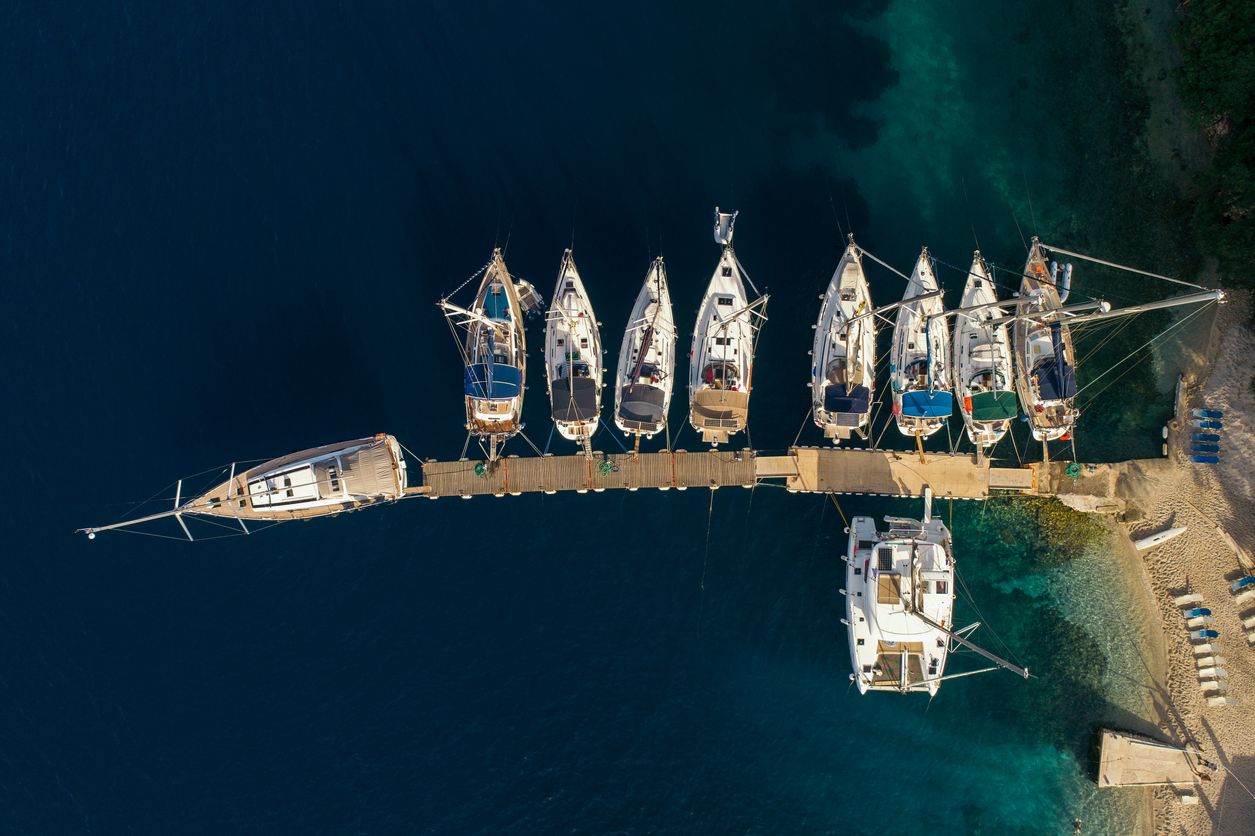
On the contrary, anchoring a catamaran can seem more complicated, at least at the beginning. If you are chartering a catamaran for the first time, be sure to inquire about the anchoring system when taking over the boat. When anchoring the catamaran, you need a bridle rope with a carabiner, which you tie to both the bows and the anchor chain in the middle. The anchor is then centred and the position of the rope prevents damage to the hulls from the chain.
The indisputable advantage of anchoring with a catamaran is its low draft. The absence of a very long keel allows you to drop the anchor even in shallow bays and closer to the shore, where you would not be able to stay with a sailboat.
A catamaran is definitely more comfortable . Both for the captain and the crew. It is more spacious and calmer during sailing. If you have a crew that often suffers from seasickness, such members usually feel better on the catamaran. Take in mind that a catamaran has its specific movements as well, and they may not suit everyone’s stomach either. Under the same conditions, you can chase mugs in the kitchen and wipe up spilt coffee on a sailboat, and on a catamaran, you can at most "complain" about boredom during the cruise.
During a gust of waves, the crew on the sailboat gets wet immediately; on the catamaran, you can hide and stay dry. Even such a detail as staying dry can uplift the crew’s mood during adverse weather conditions.
Catamarans are more often equipped with automatic winches. You don’t work so hard manually as you do on a sailboat. Working with the sails is also less demanding, and you have clear instructions for reefing the sails with regular charter catamarans.
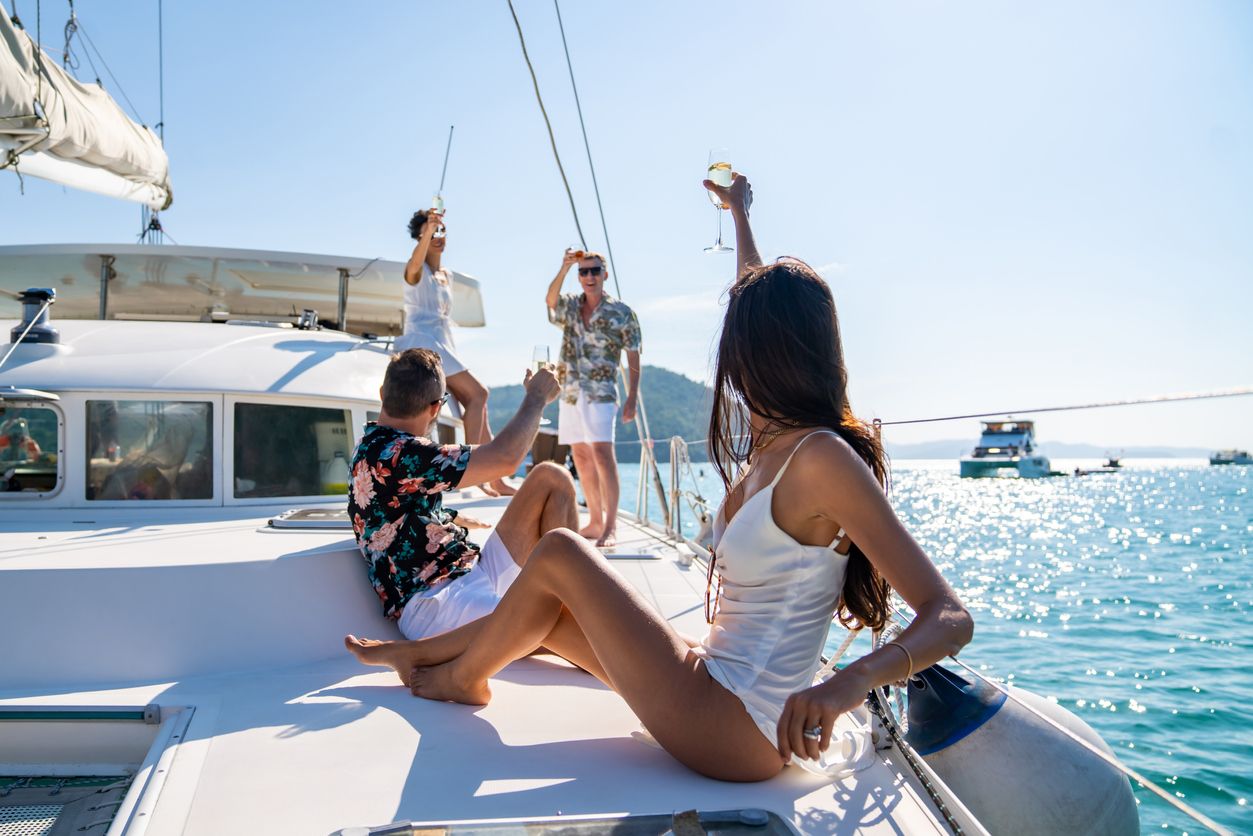
You will appreciate the catamaran more on hot summer days. Air circulation is much better on catamarans. The view from inside the boat is more beautiful from the catamaran because the living part of the deck of the catamaran is located above the water level. You won’t see much from the saloon in the sailboat. As for the view of the ship itself, most sailors enjoy the sight of elegant and well built, agile sailboats more than of multihull "bulldozers" on the water.
Safety depends not so much on the type of vessel as on other factors - the age and state of the ship, the weather and the human element. If we talk about the safety of staying and moving on the boat itself, a catamaran is definitely a safer place for children and the elderly.
In extreme conditions, a monohull is more wobbly on the water and often a bit safer because a sailboat can take care of itself. It can "dance" in big waves more smoothly and independently than a catamaran. The captain needs clear correction and control in strong winds and high waves.
It is true that if you capsize a sailboat , it has the ability to self-right. When you capsize a catamaran, only the towing service will help you. However, once you’re in a situation where even your sailboat almost capsizes, chances are you’re already in huge trouble anyway.
Do catamarans flip easily?
The largest modern catamarans exhibit impressive buoyancy and outstanding resistance to rolling. This ensures that capsizes or inversions are unlikely to occur. When faced with 30-foot breaking waves, the boat gracefully sways from side to side.
You can enjoy long routes in greater comfort and with a longer period of self-sufficiency on catamarans. These are usually equipped with solar panels for electricity production, desalinators for obtaining drinking water and generous storage space.
A catamaran is more expensive than a sailboat of similar size. In addition, you will pay extra for parking fees in marinas and city piers, for entering national parks and sometimes for fuel. The price often wins as a decisive argument when choosing a charter boat. Although the price difference may not be negligible, a catamaran’s additional benefits (higher comfort, stability and spaciousness) often compensate for the higher price.
An example of a comparison of rental fleet prices: renting a catamaran Lagoon 42 from 2019 with a length of about 13 meters (6 cabins) will cost you about 480 euros per day; alternatively, renting a sailboat Jeanneau Sun Oddysey from 2019 with a length of about 13 meters (5 cabins) and with a bow thruster can cost from 200 euros per day. The price may vary depending on the month and discounts from the charter company.
How much does a sailboat cost?
Sailboat prices are different, but it is possible to get some idea of the price if we study markets and use several examples. The cost of cruising boats is usually €250,000 or less. The price of a new boat typically ranges between €100,000 and €1,000,000. The value of a used sailboat varies based on its size and year of manufacture, usually between €10,000 and €100,000.

If you long for a real experience of authentic sailing, you want to enjoy the heel and feel the wind in your hair, then a sailboat is an obvious choice. A sailboat will also be a better option if you plan to reach less accessible, narrow, and capacity-limited places where maneuvering a large catamaran could be problematic. A sailing yacht won’t hurt your wallet as much as a catamaran.
If you don’t like the adrenaline rush of sport sailing, you prefer bigger living space, and especially if you have children on board, you will fall in love with a catamaran. When choosing a catamaran over a sailboat, enthusiasts of diving and other water activities that require storing bulky items will also be grateful.
If you don’t want to lose the charm of yachting while sailing on a sailboat, but you are worried about the wobbly movement tendencies, for instance, while docking in a marina, choose a sailboat equipped with a bow thruster for easier maneuvering.
What type of boat is better for a novice captain?
We recommend building practice first on a classic sailing yacht (monohull) for novice captains. You need to get enough feel for maneuvering the ship as such. A robust, comfortable, and stable catamaran will forgive many mistakes under normal conditions. Even a novice crew can be trained better on a sailboat - a catamaran "spoils" the crew more quickly.
An old sailor’s proverb says, “a smooth sea never made a skilled sailor” . So, if you are still at the beginning of your captain’s journey, a similar rule also applies when choosing a vessel :)
So, what is the best deal for your next yacht charter vacation? Whether a catamaran or a sailboat, a multihull or a monohull is better, there is no winner or a loser. Each vessel has different advantages and disadvantages. Very important aspects of life on a boat are a good captain, a friendly and capable crew and favorable conditions for sailing. Although we cannot guarantee this at Boataround, we are here for you when choosing a specific boat.
At the end of the day, the choice is yours:

What’s The Difference Between a Sailboat and a Schooner? Here’s What You Need To Know

Have you ever wondered what the difference is between a sailboat and a schooner? If youre curious about the key features that make these two vessels different, youve come to the right place.
In this article, well cover the key differences between a sailboat and a schooner, including the types of vessels used for sailing, the masts and hulls that set them apart, and the pros and cons of each vessel.
After reading this article, youll be able to make an informed decision on which vessel is better suited for your needs.
So, lets get started!
Table of Contents
Short Answer
A sailboat is a type of boat that is powered by wind energy using sails mounted to masts.
Schooners are a type of sailboat that typically have two or more masts, with the aft mast taller than the forward mast.
Schooners typically have more sail area compared to a typical sailboat, which enables them to travel faster and farther with the same wind.
Additionally, schooners often have a longer hull than a typical sailboat, which also helps with speed and stability.
Types of Vessels Used for Sailing
When it comes to sailing, there are two types of vessels most commonly used: sailboats and schooners. Each type of vessel has its own unique characteristics that make it well-suited for certain activities. Sailboats are typically smaller and more maneuverable than schooners, making them ideal for racing or recreational sailing. On the other hand, schooners are larger and more suited for carrying cargo, making them ideal for fishing, freighting, and other commercial activities. Both types of vessels can be used for cruising and exploring, but their differences in design and operation make them better suited for different purposes.
Sailboats utilize a single hull and one or two masts to generate power.
The masts hold sails which, when filled with wind, propel the boat forward.
Sailboats come in a variety of shapes and sizes, from small dinghies to large racing yachts.
They are designed for speed and performance, and typically require a smaller crew than a schooner.
Schooners have a double hull and usually two or more masts.
They are larger and heavier than sailboats, making them better-suited for carrying cargo or heavy loads.
Schooners are more difficult to maneuver than sailboats, requiring a larger crew to manage the sails and rudders.
They are often used for fishing, freighting, and other commercial activities.
In conclusion, sailboats and schooners are two types of vessels used for sailing.
Sailboats are typically smaller and more maneuverable, while schooners are larger and better suited for carrying cargo.
Sailboats are designed for speed and performance, while schooners are more difficult to maneuver and require a larger crew.
Knowing the differences between these two types of vessels will help you choose the one that best suits your needs.
The Key Difference

When it comes to sailing, it is important to understand the key difference between a sailboat and a schooner.
While both types of vessels are used for sailing, they have some distinct differences.
A sailboat typically has one or two masts and a single hull.
This hull design is more streamlined and allows for a greater speed and maneuverability.
Schooners, on the other hand, usually have two or more masts and a double hull.
The double hull makes it easier to carry cargo, but it also makes the vessel more difficult to maneuver.
Another key difference between sailboats and schooners is the purpose for which they are designed.
Sailboats are typically designed for speed and performance, while schooners are more suited for carrying cargo.
This is due in part to the double hull design of the schooner, which makes it easier to carry more weight.
Finally, sailboats are easier to maneuver and require a smaller crew, while schooners require more crew and are more difficult to maneuver.
This is due to the increased complexity of the schooner’s design and the additional masts.
Additionally, the double hull of the schooner makes it harder to move quickly and efficiently.
In conclusion, sailboats and schooners are both types of vessels used for sailing, but they have some key differences.
A sailboat typically has one or two masts and a single hull, while a schooner usually has two or more masts and a double hull.
Additionally, sailboats are typically designed for speed and performance, while schooners are more suited for carrying cargo.
Understanding these differences is essential for anyone interested in sailing.
Sailboats are an incredibly popular type of vessel used for sailing, and they come in many different shapes and sizes.
Generally speaking, sailboats are designed to be lightweight, maneuverable, and fast, with either one or two masts and a single hull.
Their hulls are usually designed with a deep keel to help them better track in the wind, and they typically feature a wide range of sails to help them reach their desired speed.
For those looking for a recreational sailboat, they come in a variety of sizes, such as small dinghies or larger vessels with multiple cabins.
Sailboats also come in a variety of styles, such as sloops, ketchs, yawls, and cutters, all of which feature different sail plans.
Modern sailboats are typically made from fiberglass, aluminum, or wood, and they are designed for performance and speed.
They usually have a wide range of features, such as self-tacking jibs, roller furling headsails, and spinnaker poles, which help them achieve their desired speed and performance.
Additionally, they are usually equipped with a variety of electronics, such as GPS systems, autopilots, and wind instruments, to make sailing easier and safer.

Schooners are larger, more imposing vessels than sailboats, and are usually designed for carrying cargo rather than achieving speed and performance.
They typically have two or more masts, and a double hull that allows for a greater carrying capacity than a sailboat.
Schooners are much more difficult to maneuver than sailboats, and require a larger crew due to their size and complexity.
They are also slower than sailboats, but their larger capacity and ability to carry more cargo makes them ideal for long-distance travel.
They have a long history, with the first schooners being built in the late 1600s, and have been used for fishing, trading, and as military vessels.
Today, schooners are still used for transporting cargo, as well as for pleasure cruising and racing.
Maneuverability and Crew Requirements
When it comes to maneuverability and crew requirements, sailboats and schooners differ significantly.
Sailboats are typically designed to be more agile and require fewer people to handle them.
This makes them easier to maneuver in tight spaces and more ideal for recreational sailing and racing.
Schooners, on the other hand, are larger and require more crew members to handle them effectively.
Schooners are more suited to carrying cargo and navigating larger bodies of water, such as the open ocean.
As a result, they are not as agile or as easy to maneuver as sailboats.
In terms of crew requirements, sailboats typically require just two people to operate them, while schooners can require up to five or more people to handle them.
This is due to the size and complexity of the schooners.
Additionally, schooners are much more difficult to maneuver, so they require more crew members to facilitate the process.
In short, the main difference between sailboats and schooners is in terms of maneuverability and crew requirements.
Additionally, sailboats are easier to maneuver and require a smaller crew, while schooners require more crew and are more difficult to maneuver.
Examples of Sailboats and Schooners

When it comes to sailboats and schooners, there are many types and varieties.
Sailboats come in a wide range of sizes, from small dinghies to large racing yachts, and they can be used for a variety of purposes, from recreational sailing to racing.
Common types of sailboats include sloops, catamarans, and monohulls.
Sloops are the most common type of sailboat, with one mast and a single hull.
Catamarans have two hulls and are typically designed for speed and performance, while monohulls are single-hulled vessels that are the most efficient when it comes to sailing.
Schooners are also a popular type of sailing vessel, and they come in a variety of sizes and designs.
Common types of schooners include gaff-rigged schooners, which have two or more masts and a double hull, and topsail schooners, which have two masts and a single hull.
Schooners are typically designed to carry cargo, and they are often used for commercial purposes, such as fishing or trading.
Additionally, schooners require more crew and are more difficult to maneuver than sailboats.
Pros and Cons of Sailboats vs. Schooners
When it comes to sailing, sailboats and schooners are two vessels that have some distinct differences.
While both are great vessels for sailing, each type has its own set of pros and cons.
For sailboats, the biggest advantage is their speed and performance.
They are designed to be lightweight and aerodynamic, allowing them to move quickly and efficiently through the water.
Additionally, sailboats are also much easier to maneuver than schooners.
They require less crew and are more responsive, making them better suited for recreational sailing.
On the other hand, schooners are better suited for carrying cargo.
They are usually larger and have two or more masts, with a double hull to provide additional stability.
This makes them a great option for transporting goods over long distances or in rough waters.
Schooners also typically require a larger crew than sailboats and can be more difficult to maneuver.
When it comes to deciding between a sailboat and a schooner, it really comes down to what you plan to use the vessel for.
If youre looking for speed and performance, a sailboat is the way to go.
If youre looking for a vessel to transport goods, a schooner is the better option.
Ultimately, its important to consider the pros and cons of each before making your decision.
Final Thoughts
Sailboats and schooners are both types of vessels used for sailing, but they have some key differences.
Sailboats are typically designed for speed and performance, while schooners are more suitable for carrying cargo.
Sailboats are easier to maneuver and require a smaller crew, while schooners require more crew and are more difficult to maneuver.
Knowing the differences between these two types of vessels can help you decide which type of boat is best for your needs.
Be sure to weigh the pros and cons of each type of boat before making your decision.
James Frami
At the age of 15, he and four other friends from his neighborhood constructed their first boat. He has been sailing for almost 30 years and has a wealth of knowledge that he wants to share with others.
Recent Posts
Does Your Boat License Expire? Here's What You Need to Know
Are you a boat owner looking to stay up-to-date on your license requirements? If so, youve come to the right place! In this article, well cover everything you need to know about boat license...
How to Put Skins on Your Boat in Sea of Thieves? (Complete Guide)
There is a unique sense of pride and accomplishment when you show off a boat you customized to your exact specifications. With Sea of Thieves, you can customize your boat to make it look like your...

Sailing vs. Cruising: Is There A Difference?

To you, one of the most relaxing things in life is gently riding the waters in your sailboat. You watch in awe as large sailboats glide by you, and maybe you’ve even seen a cruise boat or two in your time as well. That has you curious, is there any difference between sailing and cruising?
Sailing is typically a shorter-term maritime adventure in which you can reach your destination semi quickly. Compare that to cruising, where you’re on an extended trip going almost anywhere around the world. Since your stay is longer, cruise boats tend to offer more entertainment options than sailboats would.
In this article, we will dive deeper into the differences between sailing and cruising. If you’re having a hard time choosing between an expedition on a sailboat or a cruise ship, then this article is for you. Keep reading, as you won’t want to miss it!
What Is Sailing?
Before we can talk about the differences between sailing and cruising, we should explain both terms clearly. Let’s begin with sailing. When sailing, you would ride in a sailboat, obviously. Sailboats may use kites, wingsails, or traditional sails to travel through the water. The gentle force of the breeze propels the boat forward.
Sailing doesn’t have to occur exclusively on water. Land yachts can traverse land while iceboats are designed for crossing ice the way a sailboat would water. For the purpose of this article, though, we’ll talk about regular sailboats that do ride through bodies of water.
If you’re about to embark on a sailing expedition, then you’re typically going on a smaller boat with less of a crowd. You could have a few hundred people onboard, but it’s not an endless throng.
While modern sailboats can venture almost anywhere you can get to via water, sailing trips are typically not very long. Maybe it’s an afternoon adventure or an overnight voyage. Given that you’re not on the boat for days, there’s little need to provide a whole host of entertainment options. You might have food and drink and a few means of keeping yourself occupied, but nothing extensive.
That’s because, before you know it, you’ll have arrived at your destination. You’re then free to exit the sailboat and explore to your heart’s content until it’s time to get back on the boat and go home.
What Is Cruising?
You can also go cruising. Powerboats and even sailboats are sometimes used for cruising. These boats would have either a multihull or monohull design and be between 33 and 50 feet long. Yachts and cruise boats or ships can accommodate a much larger crowd than a powerboat.
When you go on a cruise, you should expect a trip that spans several days, maybe even a week or more. Instead of setting out for just one destination, a cruise typically takes you to many places in one trip. You can exit the cruise ship and spend time in each location, making the venture more worthwhile.
Since you’re on the ship for many days or weeks, cruises often have extensive entertainment. These include bingo and trivia at the very least to themed events, live productions, casinos, bars, fine dining, and shows. Riding on the ship is as much of an experience as is getting off and seeing new parts of the world.
As such a unique way to travel, it should come as no surprise that cruises attract large crowds, often more than a thousand people, sometimes several thousand.
What Are the Differences Between Sailing And Cruising?
Now that we’ve outlined the basics on sailing versus cruising, we want to share some of the differences between these two boating adventures.
Now, this one’s not universally true, but for the most part, cruise boats tend to outsize sailboats. We say it’s not universally true because, if you remember from the last section, sometimes sailboats can be used for cruising purposes. If it comes down to powerboats versus sailboats for cruising, most favor sailboats. That’s because powerboats tend to cost a lot of money, both to buy and to use, especially when traveling long distances on the ocean.
If we’re talking about a more traditional cruise ship or a yacht, though, then that’s going to be larger than even a pretty big sailboat.
As we said before, cruises will have bigger crowds. Many describe a sailing trip as something cozy and intimate. Sure, there’s still 100 or 200 people onboard with you, maybe even more. You won’t get to know everyone, but you can make friends easily enough due to proximity and crowd size.
On a cruise, you can expect several thousand more people than on a sailing trip, making the numbers quite significant. The biggest cruise boats can accommodate over 5,000 people, so it almost feels like living in a big town, just in closer quarters. The experience has much less of an intimate atmosphere.
Trip Length and Destinations
The key difference between sailing and cruising is that the latter lasts much longer. It’s like we said before, when you sail, you have one destination you’re heading for. It may take an afternoon to reach it, sometimes longer, but you’re never gone for upwards of a week. It’s a short trip: there, back, and then home.
On a cruise, you’re not limited to a single destination. You port at several places. Maybe you don’t get to spend as long there as you would have wished, but you can see many places during your trip. This takes time, though, so a cruise could last upwards of a week, maybe even two or three weeks in some instances.
You know the old saying that you get what you pay for, right? That’s the case when taking a maritime adventure as well. The shorter your trip, the less it tends to cost. The boat doesn’t venture out as far, thus it uses less fuel and other resources.
Longer trips often include more entertainment and accommodations (more on this momentarily), increasing the price. The type of boat you travel on, in this case a cruise ship or a yacht, can also contribute to the higher bill.
Entertainment and Accommodations
When you ride on a boat, you can’t rely on your smartphone to pass the time. Internet service can be spotty, as it’s not exactly like you’re close to any cell towers right? This may be okay if you’re riding a boat for a few hours, but once you get into overnight, even multi-day trips, you need something to do.
Even on a sailboat voyage, you’re not left to twiddle your thumbs. You could sip a drink or eat a meal with your fellow passengers and swap some stories. There may also be dancing, card games, and other entertainment, but it’s often on a much smaller and more inexpensive scale.
As far as accommodations, most sailboats have but one dining room. You don’t get an expansive menu because there’s just not as much room to prepare a multitude of tasty dishes.
That’s not a problem at all on a cruise. You can enjoy five-star dining and a wealth of meals to savor for breakfast, lunch, dinner, and dessert. You’ll eat like a king or a queen and love every minute of it.
You won’t ever spend a minute bored, either. As we said in the intro, cruises have all sorts of live shows and productions. The more upscale cruise ships even feature waterparks onboard.
If you have kids or you yourself are prone to boredom, you’ll never wonder what you’re going to do to keep yourself busy while on a cruise.
Stricter Schedule
While cruises do sound great, we want to reiterate that when you port, you get a certain amount of time off the ship and that’s it. If you’re not back in time, then the ship will take off without you. On a cruise, there’s a very strict schedule to follow.
Since you’re only going to one destination on a sailboat, there’s more room in the schedule for alterations. If someone’s late getting back on the boat or there’s a delay when porting, that’s okay.
Related Questions
Is it dangerous to sail in the caribbean.
Like many other places, sailing in the Caribbean is considered safe. You want to make sure you always lock up all your belongings when leaving your room or lounging quarters, though. Don’t carry around a lot of cash or valuables either. While there’s a low risk of being robbed on a cruise ship, it’s always better to be safe than sorry.
Can a yacht capsize?
As we’ve written on this topic before, no boat is capsize-proof. Click here to read our previous article on this topic. That goes for yachts as well. However, if you’re traveling on a commercial cruise ship or sailboat, then the captain will know ways to minimize the likelihood of capsizing. They’ll maintain weight distribution onboard, avoid strong winds, and heel without angling the boat too much to either side.
I am the owner of sailoradvice. I live in Birmingham, UK and love to sail with my wife and three boys throughout the year.
Recent Posts
How To Sail From The Great Lakes To The Ocean
It’s a feat in and of itself to sail to the Great Lakes. Now you want to take it one step further and reach the ocean, notably, the Atlantic Ocean. How do you chart a sailing course to get to the...
Can You Sail from the Great Lakes to the Gulf of Mexico by Boat? 
You have years of boating experience and consider yourself quite an accomplished sailor. Lately, you’ve been interested in challenging yourself and traveling greater distances than ever before. If...

The Ultimate Guide to Choosing Between a Sailboat or Catamaran for Your Sailing Adventures
C hoosing between a sailboat and a catamaran for your sailing adventures is a significant decision that depends on various factors, including your sailing preferences, experience level, budget, and intended use. Here's an ultimate guide to help you make an informed decision:
1. Sailing Experience:
- Sailboats: Typically require more skill and experience to handle, especially in adverse weather conditions. Ideal for sailors who enjoy the traditional feel of sailing and are willing to invest time in learning and mastering the art.
- Catamarans: Easier to handle, making them suitable for beginners. The dual-hull design provides stability, reducing the learning curve for those new to sailing.
2. Space and Comfort:
- Sailboats: Generally have a narrower beam and less living space. However, some sailboats may offer comfortable cabins and amenities.
- Catamarans: Wider beam creates more living space. Catamarans often have multiple cabins, spacious saloons, and expansive deck areas, providing a more comfortable living experience.
3. Stability:
- Sailboats: Monohulls can heel (lean) while sailing, which some sailors enjoy for the thrill but can be discomforting for others.
- Catamarans: Greater stability due to the dual hulls, providing a more level sailing experience. Reduced heeling makes catamarans suitable for those prone to seasickness.
4. Performance:
- Sailboats: Known for their upwind performance and ability to sail close to the wind. Some sailors appreciate the challenge of optimizing sail trim for efficiency.
- Catamarans: Faster on a reach and downwind due to their wide beam. However, they may not point as high into the wind as monohulls.
- Sailboats: Typically have a deeper draft, limiting access to shallow anchorages and requiring deeper marina berths.
- Catamarans: Shallow draft allows access to shallower waters and secluded anchorages, providing more flexibility in cruising destinations.
- Sailboats: Generally more affordable upfront, with a wide range of options available to fit different budgets.
- Catamarans: Often more expensive upfront due to their size and design. However, maintenance costs may be comparable or even lower in some cases.
7. Mooring and Docking:
- Sailboats: Easier to find slips and moorings in marinas designed for monohulls.
- Catamarans: Require wider slips and may have limited availability in certain marinas, especially in crowded anchorages.
8. Intended Use:
- Sailboats: Ideal for traditional sailors who enjoy the art of sailing, racing enthusiasts, or those on a tighter budget.
- Catamarans: Suited for those prioritizing comfort, stability, and spacious living areas, especially for long-term cruising and chartering.
9. Resale Value:
- Sailboats: Generally have a more established resale market, with a wider range of buyers.
- Catamarans: Growing in popularity, and well-maintained catamarans often retain their value.
10. Personal Preference:
- Consider your personal preferences, the type of sailing you plan to do, and the kind of lifestyle you want aboard your vessel.
In conclusion, both sailboats and catamarans have their advantages and disadvantages. Your decision should be based on your individual preferences, experience level, budget, and intended use. If possible, charter both types of vessels to experience firsthand how they handle and to help make a more informed decision based on your own preferences and needs.
The post The Ultimate Guide to Choosing Between a Sailboat or Catamaran for Your Sailing Adventures appeared first on Things That Make People Go Aww .

How a cargo ship took down Baltimore’s Key Bridge
To bridge experts, the collapse of Baltimore’s Francis Scott Key Bridge after being hit by a heavy cargo ship was as inevitable as it was devastating.
When a vessel as heavy as the Singapore-flagged Dali crashes with such force into one of the span’s supercolumns, or piers, the result is the type of catastrophic, and heartbreaking, chain reaction that took place early Tuesday.
“If the column is destroyed, basically the structure will fall down,” said Dan Frangopol, a bridge engineering and risk professor at Lehigh University in Pennsylvania who is president of the International Association for Bridge Maintenance and Safety. “It’s not possible to redistribute the loads. It was not designed for these things.”
No bridge pier could withstand being hit by a ship the size of the Dali, said Benjamin W. Schafer, a professor of civil and systems engineering at Johns Hopkins University.
“These container ships are so huge,” Schafer said. “That main span has two supports. You can’t take one away.” He called the accident “a huge infrastructure failure,” but not because of the bridge collapse; he said the shipping industry needs systems to keep a ship on track when it loses power, as the Dali did before the collision.
The bridge itself, which carried more than 30,000 vehicles daily, appeared to be structurally sound. Its condition was rated fair, according to data in the 2023 National Bridge Inventory maintained by the Federal Highway Administration. Maryland state officials said they were focused on search-and-rescue operations and did not provide later inspection data. National Transportation Safety Board Chair Jennifer Homendy said excavating detailed inspection history information — and what was done in response to any earlier findings — will be a cumbersome and protracted part of the agency’s investigation.
But bridge safety and engineering experts are emphasizing a separate issue: protective barriers.
When the span opened to traffic in 1977, many ships were smaller and the standards for protecting bridges against them were lower, they said.
A few years later, a Liberian cargo ship crashed into a bridge in Florida , sending a Greyhound bus, a pickup truck and six cars into the Tampa Bay and killing 35 people, according to the NTSB. That deadly 1980 collision helped lead to the adoption of stronger national standards for bridges, including protection from errant ships, in the years that followed, safety experts said.
Sherif El-Tawil, a professor of civil and environmental engineering at University of Michigan with expertise in bridges, said if the Key Bridge had been built after those updated standards from the American Association of State Highway and Transportation Officials were put in place, the span could still be standing.
“I believe it would have survived,” El-Tawil said.
Maryland officials did not answer questions Tuesday about what protective devices were in place near the bridge and whether they were sufficient to withstand this type of collision.
Two examples of protective measures that did not appear to have been in place, El-Tawil said, were large fenders designed to direct marine traffic away from the bridge supports and an island built around the pier.
Some states are building these kinds of protection systems around vital bridges. Last year, officials from a joint New Jersey and Delaware bridge authority announced work on eight 80-foot-wide, stone-filled cylinders designed to protect the Delaware Memorial Bridge. The existing protection for the bridge tower piers dates to 1951. “Today’s tankers and ships are bigger and faster than those of the 1950s and 1960s,” the officials said in announcing the nearly $93 million project.
State departments of transportation “are aware of the shortcomings of these bridges,” said Roberto T. Leon, a bridge and structural engineering professor at Virginia Tech. “It’s not that they don’t know. It’s a matter of prioritizing the repairs. It is a very expensive proposition to protect a bridge.”
Ian Firth, a British structural engineer and bridge designer, said he was “not surprised” at how quickly the bridge came down after it was hit. He noted that the support structure that was struck, which would have been made of reinforced concrete, was one of two main supports responsible for doing “all the work” to hold up the bridge.
He said the ship appeared to have strayed to one side before striking the bridge.
The bridge collapse, like other calamities, is probably the result of overlapping low-probability failures, said Edward Tenner, a historian and expert on disasters — akin to what happens when, by chance, the holes in a stack of Swiss cheese slices line up perfectly.
“This might have been a case where there were just an unlikely series of failures,” said Tenner, author of “Why Things Bite Back,” a book about technology and its unanticipated consequences. But he added, “I suspect there was something about the equipment of a huge ship like that, given the potential for damage like this, there should have been more redundancy. There shouldn’t have been one point of failure that could lead to a catastrophe.”
Speaking Tuesday afternoon in Baltimore, U.S. Transportation Secretary Pete Buttigieg called the accident “a unique circumstance,” adding, “I do not know of a bridge that has been constructed to withstand a direct impact from a vessel of this size.”
The ship was towed into the Patapsco River initially, but the tugboats did not accompany the ship all the way to the bridge, said John Konrad, a retired ship captain who runs the gCaptain maritime news website and co-authored a book on the Deepwater Horizon oil spill .
“The safe thing to do is keep the tugs,” Konrad said. “Moving forward, I think that’s going to happen. The Coast Guard is going to say you’ve got to keep the tugs tied up until you pass the bridge.”
In video imagery, the ship can be seen losing electrical power, then briefly regaining it before going completely dark. The ship then veers to the right, directly toward the bridge’s structural support.
The rudder may have gotten stuck in a position that caused the ship to turn, said a senior retired maritime official, who spoke on the condition of anonymity while waiting for more details on the incident. It’s also possible that an incoming tide could have been a factor, he said.
“Obviously, they could not control the ship. They could not stop the ship,” he said.
A deficiency in the Dali’s systems was discovered when the ship was inspected in June, records show. Inspectors at the port of San Antonio, Chile, discovered a problem categorized as relating to “propulsion and auxiliary machinery,” according to the Tokyo MOU, an intergovernmental shipping regulator in the Asia-Pacific region. The issue was classified in the subcategory of “Gauges, thermometers, etc,” but no additional details of the deficiency were provided. The problem was not serious enough to warrant detaining the ship, according to the records.
After a follow-up inspection later the same day, the Dali was found to have no outstanding deficiencies, the records show, indicating that the problem was addressed.
Maryland Gov. Wes Moore (D) said at a news conference Tuesday that the Dali lost power and issued an emergency call for help shortly before the freighter crashed into the bridge. The “mayday” distress call allowed officials to halt vehicle traffic headed over the bridge and saved lives, Moore said.
Erin Cox, Tom Jackman, Jon Swaine, Joyce Lee and Mark Johnson contributed to this report.
An earlier version of this article misstated the title of Edward Tenner's book. It is "Why Things Bite Back." This version has been corrected.
Baltimore bridge collapse
How it happened: Baltimore’s Francis Scott Key Bridge collapsed after being hit by a cargo ship . The container ship lost power shortly before hitting the bridge, Maryland Gov. Wes Moore (D) said. Video shows the bridge collapse in under 40 seconds.
Victims: Divers have recovered the bodies of two construction workers , officials said. They were fathers, husbands and hard workers . A mayday call from the ship prompted first responders to shut down traffic on the four-lane bridge, saving lives.
Economic impact: The collapse of the bridge severed ocean links to the Port of Baltimore, which provides about 20,000 jobs to the area . See how the collapse will disrupt the supply of cars, coal and other goods .
Rebuilding: The bridge, built in the 1970s , will probably take years and cost hundreds of millions of dollars to rebuild , experts said.


IMAGES
VIDEO
COMMENTS
Boating is a general term that is used to refer to a leisurely activity of traveling by boat. Whether it's for recreational use, fishing, or as a means of transportation, boating revolves around using various types of boats including sailboats, yachts, powerboats, and paddle or rowing boats. On the other hand, sailing revolves around relying on ...
Sailboats are powered by sails using the force of the wind. They are also referred to as sailing dinghies, boats, and yachts, depending on their size. Sailboats range in size, from lightweight dinghies like the Optimist dinghy (7'9") all the way up to mega yachts over 200 feet long. The length is often abbreviated as LOA (length overall), which ...
one mast. triangular mainsail (called a Bermuda sail) a foresail (also called the jib) fore-and-aft rigged. medium-sized (12 - 50 ft) Fore-and-aft rigged just means "from front to back". This type of rigging helps to sail upwind. Any sailboat with one mast and two sails could still be a sloop.
However, since the total sail area is distributed between multiple smaller sails forces on the boat are more equally dispersed and can be controlled and manipulated easier. This sail design can be especially handy when sailing short-handed as it means that sail trim and reefing are easier. Multiple masts also effect the boat design.
Foot - The bottom edge of the sail. Tack - Between the luff and the foot is the tack. The tack is attached to the boat or a spar. Head - The corner at the top of the sail between the luff and the leech. Clew - The third triangle of a sail between the leech and the foot. Batten - Solid slats or rods to help maintain the desired airfoil ...
In front of the main mast is called a foremast. The 5 most common two-masted rigs are: Lugger - two masts (mizzen), with lugsail (cross between gaff rig and lateen rig) on both masts. Yawl - two masts (mizzen), fore-and-aft rigged on both masts. Main mast much taller than mizzen.
Sailboat Shapes And Hull Types. Sailboat hulls differ in their total number and shape. They can be monohulls (one hull), catamarns (two hulls) and trimarans (three hulls). The shape of a sailboat not only changes the way it is commanded, but also how it performs on different points of sail and in different conditions.
Sailing Yacht vs Sailboat. The terms "sailing yacht" and "sailboat" are often used interchangeably, but there are some nuanced differences. While all sailing yachts are sailboats, not all sailboats are considered yachts as a yacht is classified as a vessel over 79ft. Sailing yachts are typically larger, more luxurious vessels, equipped ...
Contents show. Several factors determine the types of sailboats, including the hull type, keel type, mast configuration, and sails and rigging. The hull is the boat's body and can be either a monohull, catamaran, or trimaran. The keel is the underwater part of the hull that provides stability and can be either a fin keel, wing keel, bilge ...
Before that happens, it's essentially a displacement hull. 2. Plowing. While a boat with a planing hull is picking up speed and lifting itself out of the water, it's in a plowing mode. You'll know when a boat is in plowing mode when the bow of the boat is elevated and the boat is throwing a relatively large wake.
So, is there a difference between boating, yachting, and sailing? Yes. Boating is a general term that refers to using a boat on the water. There are many kinds of boats, such as sailboats, which can be used for sailing and yachts, which can be used for fishing, living in, and boating. So, while yachting and sailing are examples of boating ...
Many boaters use the terms "sailboat" and "yacht" interchangeably when they are actually quite distinct. A yacht is a larger boat or ship that is used for recreational purposes. The term "yacht" is of Dutch origin, and it was initially described as a small, swift sailing vessel used by the Dutch navy to track down and catch pirates. A boat, on the other hand, is a smaller vessel ...
Yachts and sailboats are both sail-powered vessels, but there are some key differences between them. Yachts are typically larger and more luxurious than sailboats, and often come with amenities like sleeping quarters, kitchens, and bathrooms. Sailboats are typically smaller and less luxurious than yachts, and are mainly used for leisure or sport.
In deciding between a sailboat and catamaran, there are several considerations to keep in mind. A catamaran is easier to sail and will provide a more spacious and luxurious experience. The sailboat, on the other hand, is more immersed in the water and provides a more realistic and exciting experience. It can be challenging knowing which boat is ...
The Main Difference: Sailboats are powered and propelled by the force of the wind against the sails Motorsailers are a hybrid and can be powered equally by the wind in its sails, as well as an internal engine Cost: You can buy a well-kept used sailboat is between $15,000- $40,000 and a new boat you have buy for $80,000 to $150,000 depending on ...
1. Stability: Sailboat: Embraces the classic elegance of a single hull, providing a responsive and traditional sailing experience. The tilting motion, counterbalanced by the daggerboard, adds a dynamic element to the journey. Catamaran: Boasts unparalleled stability with its two hulls, virtually eliminating the pronounced tilting effect.
The art of sailing lies in the symbiotic relationship between the sailor's expertise and the optimized design of the boat, which is tailored for speed and performance. Rowing: Embracing the Strength of the Oars Rowing. In contrast to sailing, rowing involves propelling a boat using oars.
A sloop-rigged sailboat typically features a mainsail, a headsail, and an additional light-wind sail, such as a spinnaker or Gennaker. The mainsail is rigged aft of the mast, while the headsail is attached to the forestay. The two most commonly used headsails are the Genoa and Jib. The sails are vital parts of a sailboat since you obviously ...
When sailing downwind, catamarans usually achieve greater speed than sailboats. Sailboats, on the other hand, perform better when sailing upwind. During turns, sailboats are better manoeuvrable and respond to a helm better, while catamarans lose the necessary impulse for a prompt turn faster. Unlike a sailboat, a catamaran is practically ...
Short Answer. A sailboat is a type of boat that is powered by wind energy using sails mounted to masts. Schooners are a type of sailboat that typically have two or more masts, with the aft mast taller than the forward mast.. Schooners typically have more sail area compared to a typical sailboat, which enables them to travel faster and farther with the same wind.
The key difference between sailing and cruising is that the latter lasts much longer. It's like we said before, when you sail, you have one destination you're heading for. It may take an afternoon to reach it, sometimes longer, but you're never gone for upwards of a week. It's a short trip: there, back, and then home.
3. Stability: Sailboats: Monohulls can heel (lean) while sailing, which some sailors enjoy for the thrill but can be discomforting for others. Catamarans: Greater stability due to the dual hulls ...
Baltimore bridge collapse. Baltimore's Francis Scott Key Bridge collapsed after being hit by a cargo ship, sending at least eight people from a construction crew into the water. Two people were ...